Hawaii Reef and Open Water species
1/104
There's no tags or description
Looks like no tags are added yet.
Name | Mastery | Learn | Test | Matching | Spaced |
|---|
No study sessions yet.
105 Terms

Member if the Chaetodontidae family
Diet includes sick and dying coral polyps (which they scrape out with thier mouth), nudibranchs, tubeworm tentacles, and can consume algae.
Shiny grey spot on head and 6 orange diagonal stripes on sides
Ornate Butterfly (Kikakapu)
Fun fact: adults almost always seen in monogamous pairs, mating for life
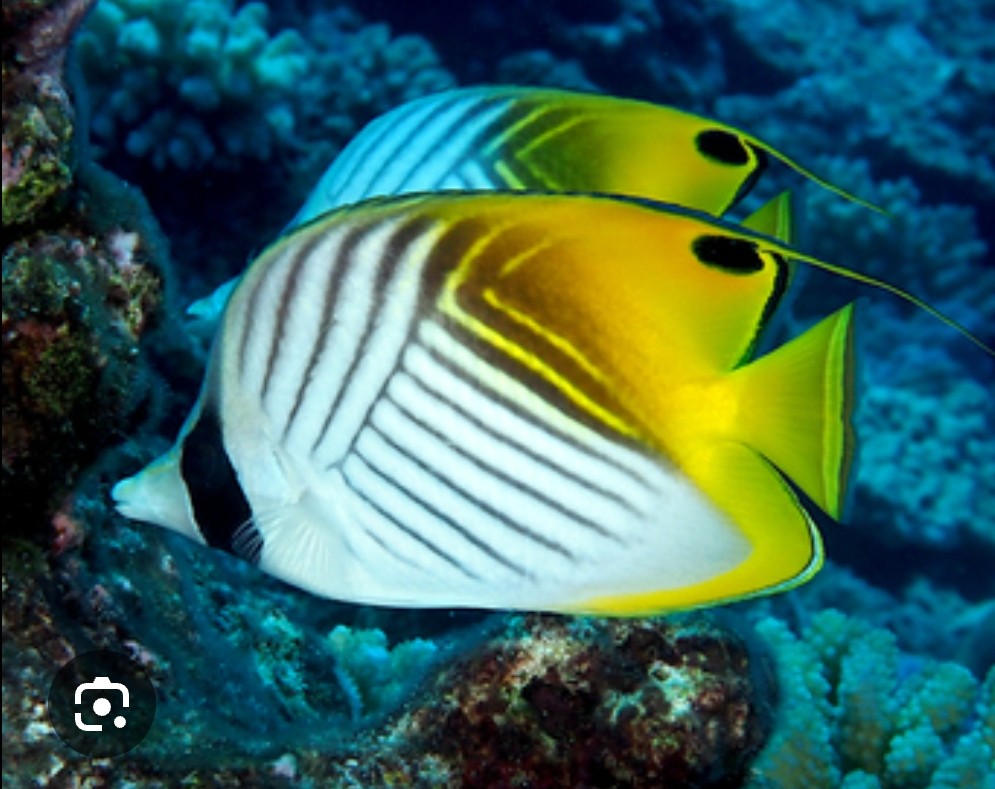
Chaetodontidae family
Diet includes coral polyps, anemones, crustaceans, worms, algae, and plankton
Distinct black eyespot on dorsal fin
Threadfin Butterfly (Lau Hau)
Fun fact: it uses a false eye spot near its tail to confuse predators about which end is its head
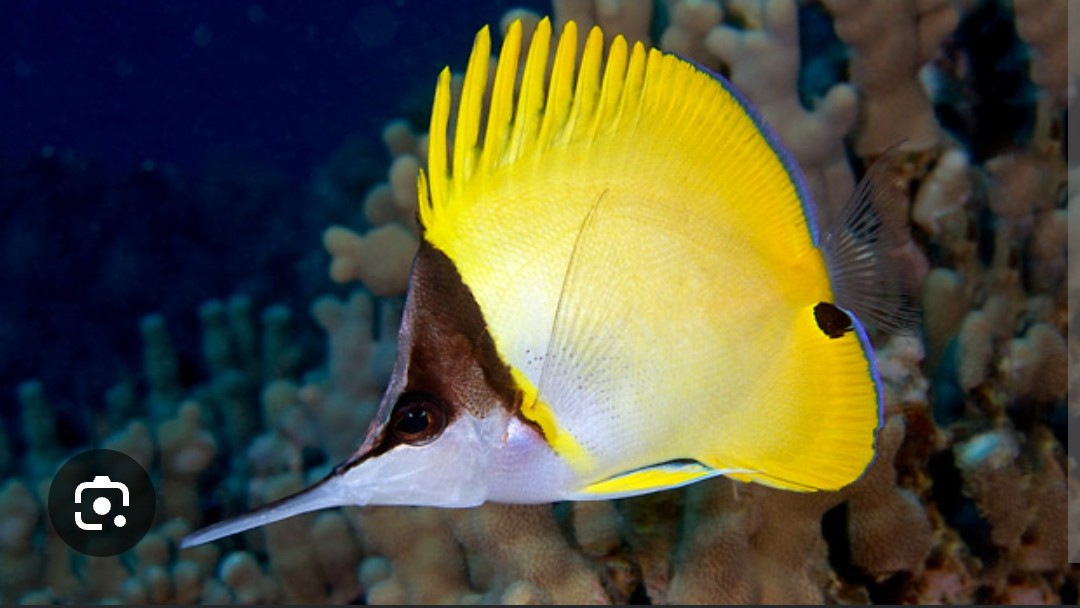
Chaetodontidae family
Long needle nose mouth, black eye spot under caudal fin, bright yellow fish
feeds on the tube feet of echinoderms, polychaete tentacles, the pedicellaria (the jaw-like structure) of sea urchins, fish eggs, small crustaceans and hydroids.
Yellow Longnose Butterfly (Lau Wiliwili-Nukunuku-Oioi)
Fun fact: it is a highly territorial fish that communicates with rivals using clicking sounds
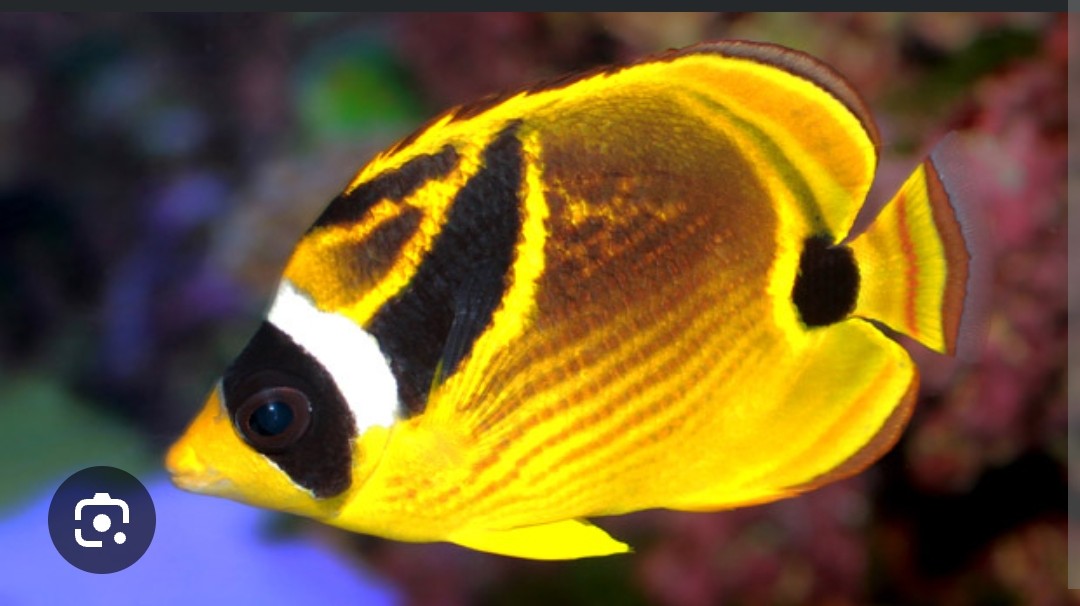
Chaetodontidae family
eat tubeworm tentacles, nudibranchs and other benthic invertebrates, maybe coral polyps and algae
Dark upper half, yellowish-orange underside, raccoon eye patches
Raccoon Butterfly (Kikakapu Kapuhili)
Fun fact: generally not aggressive toward other fish, except they’re not big fans of lionfish and triggerfish

Chaetodontidae family
Diet consists of coral polyp tissue, algae, supplemented with nudibranchs, as well as tubeworm tentacles and fish eggs.
Black tear drop on upper part of body, white belly to yellow back, black bar behind eye
Teardrop Butterfly (Kika Kapulauhau)
Fun fact: can be found as deep as 180 feet
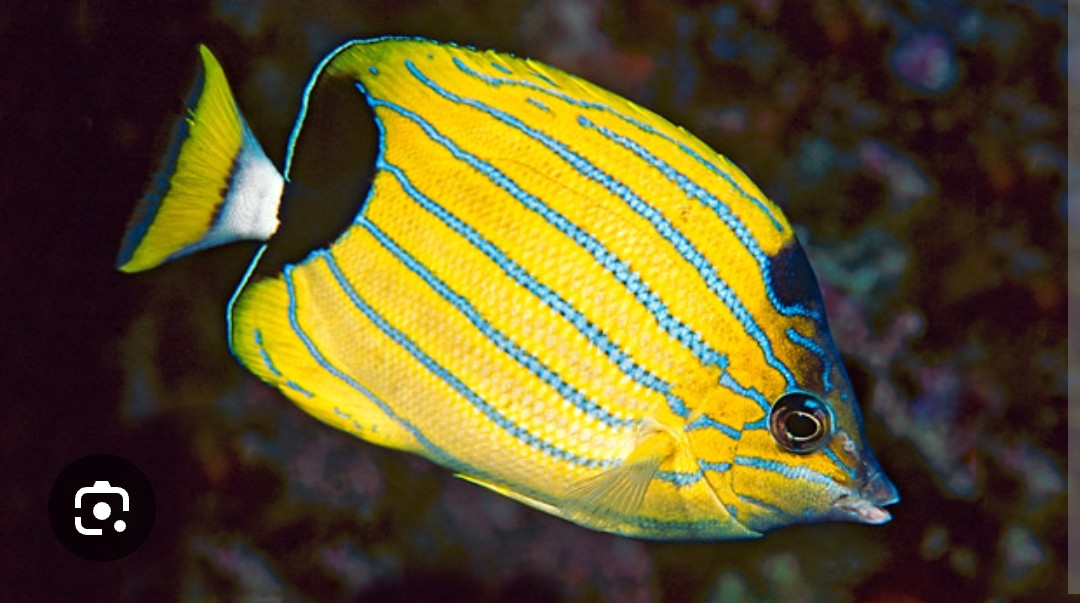
Chaetodontidae family
They feed on the tentacles of sessile invertebrates like feather duster worms and other benthic invertebrates, also coral polyps and small crustaceans
8 diagonal blue stripes and large dark spot near caudal fin
Bluestripe Butterfly
(Lau Hau)
Fun fact: rare and only found on Hawaiian Islands and can be found as deep as 600 feet
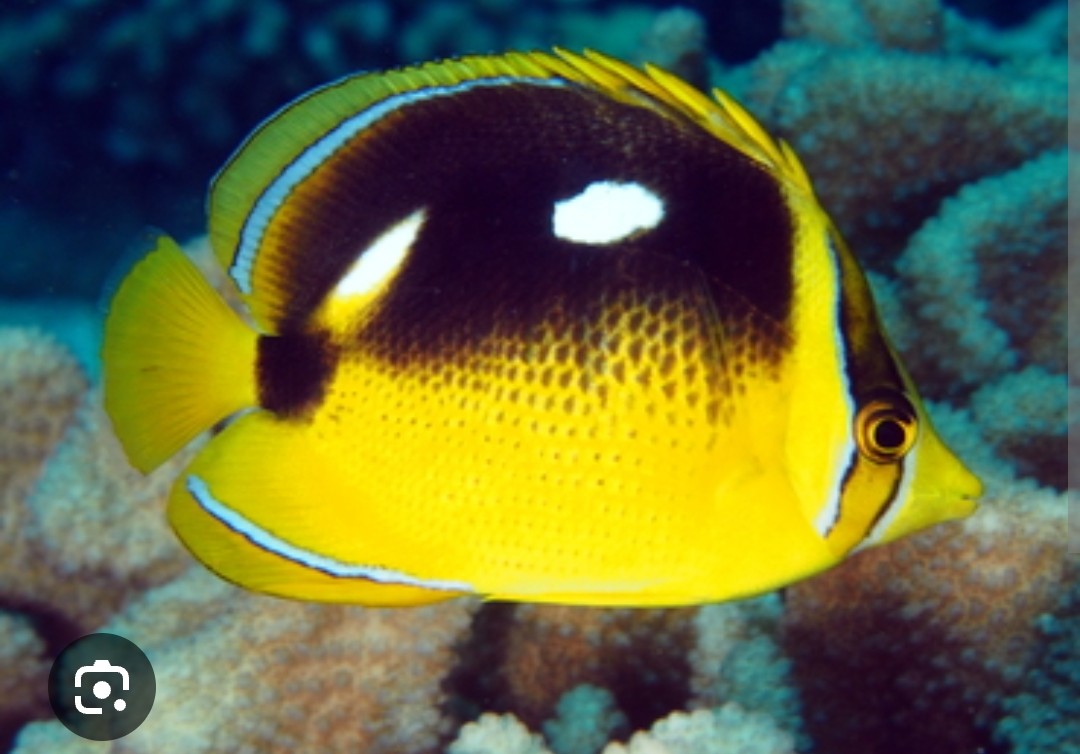
Chaetodontidae family
Feeds on small polyped stony corals, particularly Pocillopora; also invertebrates such as amphipods, peanut worms, and polychaete worms
Two white spots on upper part of body, bright yellow fish, large black spot near caudal fin, white strip along dorsal fin
Fourspot Butterfly (Lau Hau)
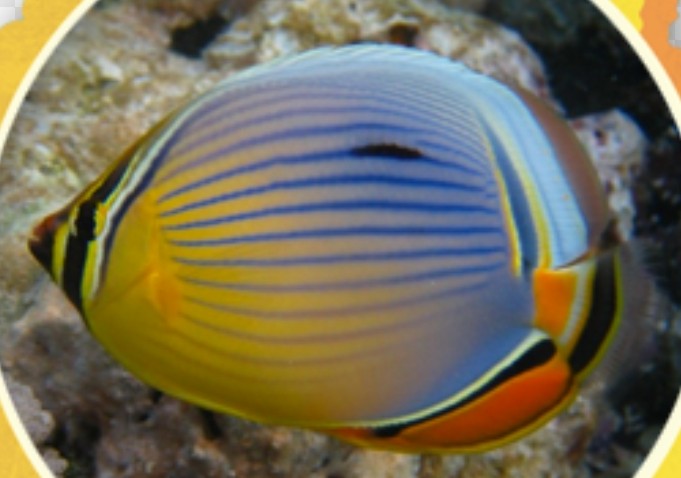
Chaetodontidae family
Primarily feeds on stony corals polyps but avoids coral overrun with algae
Orange/yellow towards face and fades to bluish purple towards tail, horizontal stripes along body, orange anal fin
Rainbow Butterfly
(Lau Hau)
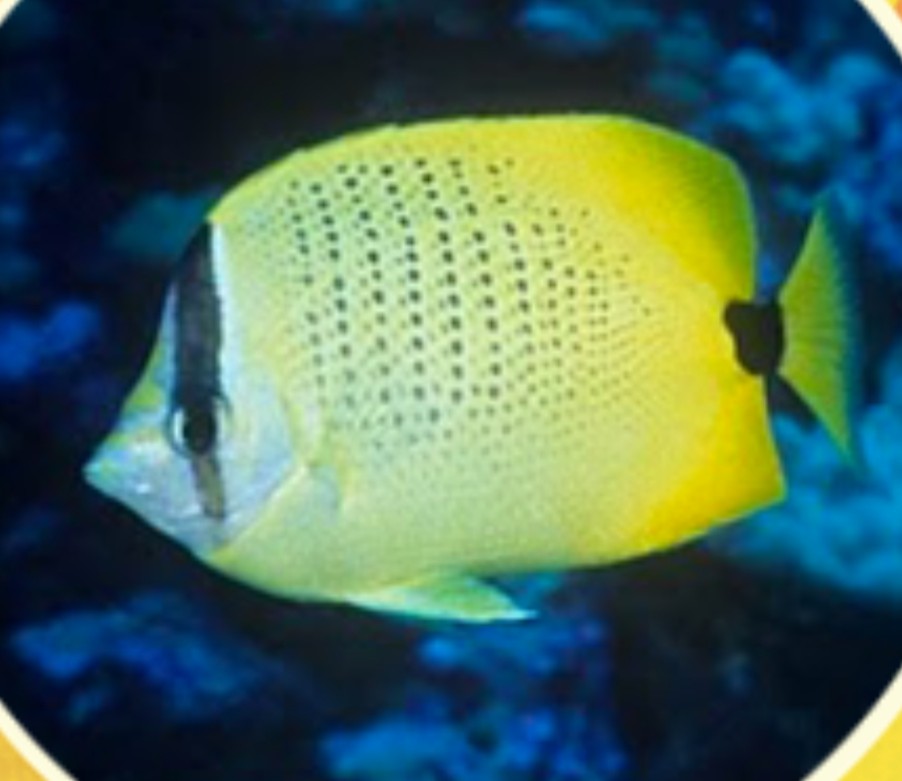
Chaetodontidae family
Small reef crustaceans and invertebrates ,Marine worms, Tube feet of echinoderms, such as sea urchins, Fish eggs, Hydroids, Sponges, Coral polyps
Yellow fish with tiny black spots forming vertical stripes, black vertical eye stripe and black stripe near caudal fin
Lemon “Millesteed” Butterfly
(Lau Wiliwili)
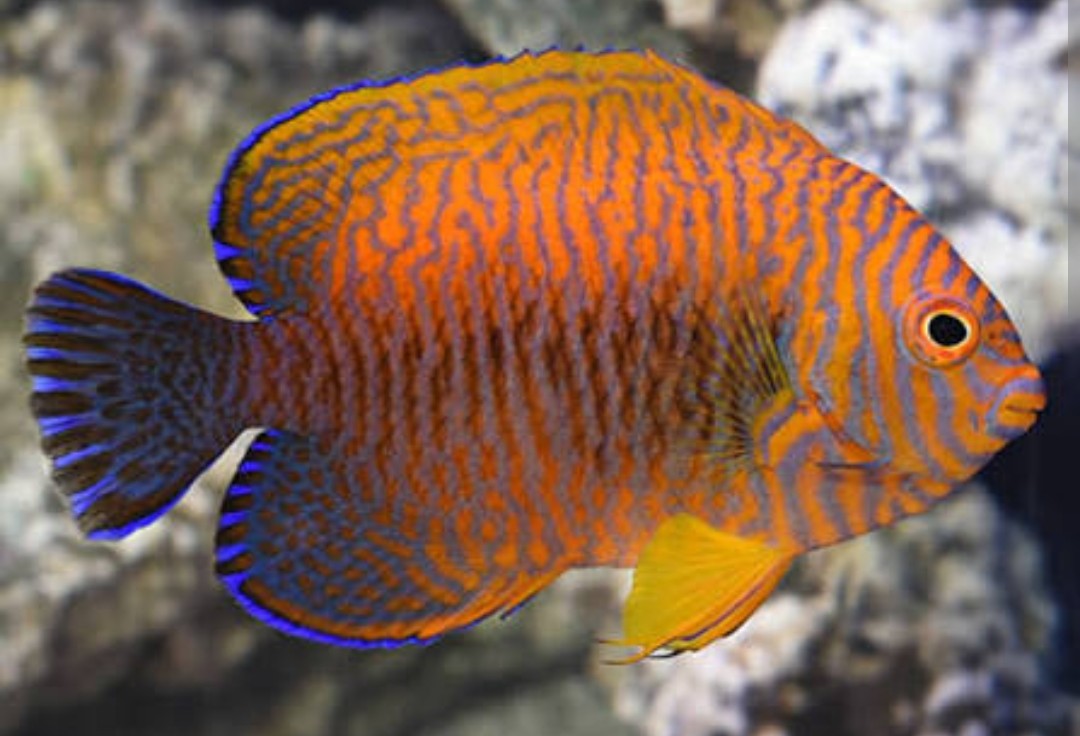
Pomacanthidae family
Doet consists of detritus supplemented with a varied marine algae
Bright orange with blue highlights, dark blue towards caudal fin
Potter’s (Pygmy) Angelfish
Fun fact: native specifically to the Hawaiian Islands, sometimes found in cleaning stations eating algae off of sea turtles and large fish
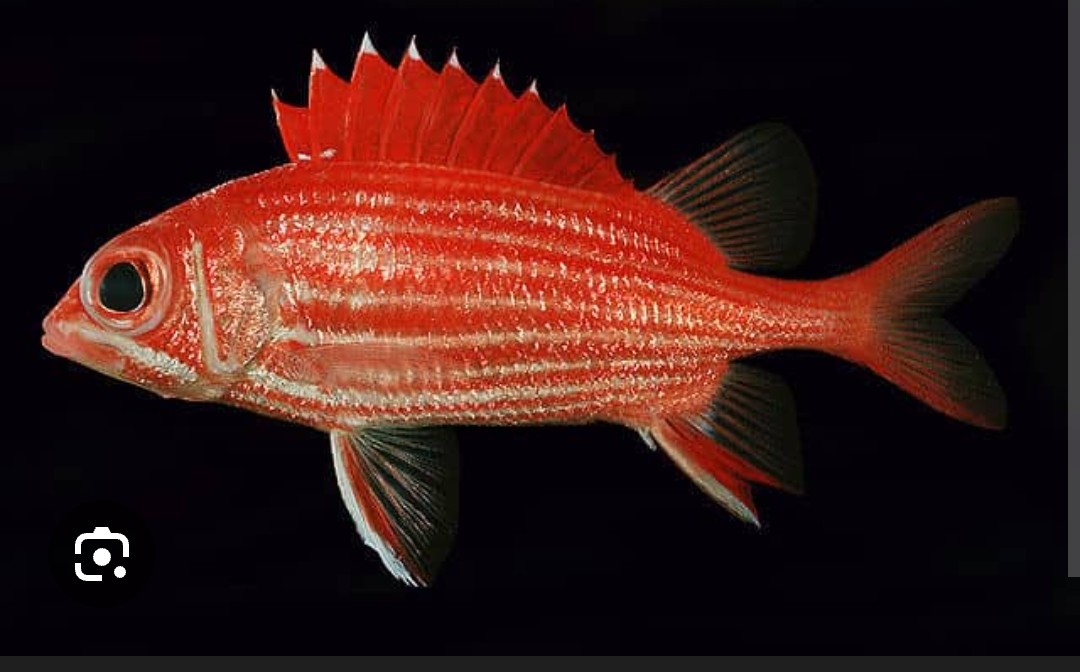
Holocentridae family
Their diet includes crustaceans like shrimp and crabs, mollusks, gastropods, and small fish
reddish with a golden sheen on top and sides, and a lighter underside.some may have yellow or black markings. Large dark eyes for enhanced night vision.
Squirrel fish (‘ū'ū)
Fun fact: they can produce chirping or grunting sounds by vibrating their swim bladders to communicate with each other or deter predators.

Labridae family
The Lolo eats snails, hermit crabs, crabs, shrimps, mollusks and sea urchins.
Two prominent teeth on both upper and lower jaws, vibrant yellow tail, blue markings on face
Yellowtail Wrasse “Coris” (Lolo)
Fun fact: at night Yellowtail Wrasse bury themselves in sand
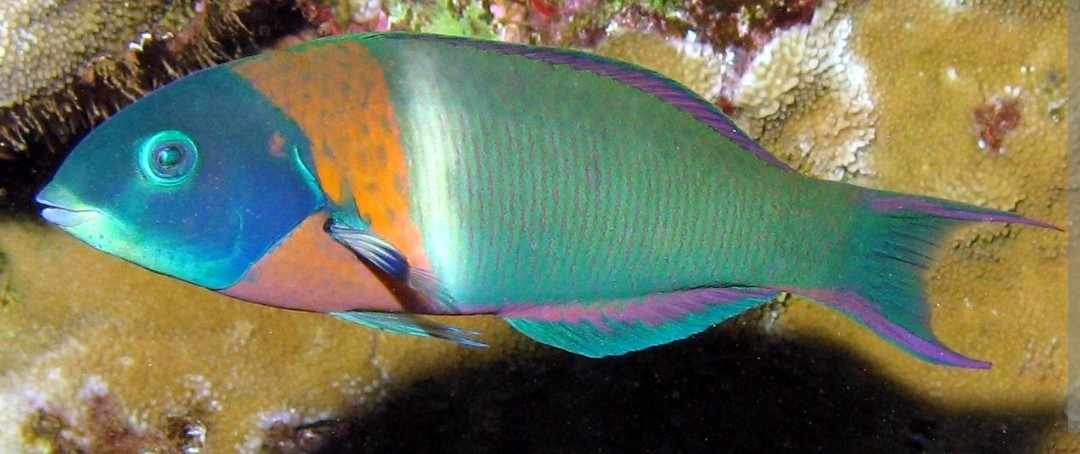
Labridae family
Feed on invertebrates, fish eggs, and algae. As juveniles, they act as cleaners by picking parasites off larger fish, while adults also scavenge for and crush the shells of mollusks and crustaceans.
Blue green fish with prominent yellow “saddle” behind head and pectoral fins, purplish-pink stripe along dorsal and anal fins
Saddle Wrasse (Hinalea Lauwili)
Fun fact: this fish has the ability to change sexes and color patterns during its life!
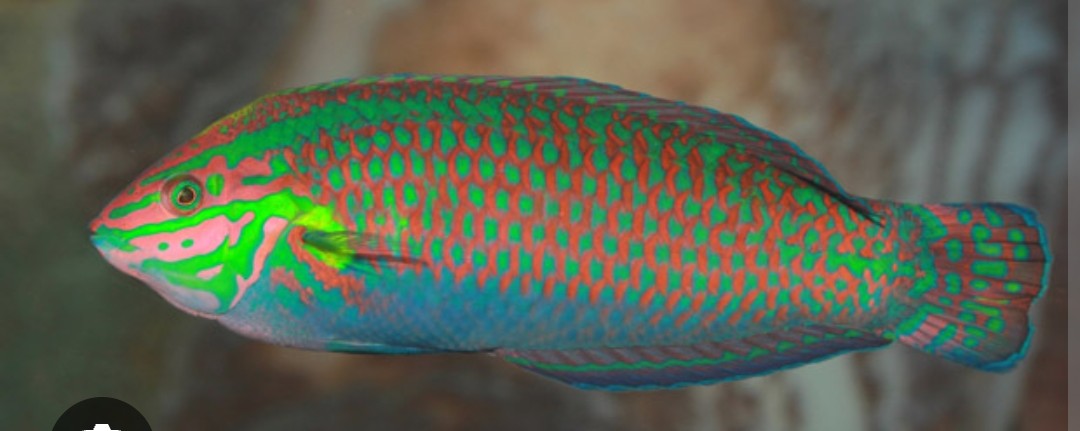
Labridae family
feed on small crustaceans and invertebrates
earthy red body lined with phosphorescent green stripes. Its belly is blue with scales marked by vertical, crescent-shaped stripe.
Ornate Wrasse (Pa’awela)
Fun fact: bury themselves in the sand during sleep and when they feel threatened by predators

Labridae family
have a dual diet: they act as cleaner fish, consuming small ectoparasites from the skin of larger fish, and they also feed on small invertebrates like crustaceans and mollusks found on the reef
three or four white spots on its bright red body
Juvenile Yellow-tail Wrasse (Lolo)
Fun fact: when female Wrasse are overrepresented in a group they will often change sex to become male. The Wrasse’s ability to change sex is one reason why it such a common reef fish
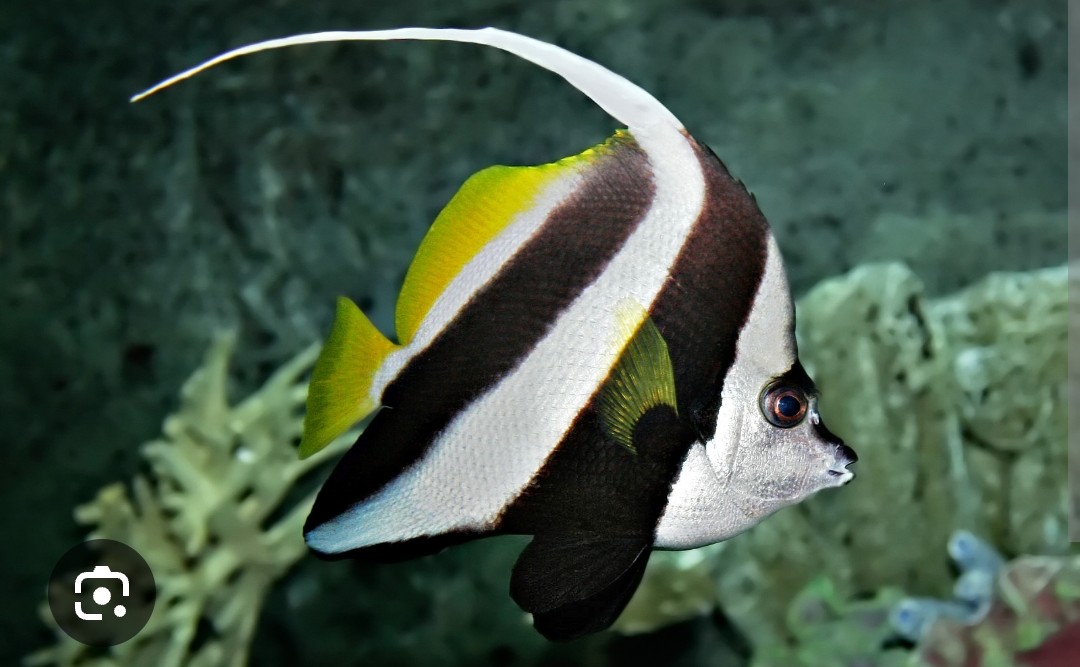
Chaetodontidae family
They survive off plankton but often spend their days eating algae from the backs of larger fish or turtles.
Dorsal fin extends beyond body, black and white with yellow dorsal and caudal fins
Pennant Fish or Banner Fish (Kihi Kihi)
Fun fact: incredibly social and can sometimes be found in schools of 30
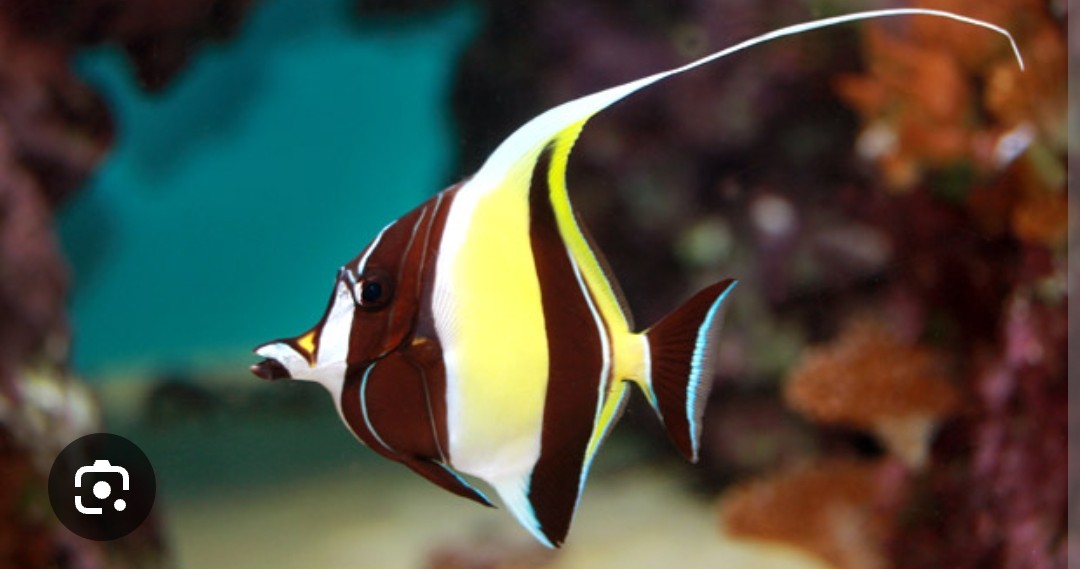
Zanclidae family
Omnivorous, the idol feeds mostly on animal material, like sponges, and extracts prey from crevices with a slightly elongated jaw
crescent shaped body with an extended dorsal, black and white stripes, yellowish orange saddle on upper jaw, black caudal fin
Moorish Idol (Kihi Kihi)
Fun fact: adults prefer to be alone but juveniles are social, can be found 600 ft deep, bars serve as predator disruptors
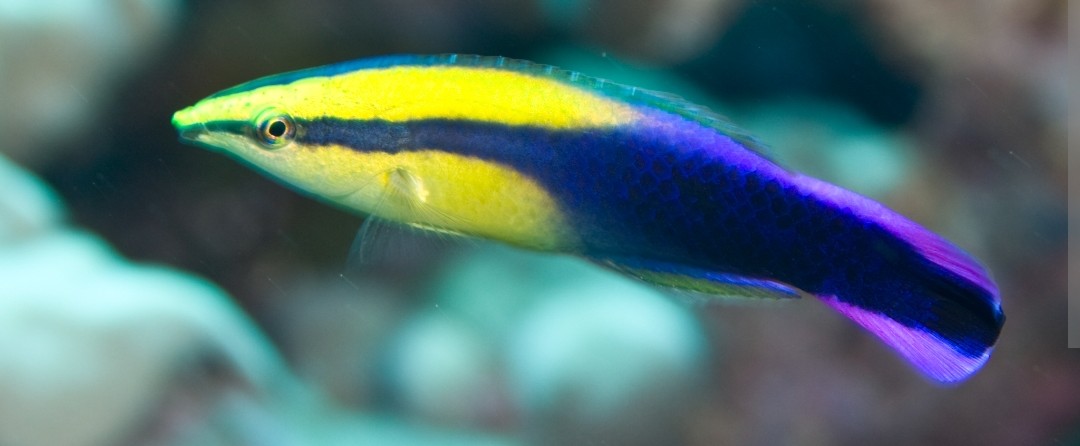
Labridae family
feeds mainly on small parasites, mucus, and dead skin found on larger fish.
Yellow head fading to purple towards caudal fin, bisected by black vertical stripe
Rainbow Cleaner Wrasse (Hinalea)
Fun fact: often found in pairs at cleaner stations
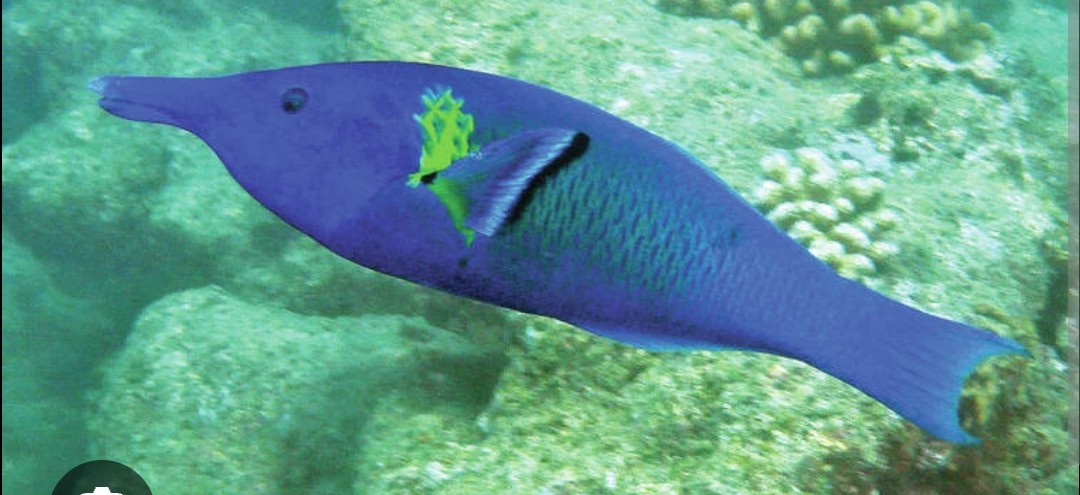
Labridae family
uses its protruding snout to capture prey (crustaceans) and break it into small pieces.
Beak like snout, the Females are a brownish black while males are variations of green.
Bird Wrasse (Hinalea I Iwi)
Fun fact: named not just for its bird like snout but for “flapping” its pectoral fins to swim like wings; males build harem and in absence of males females will change gender and build own harems
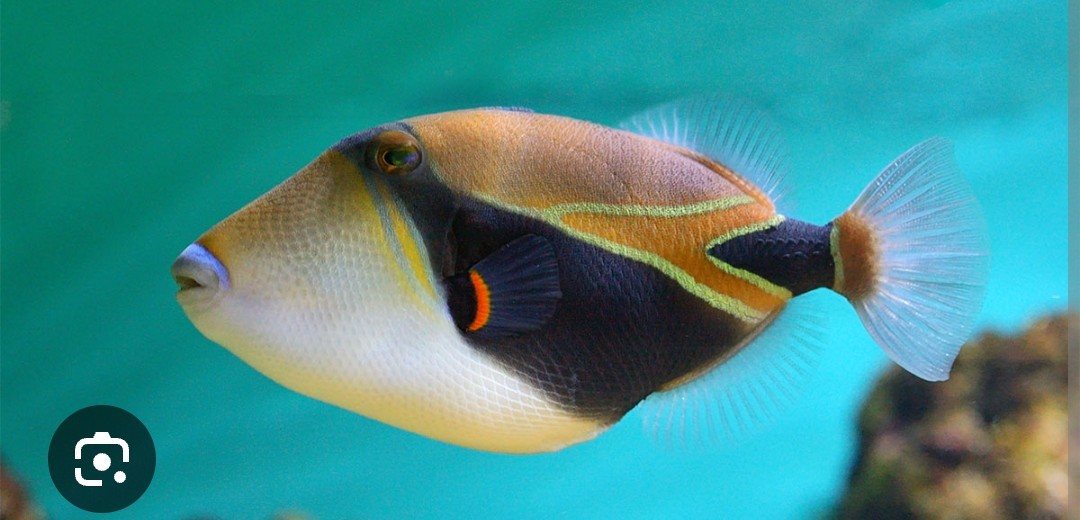
Balistidae family
diet consisting of both algae and small invertebrates like crustaceans (shrimp, crabs), worms, sea urchins, snails, and brittle stars
Diamond shaped body, long “pig-like” snout with sharp cutting teeth, tan back with large black diagonal stripe and black triangle near caudal fin, orange stripe near pectoral fin
Rectangular Triggerfish (HumuHumuNukuNukuApua’a)
Fun fact: makes a snorting sound similar to a pig when it is cornered or under stress. It can also erect its dorsal spines into the shape of a “trigger” when it feels threatened.
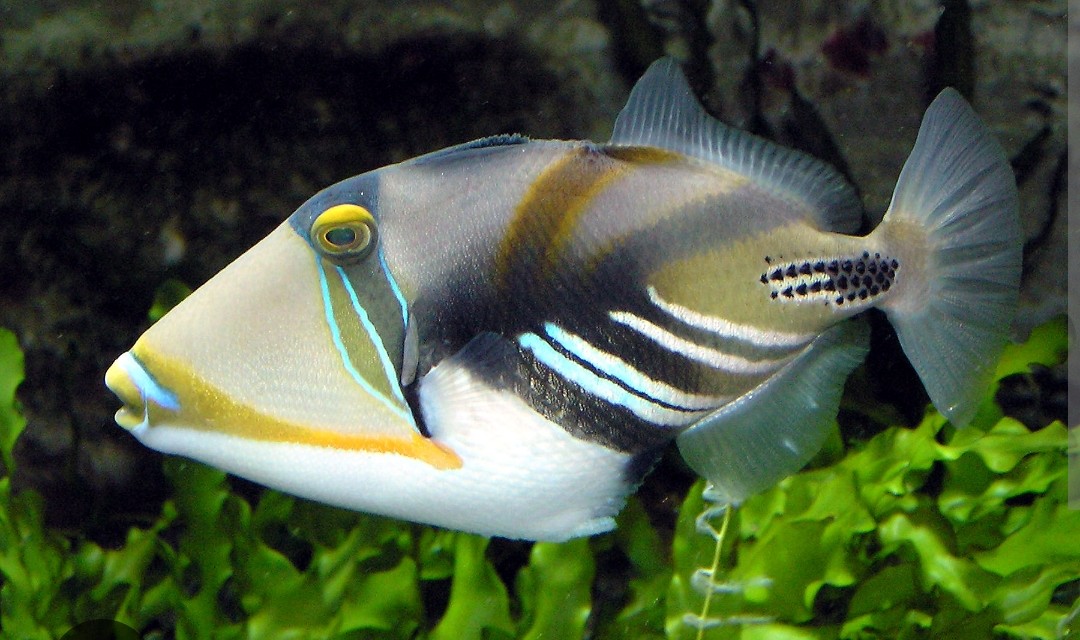
Balistidae family
eats a varied diet of invertebrates, such as shrimp, krill, clams, crabs, urchins, and mollusks
White stomach, tan back vriss crossed with brown saddle, blueish-white stripes, and white stripes moving upwards from stomach, large mouth and teeth with yellow horizontal stripe
Picasso (lagoon) Triggerfish
Fun fact: can fairly be aggressive, particularly when protecting eggs during mating season when males and females will take turns protecting offspring. It’s not uncommon for the Picasso Triggerfish to chase a snorkeler as a protective gesture

Pomacentridae family
It feeds on zooplankton, small benthic invertebrates (bottom-dwelling crustaceans), and floating algae
Dark fosh with distinctive white spot on upper part of body
White-Spotted Damsel (Alo’ilo’i)
Fun fact: Large schools will move together in unison, giving the impression of an elevator moving up and down
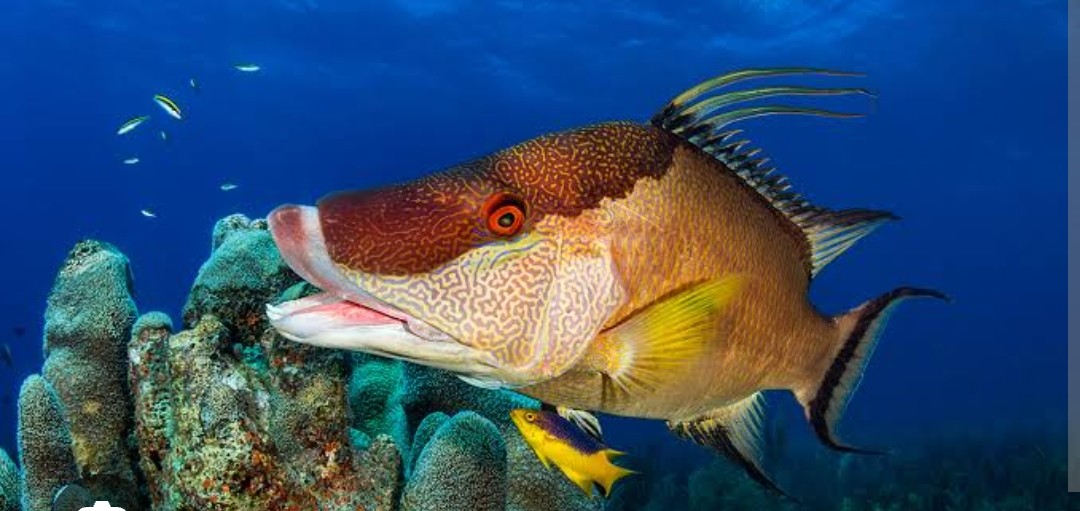
Labridae family
uses its long snout to search for crustaceans in the sandy ocean floor
Bright orangeish-red mottled coloring, Wrasse mouth (large jaws and distinctive teeth), males having a deep, dark band from their snout to their first dorsal spine and a black spot behind their pectoral fins, while females and juveniles are usually a paler color.
Hogfish (‘A ‘Awa)
Fun fact: they display Sequential hermaphroditism: start life as females and change to males later on, typically around three years of age.
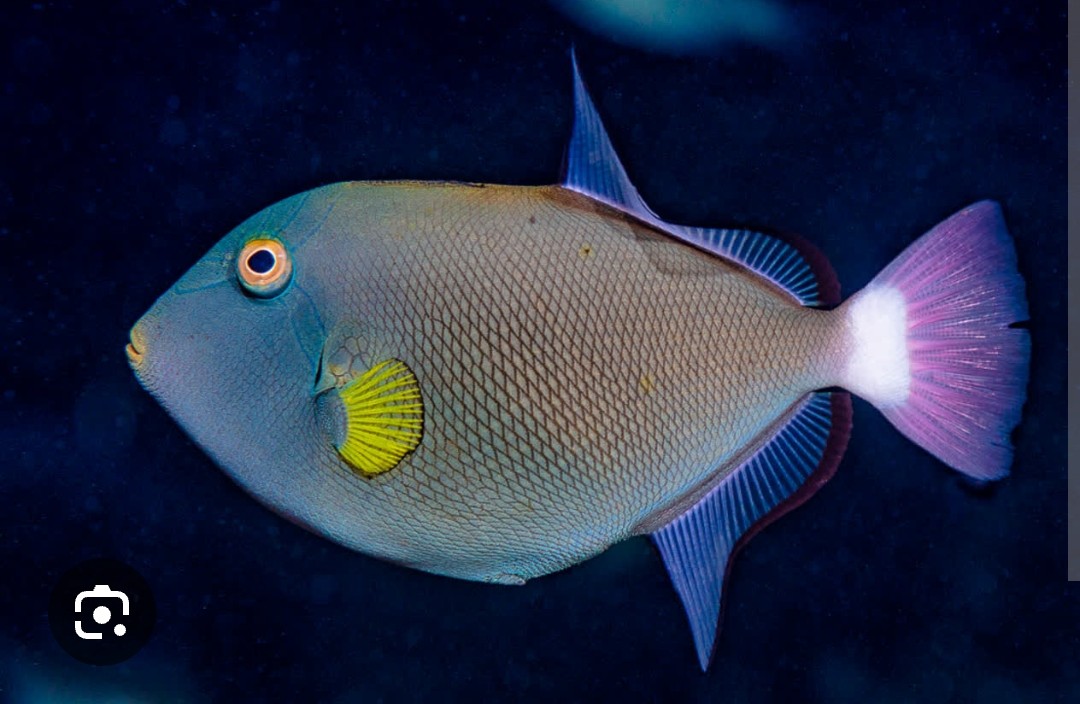
Balistidae family
Diet consists of algae, small fish, crustaceans, mollusks, and other invertebrates like sea urchins and sponges
Diamond shaped body, with light pink to white caudal fin, bright yellow pectoral fin, black exterior lining on dorsal and anal fins, dinstinct “trigger” protrusions on dorsal and anal fins
Pinktail Triggerfish
Fun fact: will employ unique vocalizations when threatened or agitated. This relatively aggressive fish will lash out at others when protecting unhatched eggs during mating season
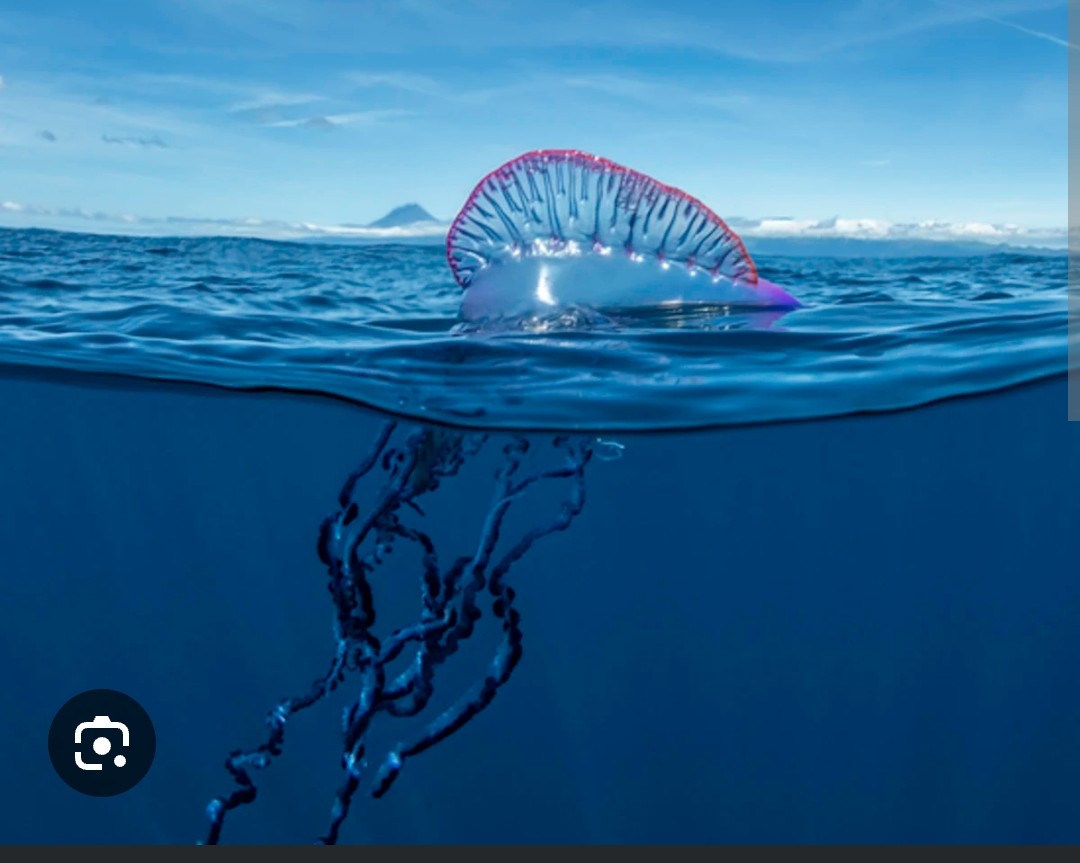
Physaliidae family (it is a siphonophore)
uses its long, venomous tentacles, which can be up to 165 feet long, to trap and paralyze fish, crustaceans, and plankton before reeling it in for digestion.
gas-filled, translucent blue-purple or pink “float” (Pneumatophore) that acts as a sail, and long, trailing tentacles
Portuguese Man-O- War (Pololia and Pa’i Malau)
Fun fact: looks similar to a jellyfish, is actually made up of multiple organisms called zooids. Each of these Zooids has individual functions that together make up a collective organisms which are physiologically incapable of independent survival.

Exocoetidae family
Primarily feed on zooplankton,
elongated, cylindrical body, a short, blunt snout, and a deeply forked caudal fin with a much longer lower lobe; incredibly large wing-like pectoral fins, smaller anal and dorsal fins sit further back on body
Flying Fish (Malolo)
Fun fact: can travel in the air for distances of up to 1300 ft and periods of up to 40 seconds
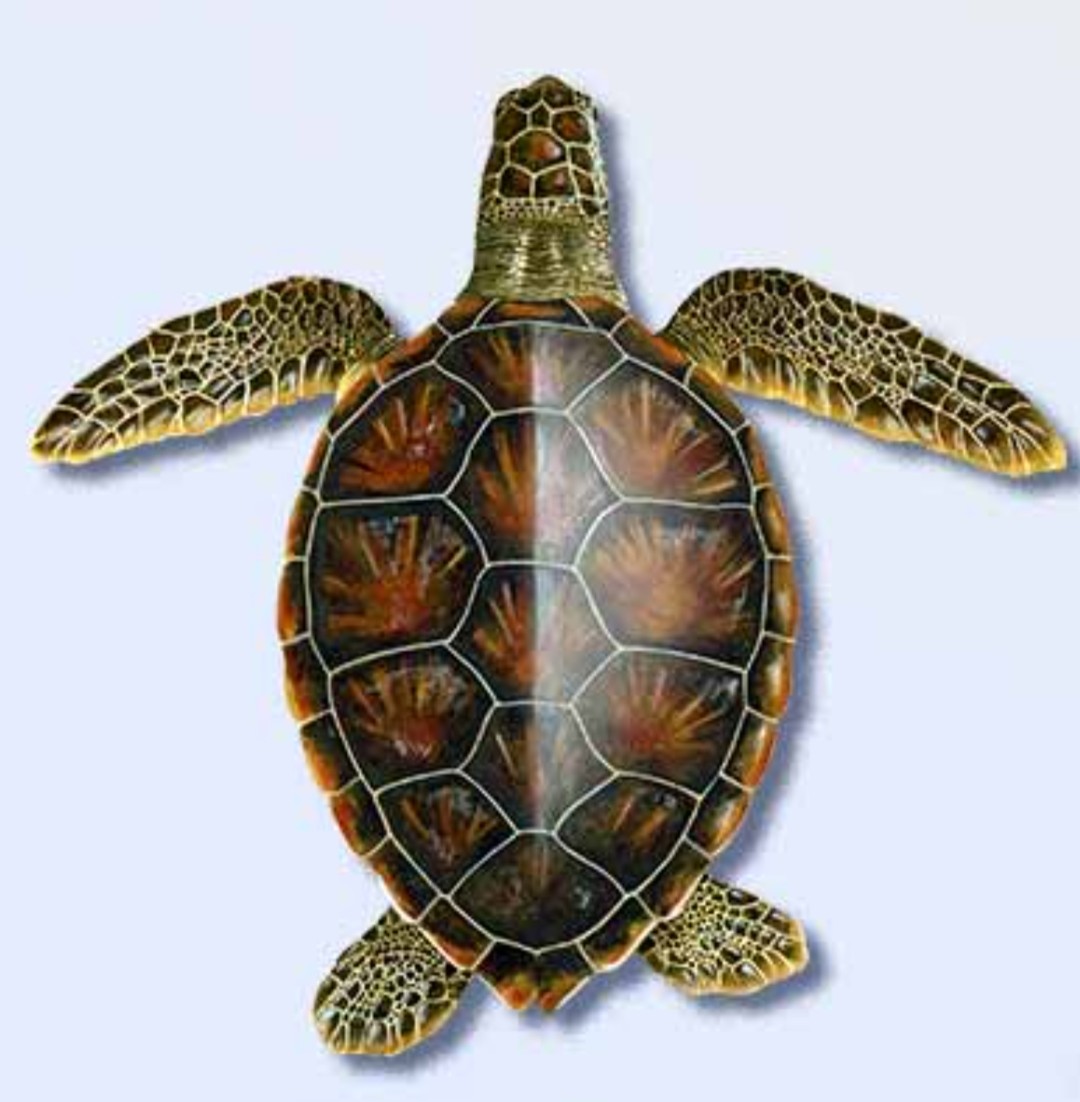
Cheloniidae family
Their diet changes as they age, with hatchlings and juveniles eating a more carnivorous diet of invertebrates and other organisms before shifting to a largely plant-based (sea grass and algae) diet in adulthood.
large, hard-shelled animal with smooth, heart-shaped carapaces that range from light to dark brown or olive, while their undersides (plastron) are yellowish-white. Key identifiers include a relatively small head, serrated beak, and a single pair of prefrontal scales on their forehead, in addition to their paddle-like flippers
Green Sea Turtle (Honu)
Fun fact: have been known to travel up to1600 miles to find their nesting grounds. Once endangered but have made a significant come back due to conservation efforts. Not named for thier external color but for the color of their fatty tissue as a result of thier diet

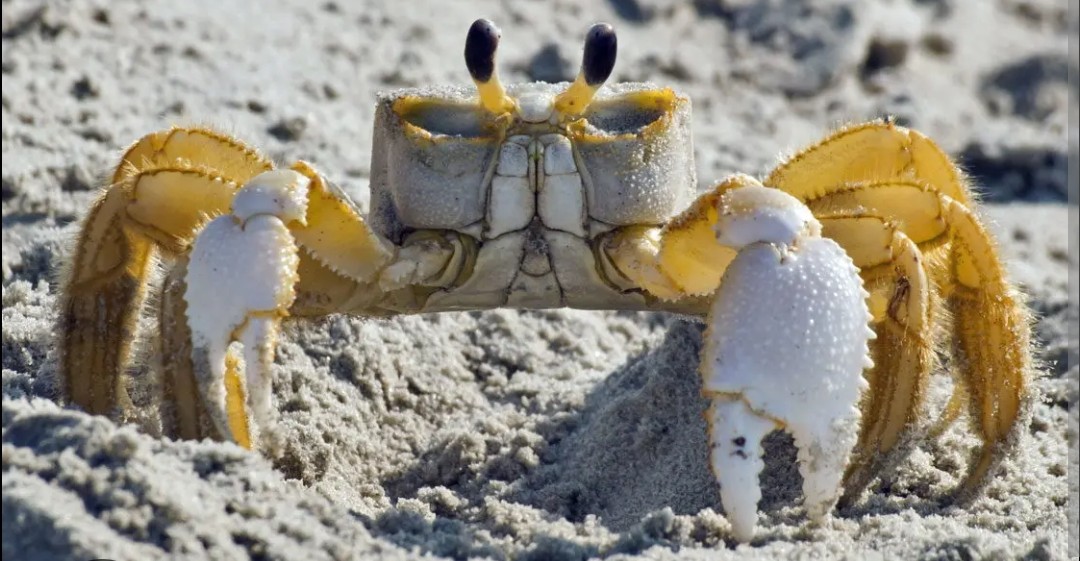
Ocypodidae family
varied omnivorous diet, consuming both living prey and scavenging dead matter. They primarily feed at night on insects, clams, mole crabs, and sea turtle eggs and hatchlings. They also scavenge for vegetation and other organic material.
look for its pale, square-shaped body, large stalked eyes, and two claws of unequal size
Ghost Crab (`ōhiki)
Fun fact: digs in the sand to create underground chambers to escape the mid-day sunshine in Hawaii. Ghost Crabs tend to be more active at night, feeding on a wide variety of debris and the occasional turtle hatchling. Always returns to ocean to lay eggs despite spending most of its time on shore
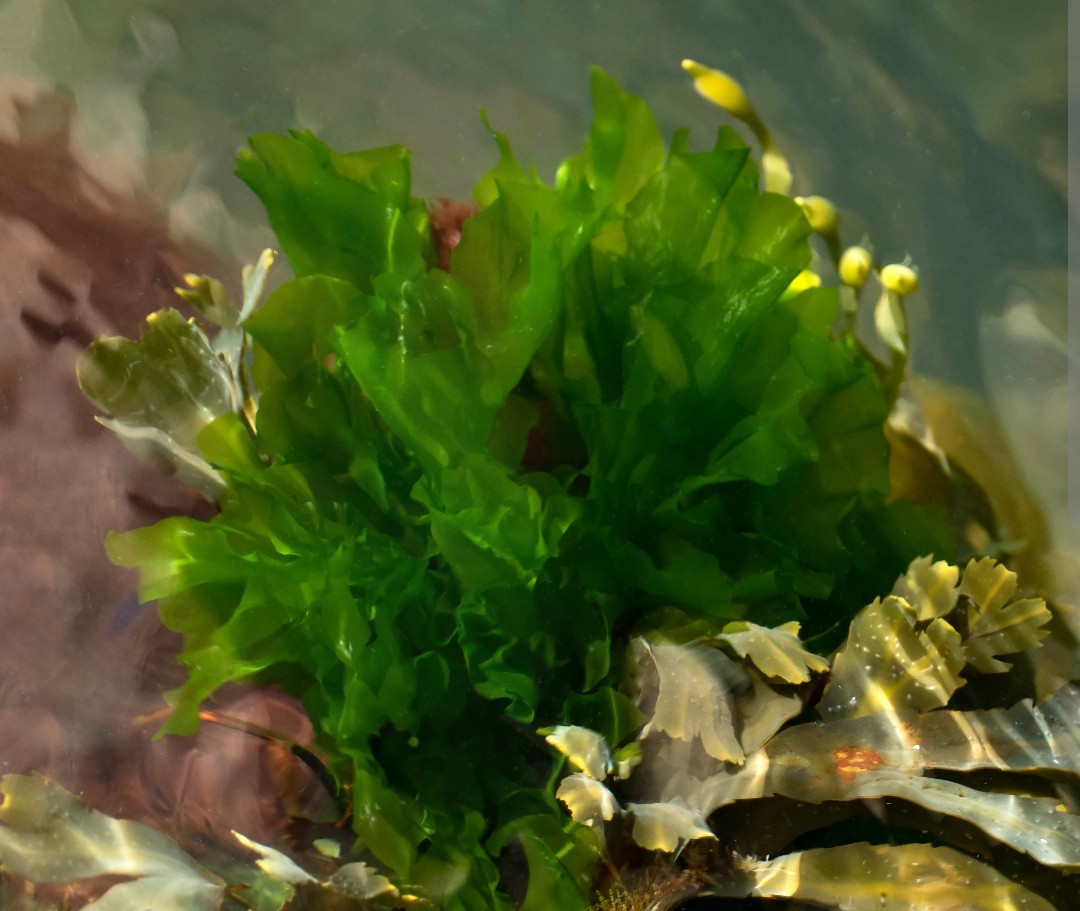
an edible green algae often found on the rocky coastlines of the Hawaiian islands and throughout the world’s oceans
Sea Lettuce
Fun fact: high in soluble fiber, protein, a diverse range of vitamins and an excellent source of iron.
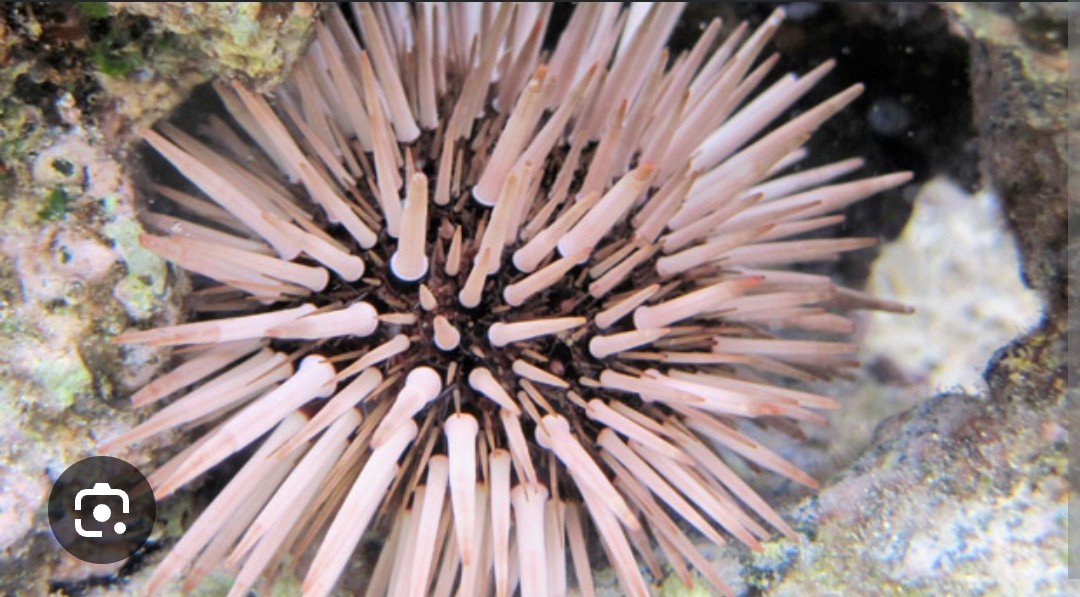
Echinometridae family (with starfish, radial symmetry)
omnivores with a diet that consists primarily of algae, as well as seagrasses and other plant matter, which they scrape from surfaces using a specialized feeding structure called Aristotle's lantern.
Often found in rock crevices, dark urchin with short light colored spines with tapered ends
Rock Boring Sea Urchin
Fun fact: use thier powerful jaws to create thier own rock shelters ti avoid predators
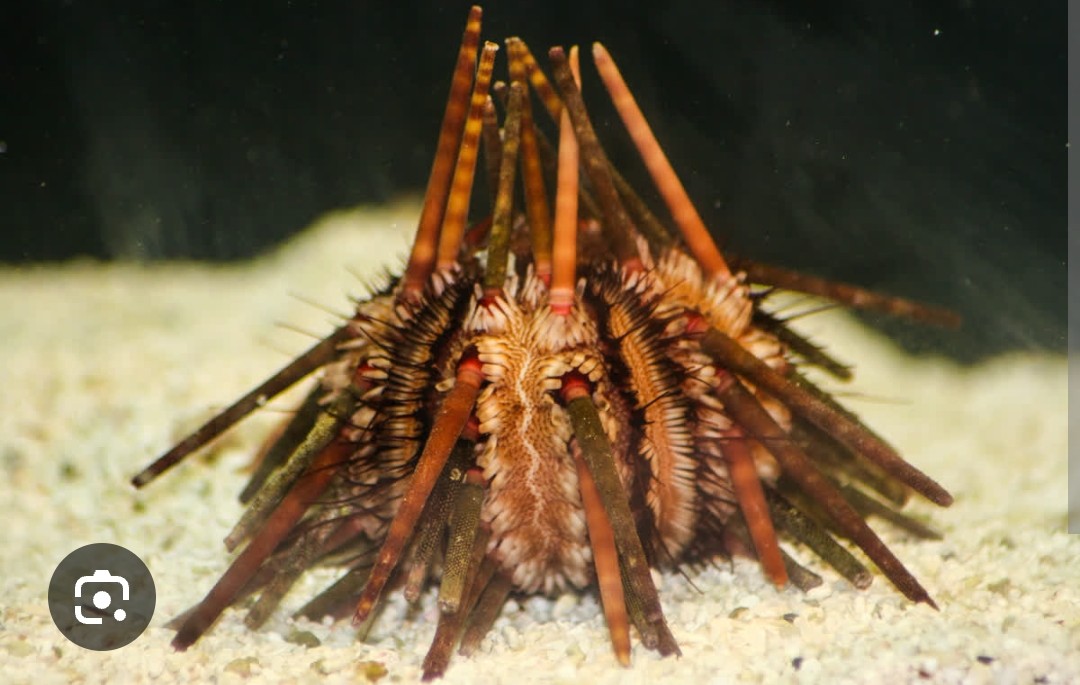
Echinometridae family
primarily eats algae and other plant matter, but its diet is omnivorous, including invertebrates like sponges and mussels
look for a thick, blunt, "pencil-like" spine structure and a body that is often reddish-brown, tan, or orange-red
Slate Pencil Sea Urchin
Fun fact: Recently, scientists have begun to place these urchins on coral reef where invasive species of algae are present. The urchins will feed off the algae, restoring balance to the ecosystem. Its name comes from the historical use of its spines as a substitute for chalk on slate boards.
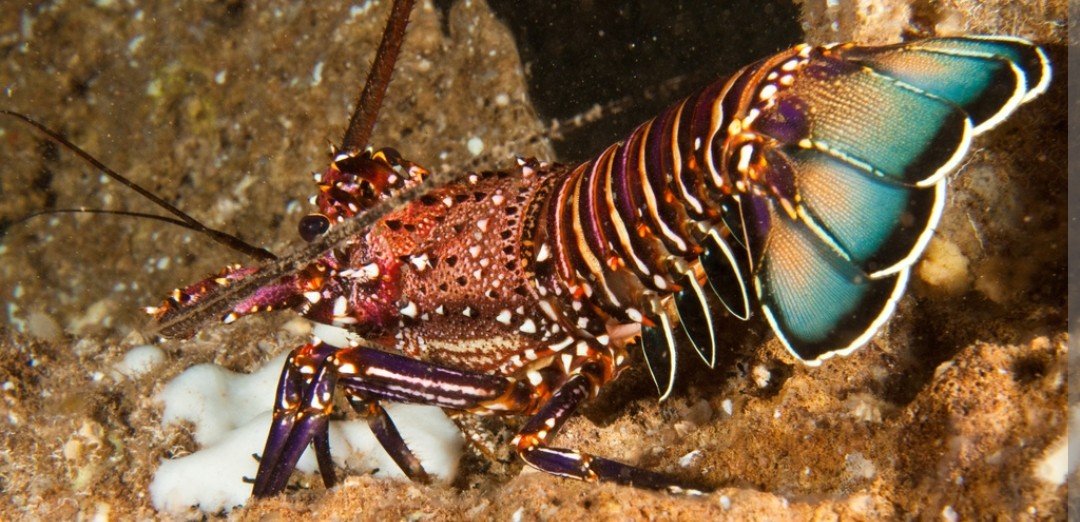
Palinuridae family
carnivorous omnivore that feeds on a variety of marine life, including mollusks, crustaceans, and echinoderms, and sometimes small fish
light pink to reddish antennae and blue tail segments which are marked with distinct white bands in between the darker segments. The legs are a solid dark color
banded spiny lobster
Fun fact: they can make a “squeaking” or rasping sound to defend themselves. They produce this noise by rubbing their long antennae together, which helps to deter predators.
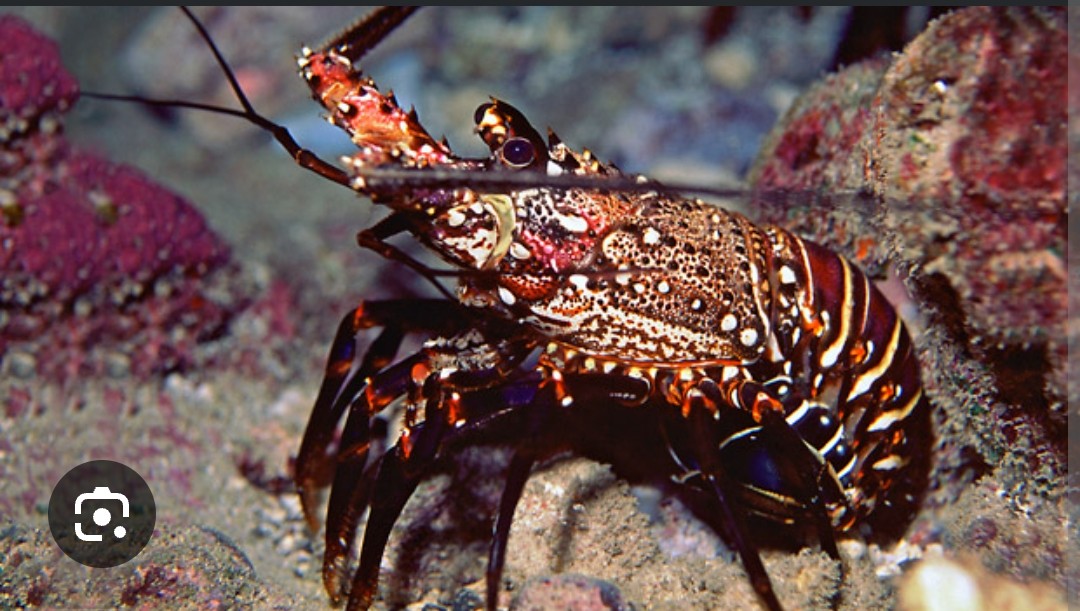
Palinuridae family
diet consists of invertebrates and carrion found on the seabed, including mollusks (like snails and clams), crustaceans (like crabs), and echinoderms (such as sea urchins), as well as dead fish
identified by its purple and white banded tail, black legs with a single white stripe, and lack of large front claws. It is covered in sharp, forward-pointing spines on its body and antennae, and often has two horn-like spines over its eyes
Hawaiian spiny lobster (‘ula)
Fun fact: Instead of claws, spiny lobsters have very long, thick, spiny antennae. They use these for defense by rubbing them against a toothed surface on their carapace, creating a high-pitched, "fingernails-on-a-chalkboard" sound to scare away predators.
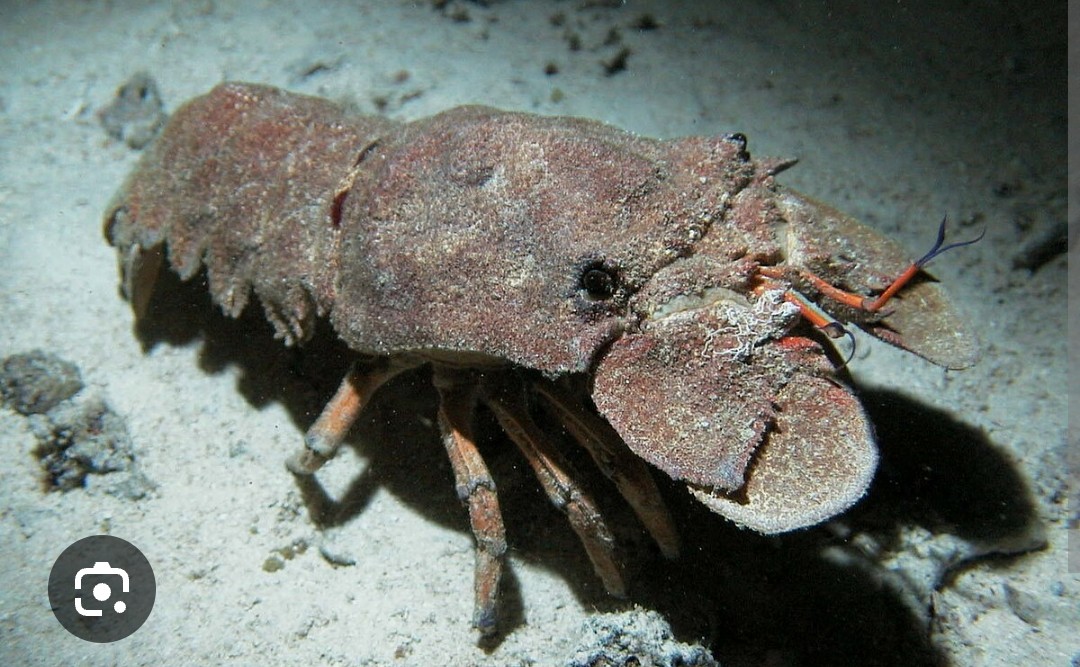
Scyllaridae family
diet is opportunistic and includes a wide variety of marine life, such as mollusks (like mussels and oysters), crustaceans (including small shrimp and crabs), worms, sea urchins, and dead fish
flattened, shovel-like bodies and lack of large claws. A key trait is their broad, paddle-shaped antennae that project forward like plates
Slipper Lobster (Ula-papapa)
Fun fact: masters of camouflage and use their flattened antennae like paddles, not claws, for digging and eating
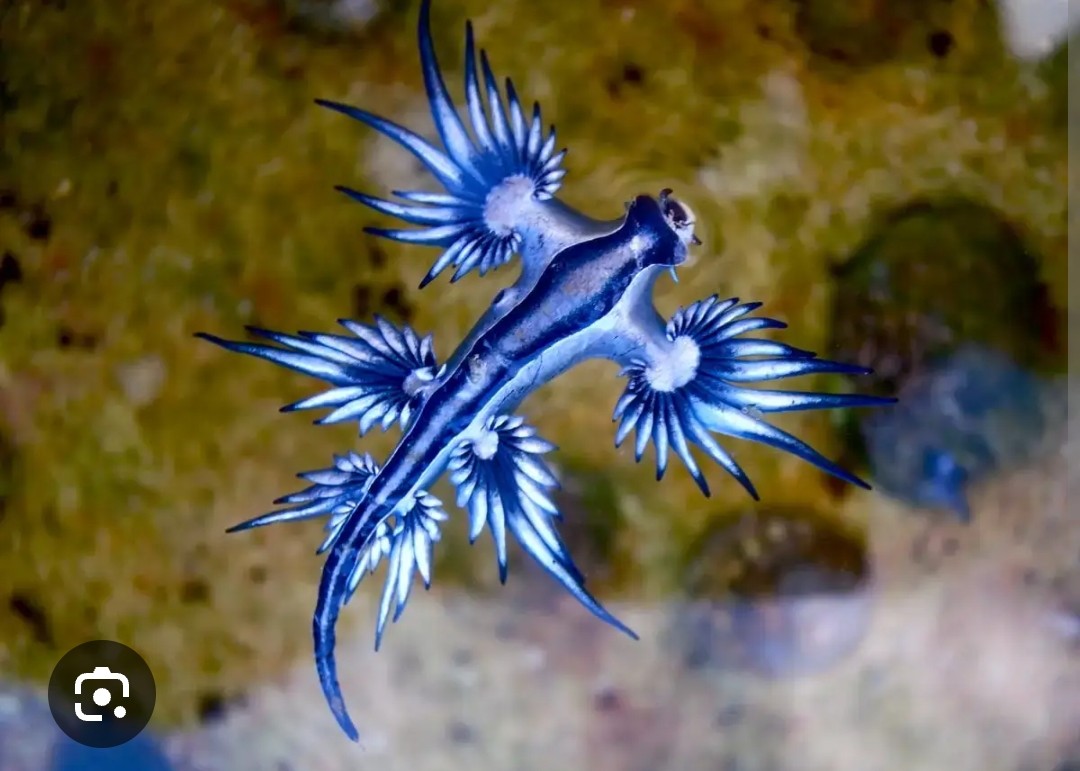
Glaucidae family
venomous marine animals, primarily the Portuguese man o' war
silvery-blue, torpedo-shaped body with dark blue stripes on the head, and six wing-like appendages called cerata that are arranged in clusters
Blue dragon
Fun fact: it stores the stinging cells from its prey for defense, making its sting more potent than its prey's
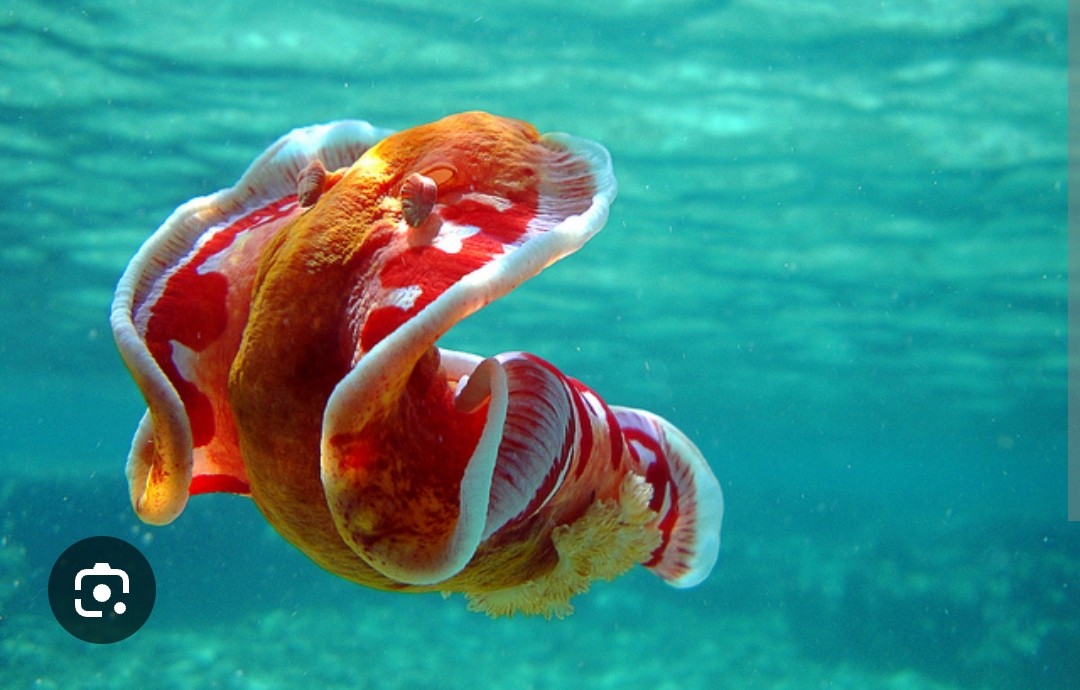
Hexabranchidae family
diet primarily consists of sponges
identifiable by its large size, bright orange-red body with white speckles, and its ability to swim by undulating its body and unfurling its mantle
Spanish Dancer
Fun fact: obtains chemical compounds to use as a defense mechanism from the sponges it eats
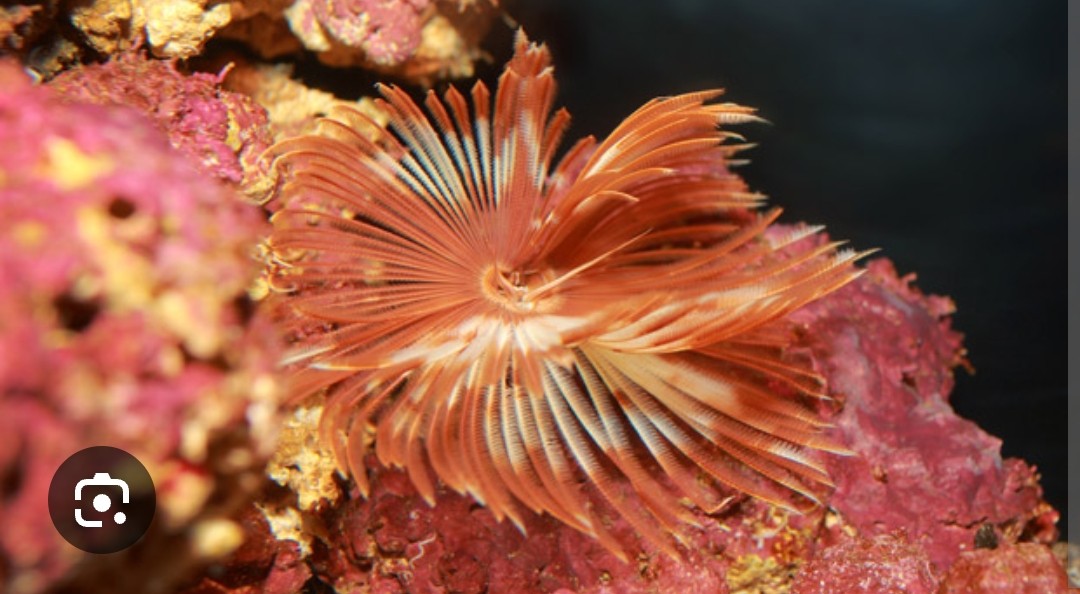
Sabellidae family
eat tiny organic particles like plankton (both phytoplankton and zooplankton), as well as organic detritus and food particles in the water.
prominent, colorful, and feathery crown of tentacles (called radioles) that they extend for filter-feeding
Feather Duster Worm
Fun fact: uses sand, and other available supplies to create a rock-like undercarriage, bound together by self-secreted calcium carbonate. When threatened it quickly recoils into its stiff, protective shell base
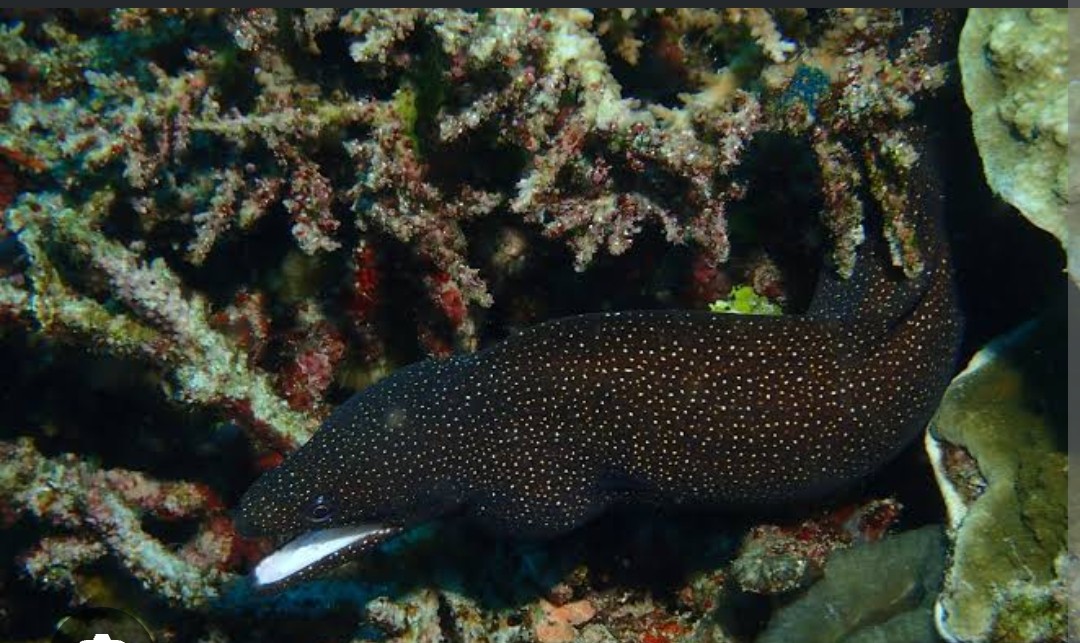
Muraenidae family
diet is carnivorous, consisting mainly of small fish, crabs, and octopuses
dark body with white spots and a distinctive white mouth
White Mouth or Turkey Eel
Fun fact: the "why" behind its permanently open mouth is to help it breathe. Unlike other fish with separate gill covers, moray eels pump fresh water over their gills by continuously opening and closing their mouths, allowing them to get oxygen while staying hidden in their reef homes.
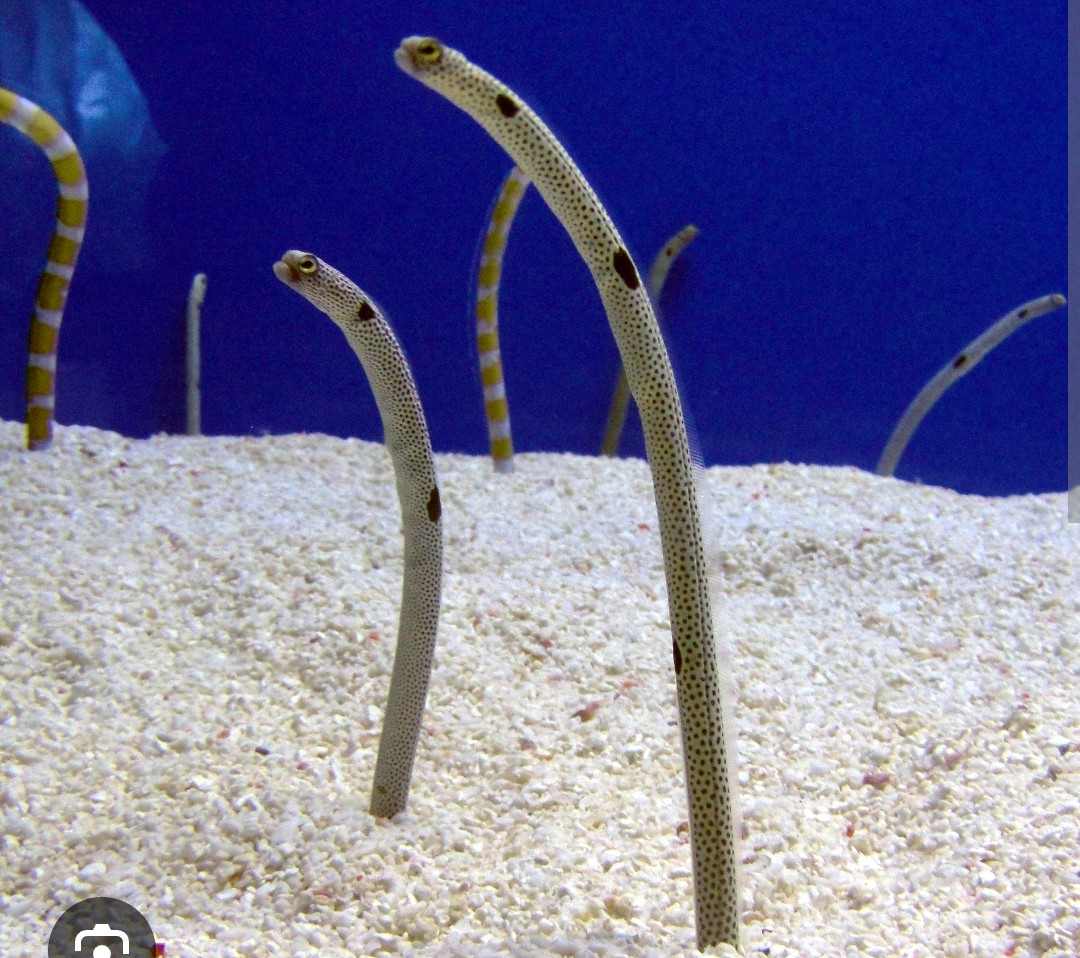
Congridae family
feed on small planktonic organisms, such as copepods and shrimp larvae
typically whitish with numerous small black spots and three larger, distinctive black spots: one at the gill opening, one mid-body, and one near the anus
Hawaiian garden eel
Fun fact: these eels use thier tails to dig holes in the sand, very shy animals
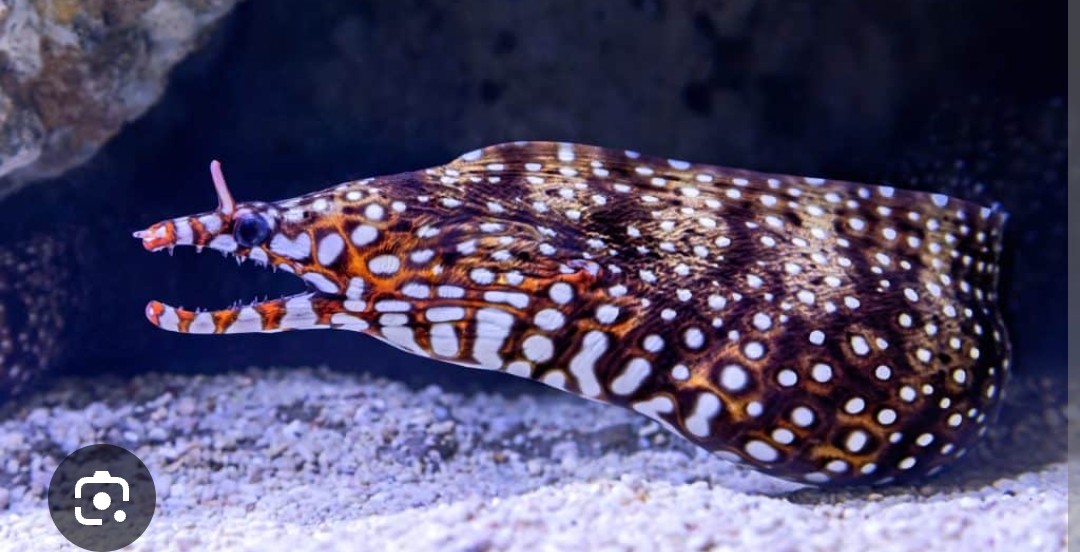
Muraenidae family
carnivorous predator that primarily preys on fish, squid, and crustaceans.
known for their vibrant orange, black, brown and tan bodies with white spots and horn-like nostrils
Dragon moray
Fun fact: they have unique tubular nostrils, with the longer, more prominent pair at the front of the snout and a second set above the eyes that resemble horns, which aids their excellent sense of smell.
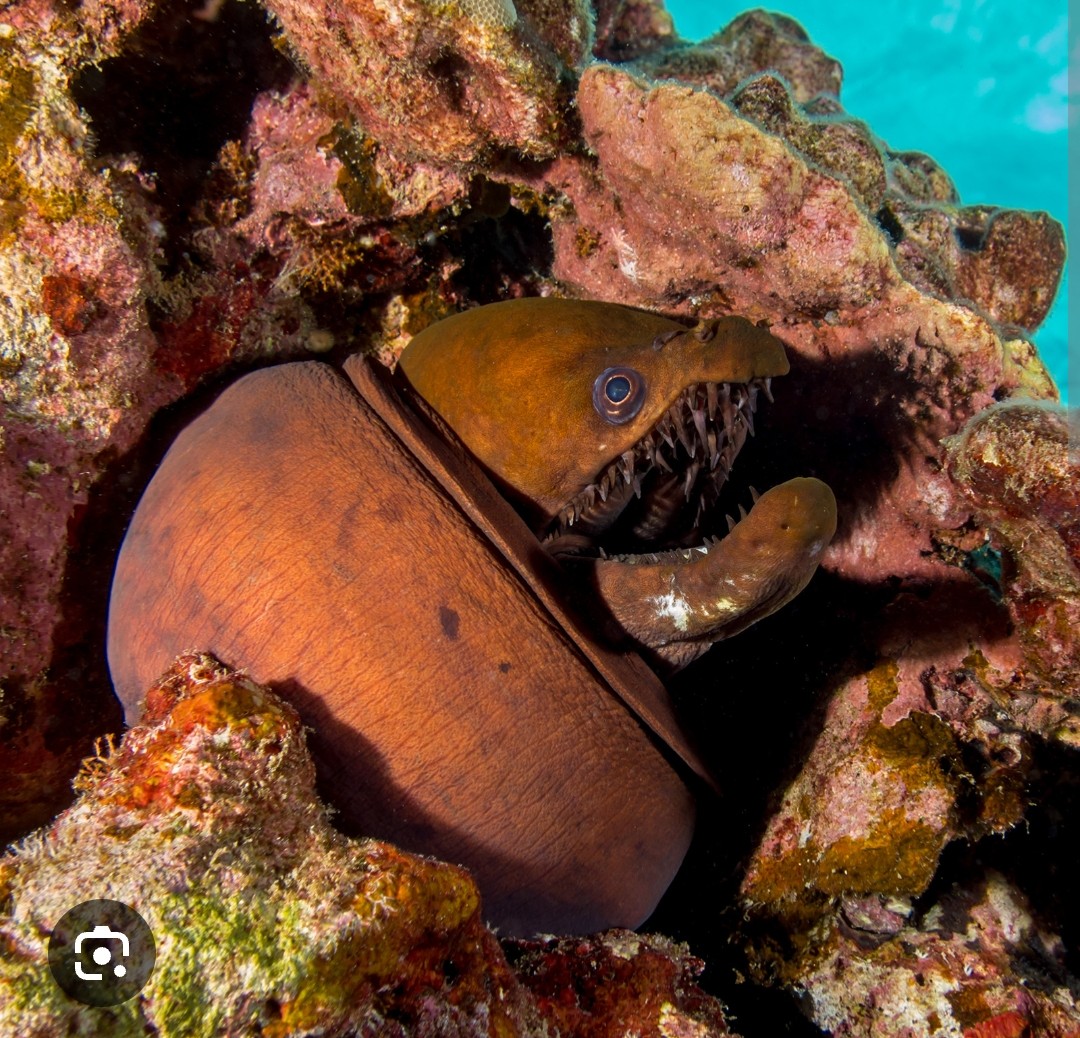
Muraenidae family
carnivorous predator that eats fish and octopuses
long, fang-like teeth that are visible even when the mouth is closed, its slender, elongated body with a dark brownish-grey coloration and thin blackish lines, and its long, arched jaws that only touch at their tips
Viper moray
Fun fact: despite thier name and viscous appreance they are considered very shy
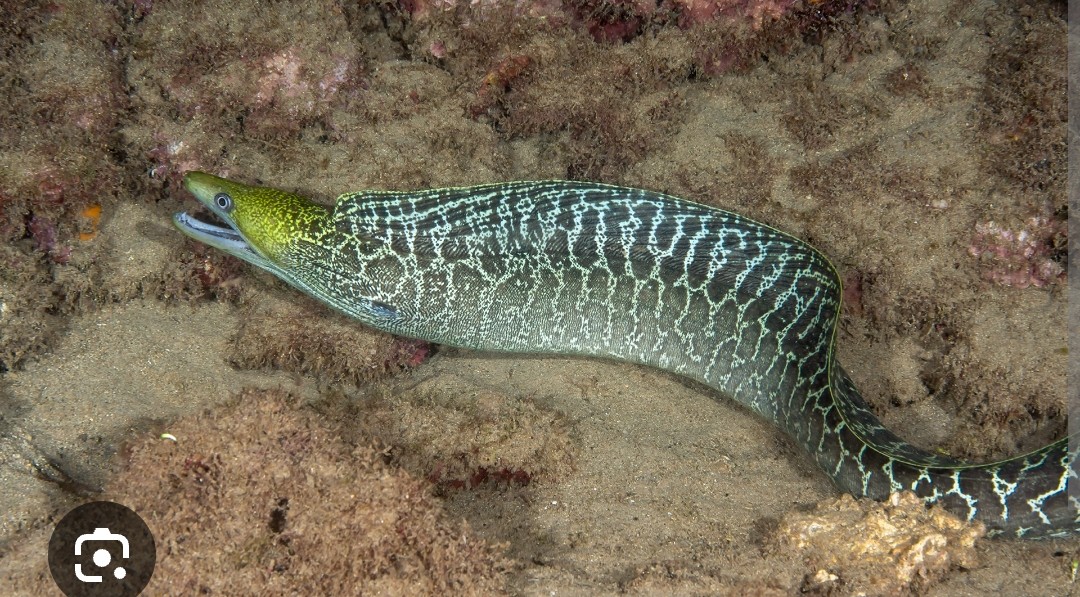
Muraenidae family
Its diet consists mainly of small fish, crustaceans (like crabs and shrimp), and cephalopods (such as octopus)
yellowish or greenish coloration covered in large, irregular brown blotches outlined by white or yellowish borders that create a chain-link fence pattern.
Undulated moray (laumilo)
Fun fact: in Hawaiian culture, it is considered an ancestor spirit called a ʻaumakua and is seen as a protector of families
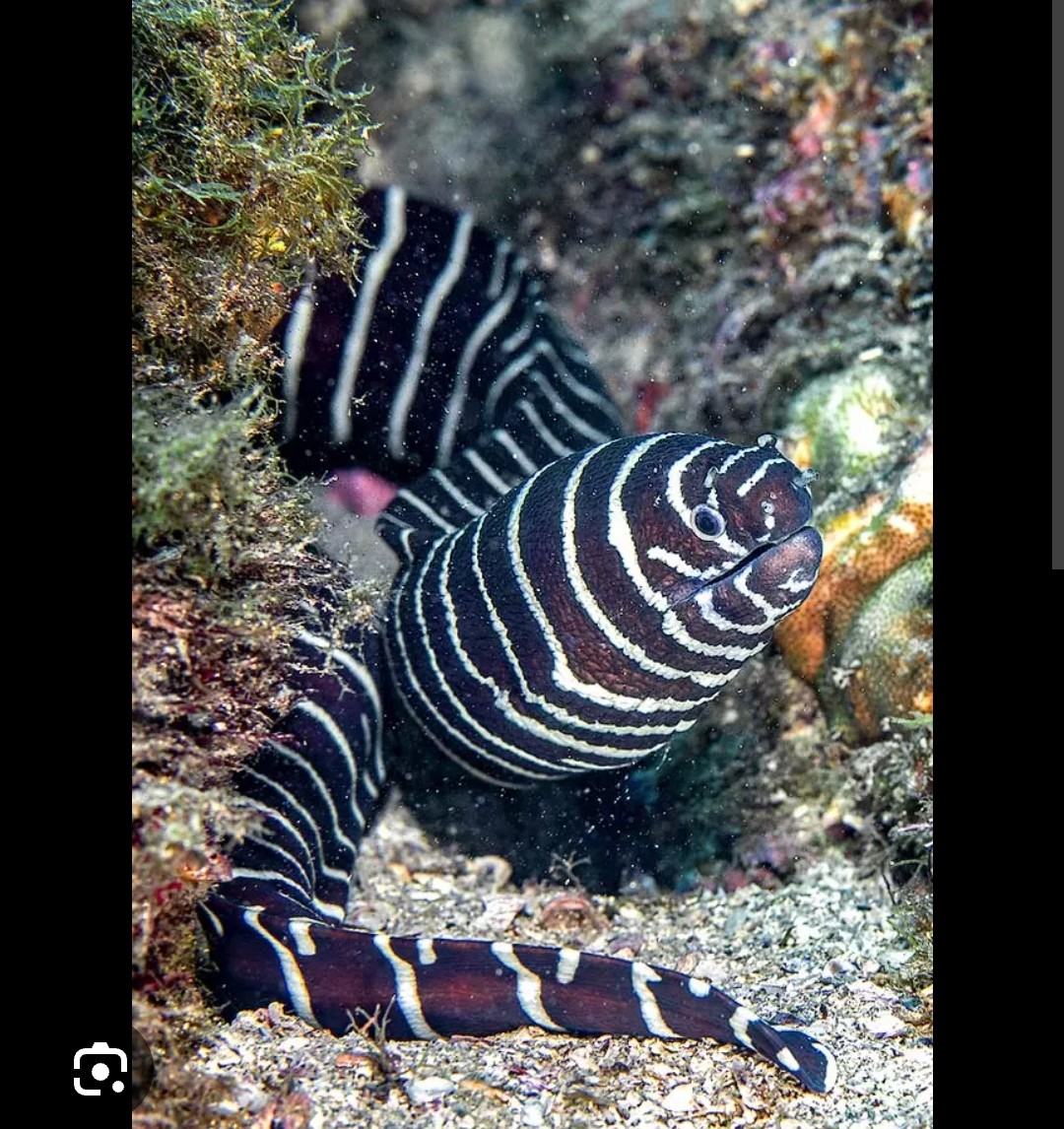
Muraenidae family
diet of crustaceans, mollusks, and sea urchins
striking black and white banded body, which gives it its name.
Zebra moray
Fun fact: it has specialized, flat, plate-like teeth used for crushing hard-shelled prey like clams and crabs, unlike most other morays that have sharp, pointed teeth
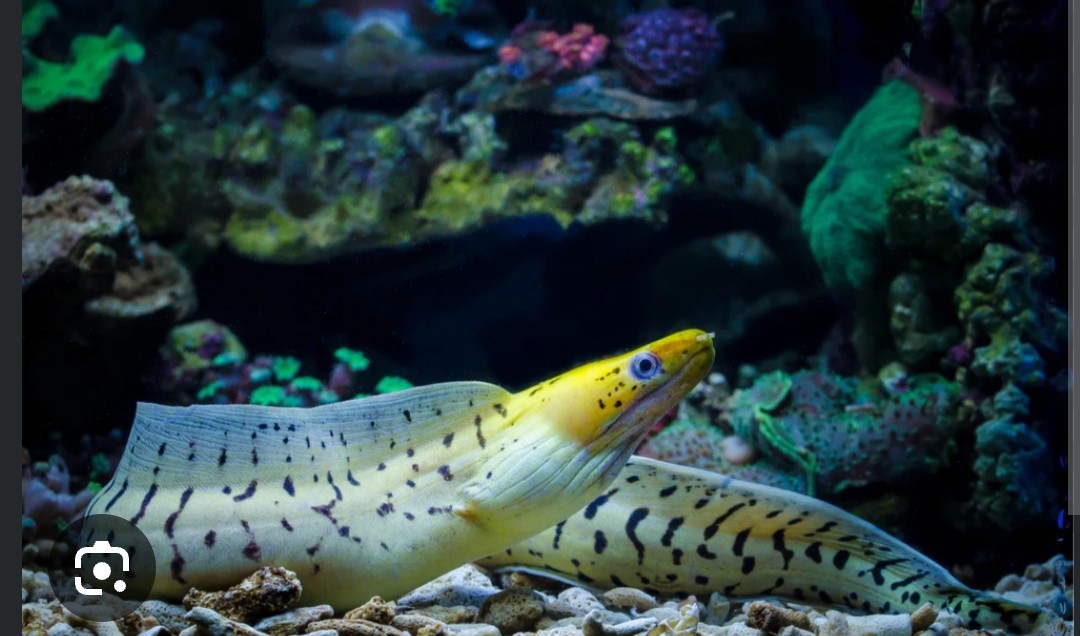
Muraenidae family
carnivorous fish that primarily eats other fish, crustaceans, and cephalopods.
distinct yellow head that contrasts with a spotted body, which is typically white with brown bars or blotches, or a grayish-brown with dark bars
Yellow head moray
Fun fact: they are mainly nocturnal, hiding in rock crevices during the day and hunting at night
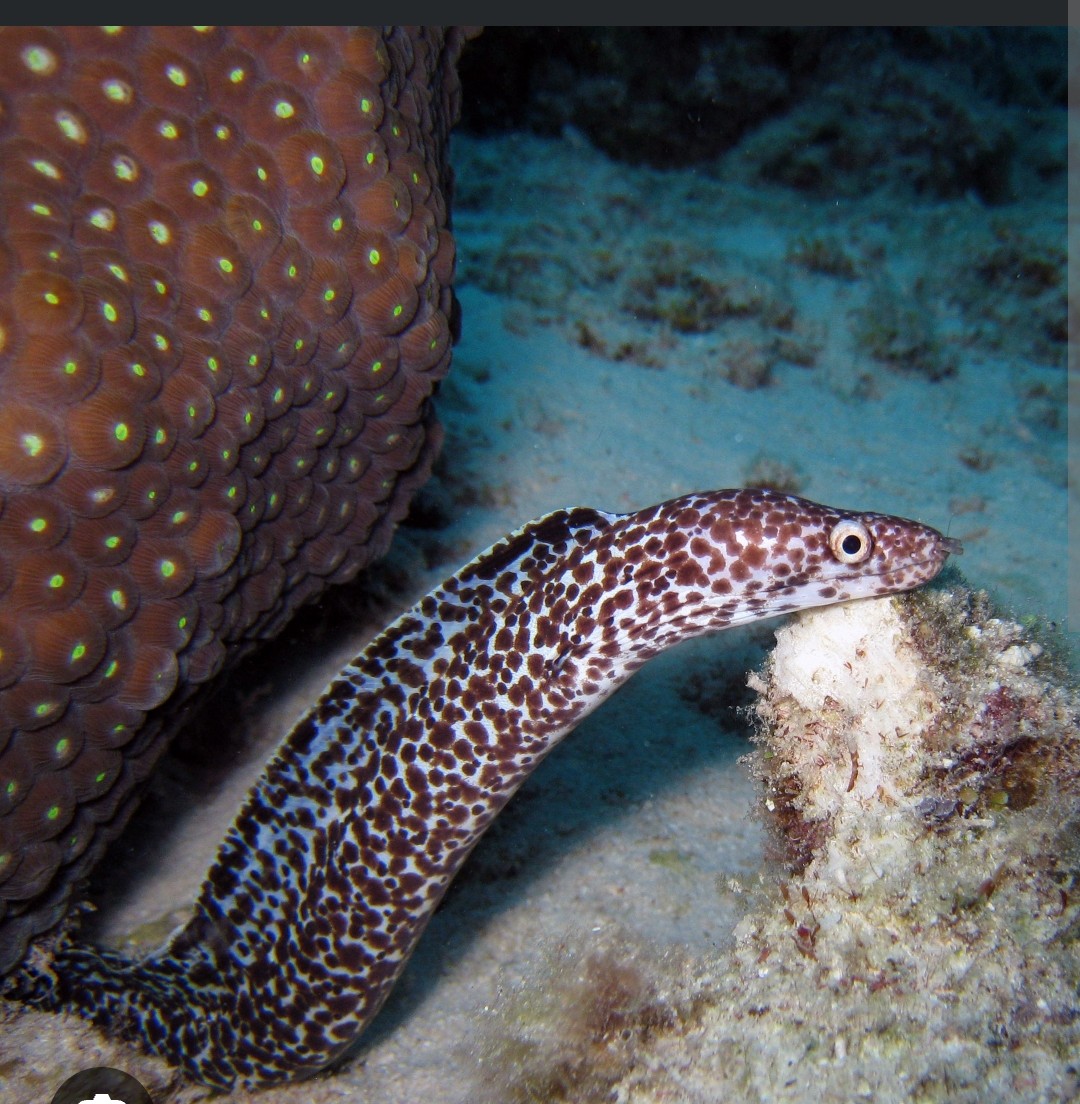
Muraenidae family
diet consists of a variety of prey, including small fish, crustaceans (like crabs), and mollusks
pale yellow or whitish bodies with distinct, overlapping brownish-purple spots that cover the entire body
Spotted moray eel
Fun fact: they are actually rather poor swimmers and have poor eyesight preferring to hunt using smell and remain in thier burrows

Muraenidae family
primarily eats crustaceans like crabs and shrimp, but also consumes small fish, clams, and squid
distinctive pattern of white or yellow spots resembling snowflakes on a dark, mottled background, with a serpentine body, a blunt snout, and a dorsal fin running along its entire length
Snowflake moray eel
Fun fact: They do not have scales to protect their skin, instead relying on mucus secretion.
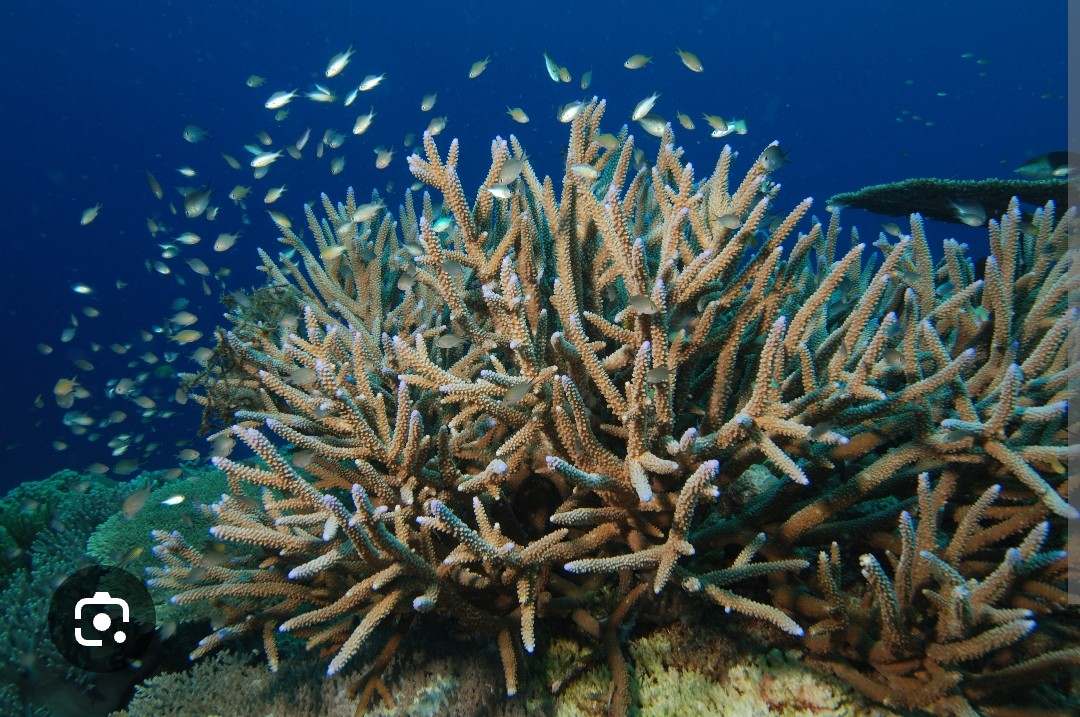
Acroporidae family
branching, antler-like appearance with slender, cylindrical branches that grow in clusters and interlock to form a framework
Antler or staghorn Coral
Fun fact: Comprising 35% of the coral mass of the entire planet
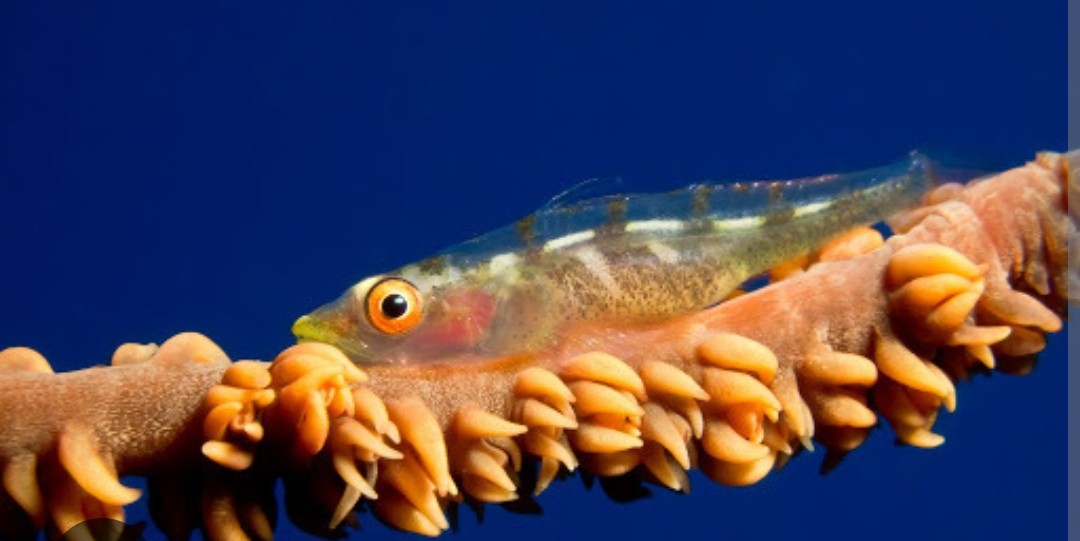
Gobiidae family
diet consists mainly of zooplankton, which it catches from the water, and it may also consume mucus or polyps from its host coral
small, semi-transparent fish, about 3 to 3.5 cm long, with a body that is often a mix of reddish-brown to violet and translucent
Wire Coral Goby
Fun fact: They are not commonly kept in aquariums due to the difficulty of maintaining their specialized habitat.
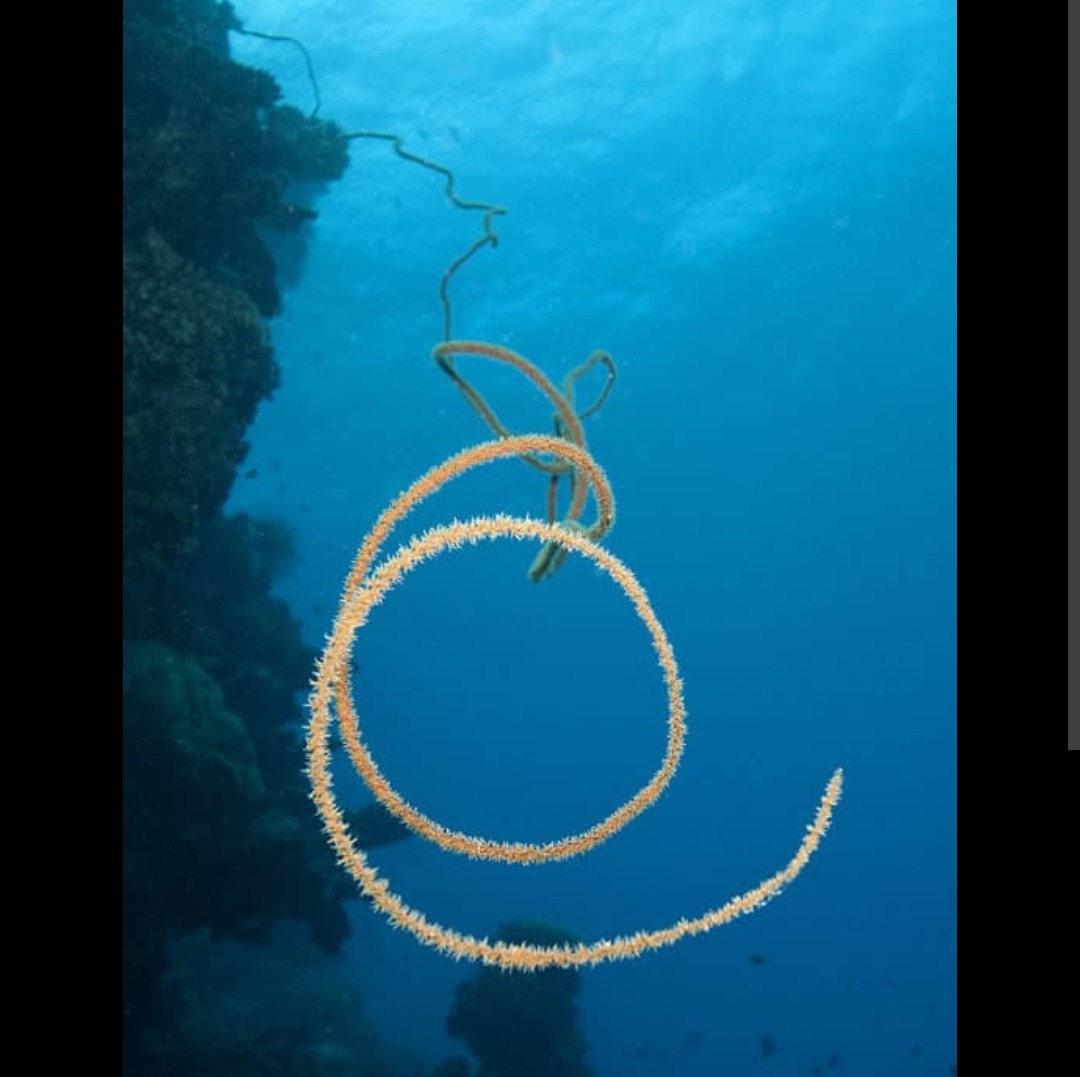
Antipathidae family
single, long, slender stalk that can grow several meters in length. The stalk may be straight or, more often, coiled or twisted in a tight spiral, resembling barbed wire or a corkscrew.
Wire Coral
Fun fact: The coiling allows the coral to maximize its filtration surface while remaining flexible in strong ocean currents.flexible skeleton made of a protein called antipathin.
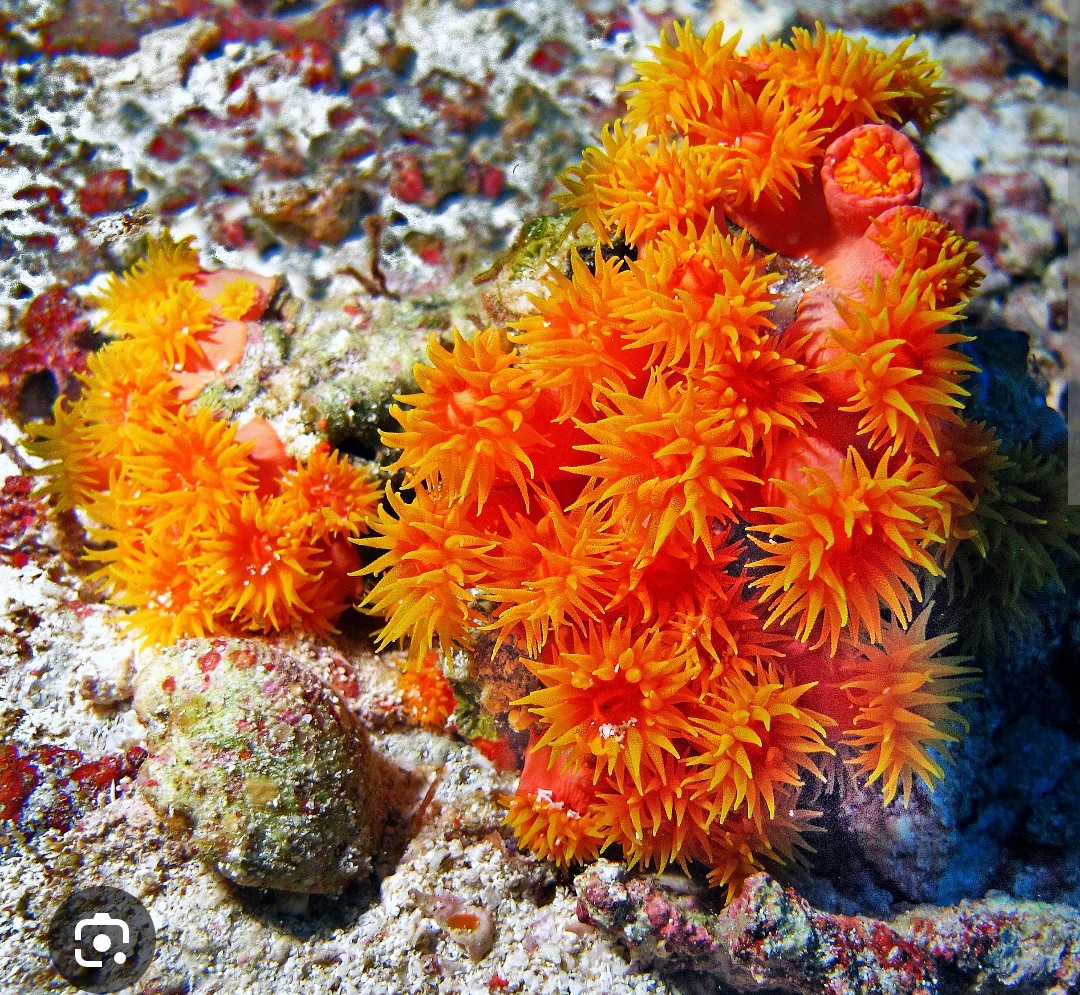
Dendrophyliidae family
bright orange or yellow polyps and a tubular, star-like structure
Orange Tube Coral
Fun fact: non-photosynthetic coral that must catch its own food (like zooplankton) using stinging cells, or nematocysts, on its tentacles.
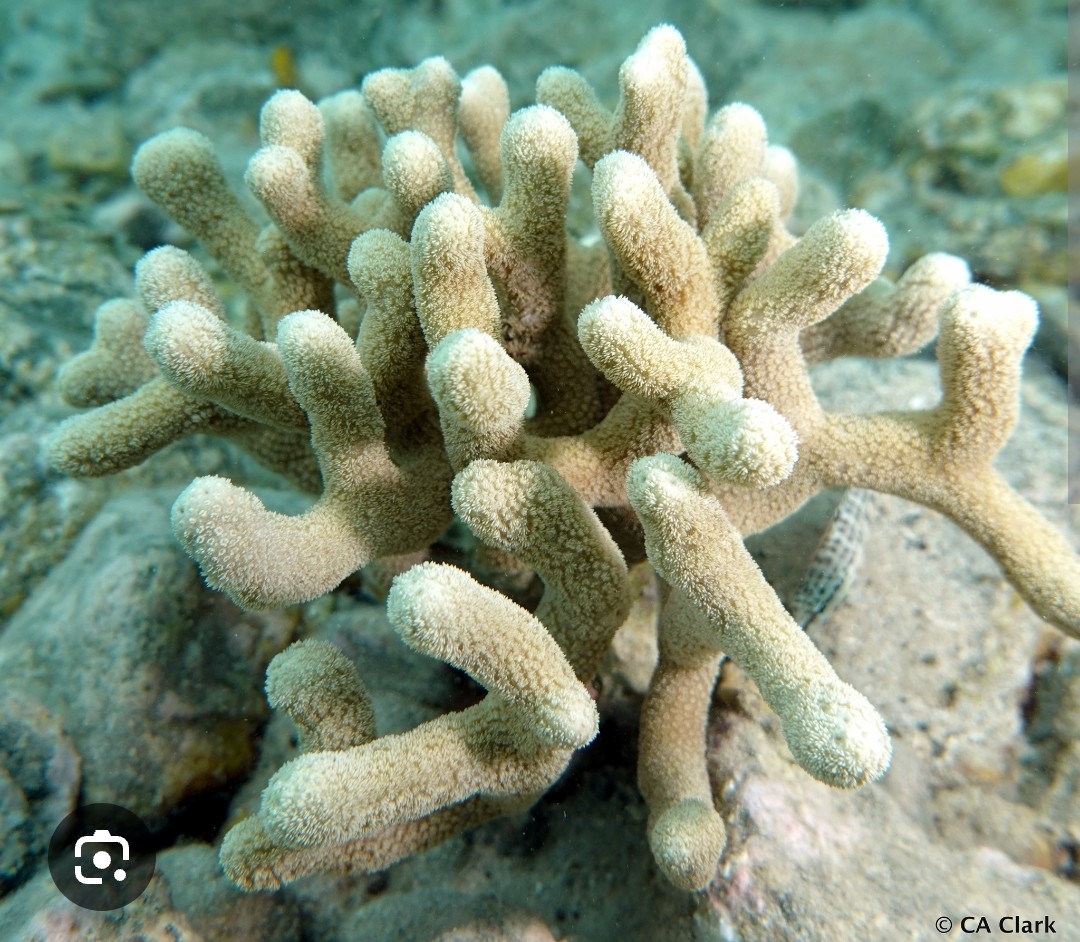
Poritidae family
form irregular patches of blunt, finger-like lobes that are pale blueish-grey to white. can be densely packed or widely spaced. Lobes can be up to 1 inch (2.5 cm) wide and are often curved or hooked.
Finger Coral
Fun fact: some species can live for over 1,000 years
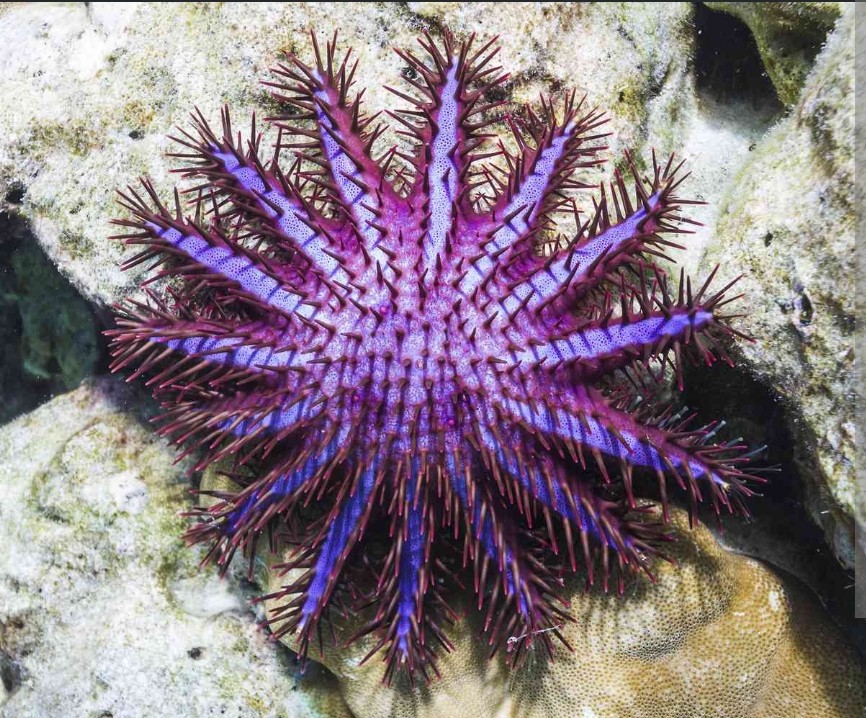
Acanthasteridae family
their diet primarily consists of live coral, such as rice, lace, and cauliflower corals
large, disc-shaped sea star, typically with 15 or more arms, covered in sharp, venomous spines that can be red, green, or purple
Crown of Thorns
Fun fact: they evicerate thier stomachs to eat thier prey
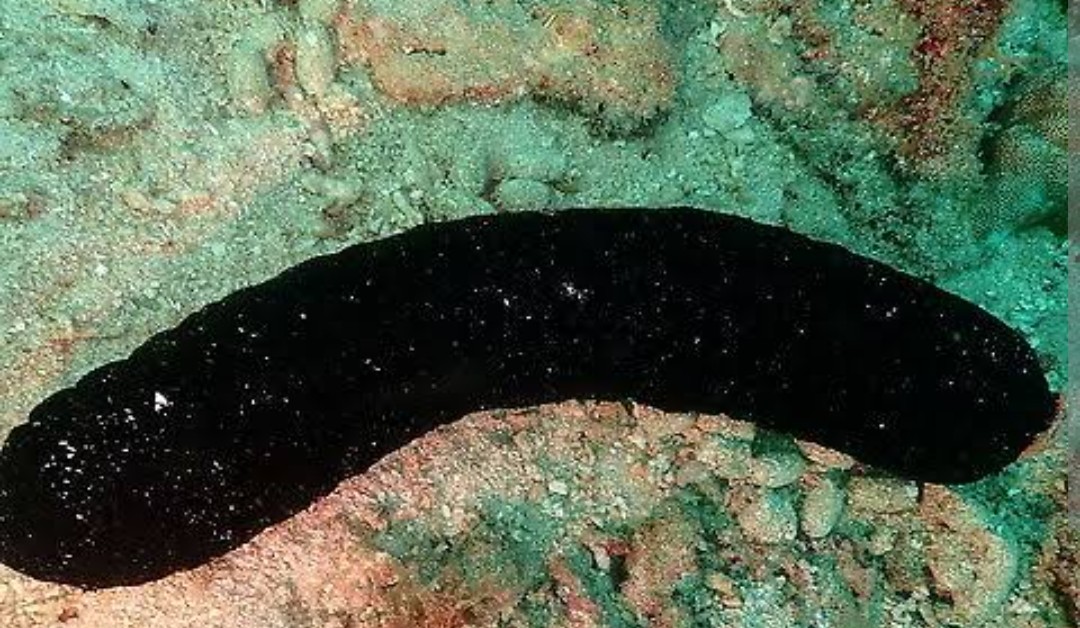
Holothuriidae family
detritivores (or omnivores) that feed on organic matter by ingesting sand and debris from the seabed
black in color and are shaped like a cucumber or a sausage.
Black Sea Cucumber
Fun fact: Capable of digesting biofilm on sand, it “cleans the sea floor”, finding food in ocean sediment.
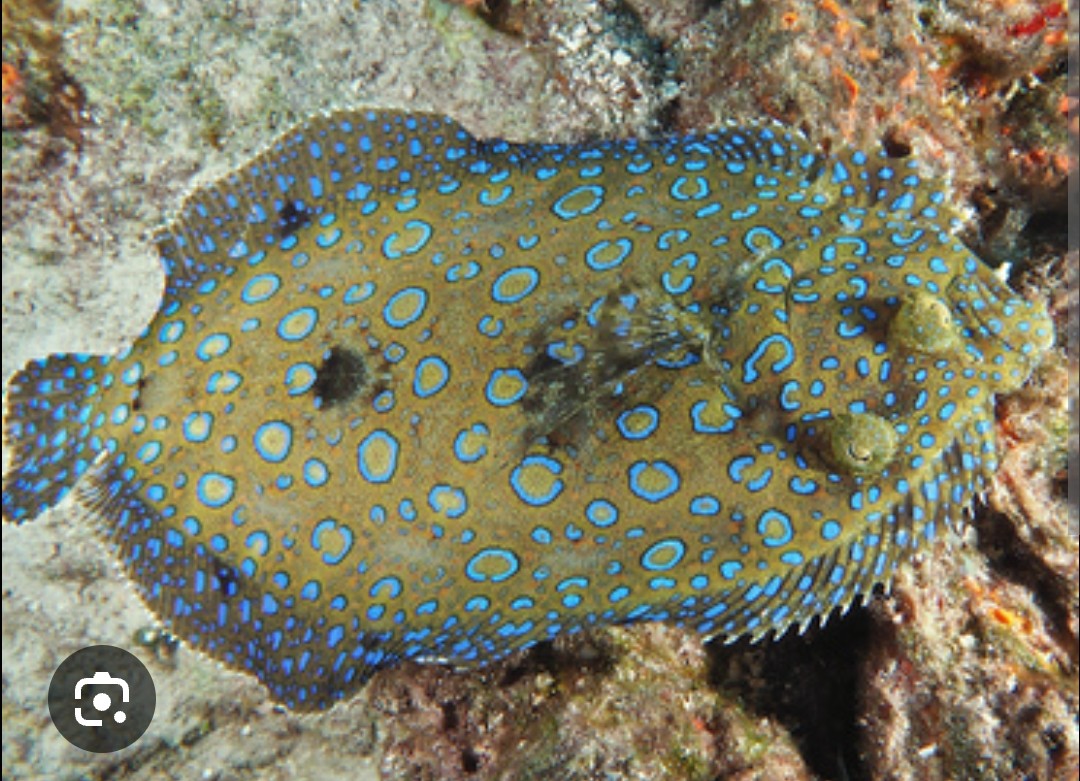
Bothidae family
eats small fish and crustaceans, and sometimes octopuses
grayish-brown body with numerous blue spots, rings, and rosettes, along with three large dark blotches along the lateral line. Larger individuals may have dark bands on their pectoral fins
Peacock Flounder (pāki'i)
Fun fact: born with an eye on each side before the right eye migrates to the left as it matures

Synodontidae family
carnivorous and voracious predators, and have a diet consisting mainly of small fish and invertebrates.
have a pointed, reptile-like head, slender bodies, and a mouth full of sharp teeth. They are typically mottled brown, tan, or green to blend in with their sandy or rocky surroundings
Lizard Fish (Ulae)
Fun fact: ambush predators that lie in wait on sandy or muddy bottoms, sometimes burying themselves partially in the sediment before lunging up to 6ft to catch prey like fish, shrimp, and squid
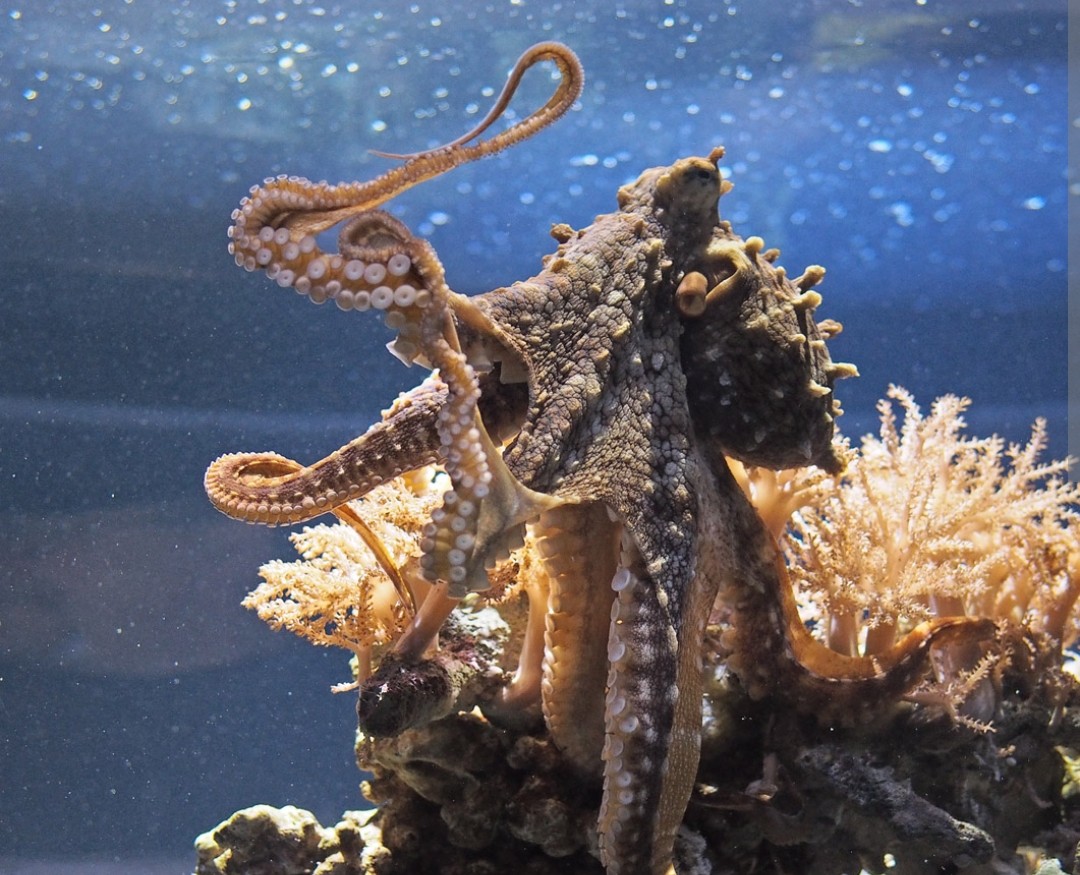
Octopodidae family
diet is carnivorous and includes a variety of prey like crabs, shrimp, fish, and molluscs
typically a mottled brown or tan color and can change its appearance dramatically using specialized cells to camouflage with its surroundings. Features dark, oval false eye spots (ocelli) at the base of its arms.
Day Octopus (he’e mali)
Fun fact: hunts during the day by pouncing or injecting venom to paralyze them
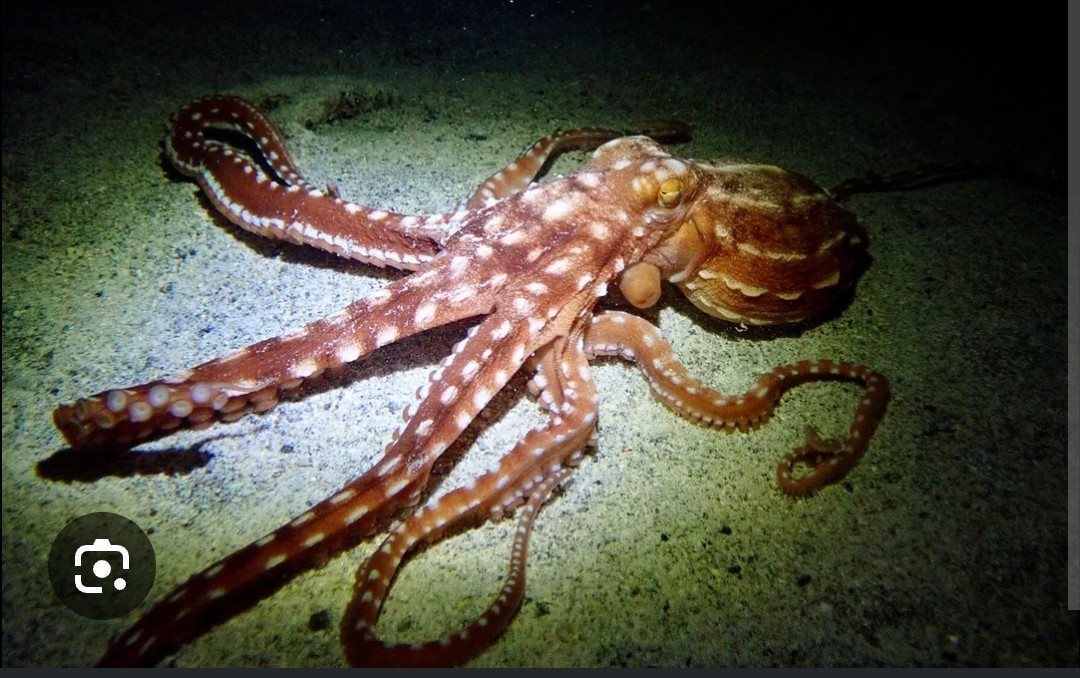
Octopodidae family
feed on crustaceans (shrimp, lobsters, crabs) and molluscs (primarily cowry snails)
rusty red animal with white spots on the body and arms.
Night Octopus (he'e mākoko)
Fun fact: active during night mainly, shelters recognized by the pile of broken crab and snail shells (remnants of past meals) found just outside the entrance. Rarely eaten but may have been used in medicine
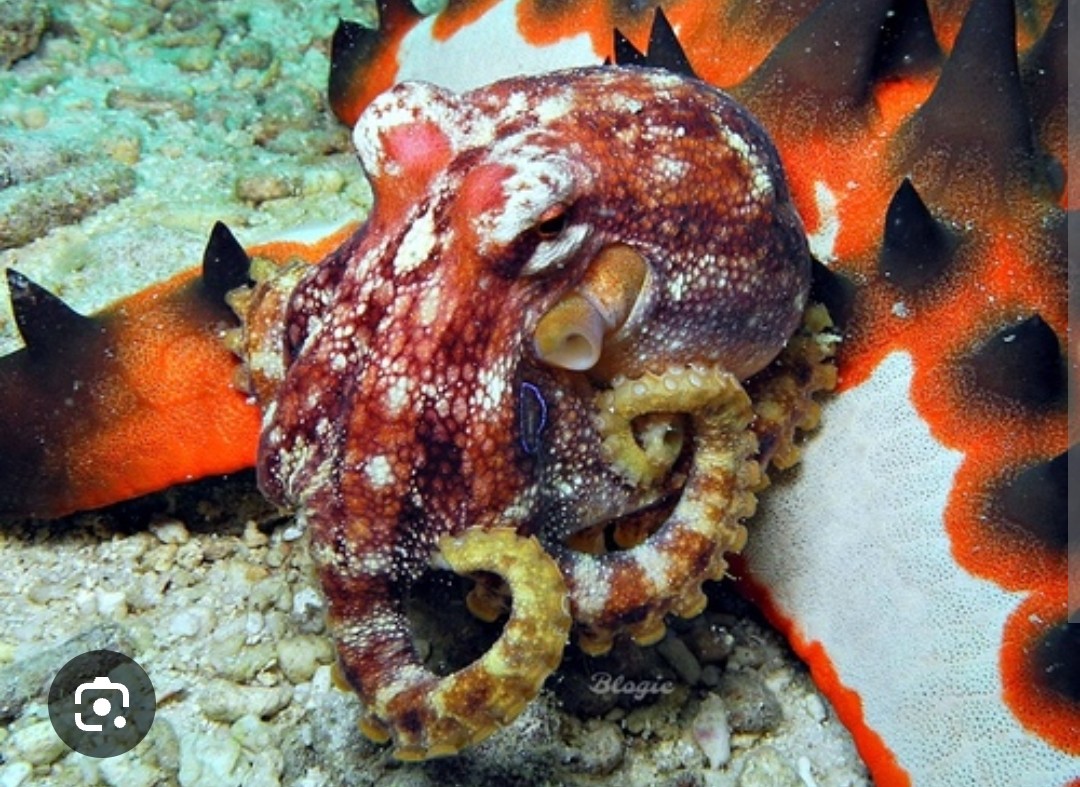
Octopodidae family
Uses venom to subdue mollusks, crabs, and fish
two pale crescent-shaped spots on its mantle, located above its eyes. It typically has a dark or mottled body, with arms that are often banded with white and have orange suckers.
Hawaiian or Crescent Octopus (heʻe hawaiʻi)
Like all octopuses, it has three hearts and blue blood. Two hearts pump blood through the gills to get oxygen, and the third pumps the oxygenated blood to the rest of the body
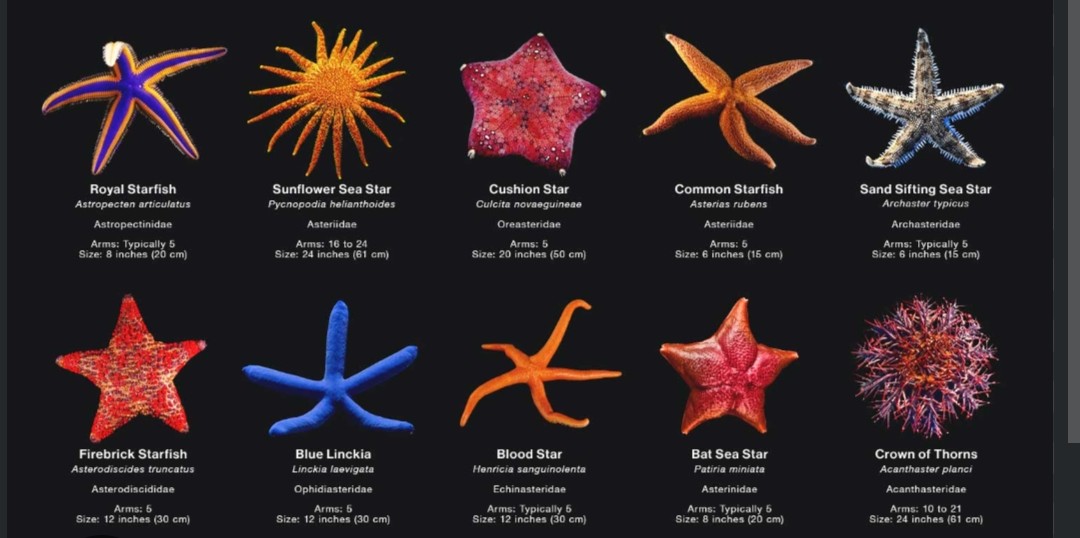
Echinometridae family
varied diet as carnivores, with many species eating mollusks like clams and oysters, while others consume sponges, coral polyps, or decomposing matter
they typically have a central disc with five to fifty arms, and their bodies can range in color from dull yellows and oranges to bright reds, blues, and purples. Their undersides are covered in hundreds of tiny tube feet that allow them to move and grip prey.
Sea stars
Fun fact: typically evicerate thier stomachs to devour thier prey
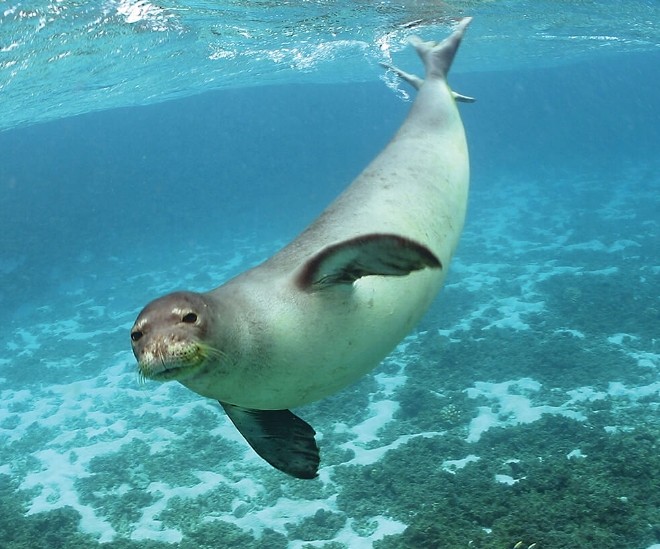
Phocidae family
Their diet is diverse, as they are "generalist" feeders, primarily consuming reef fish, cephalopods (like octopus and squid), and crustaceans such as crabs, lobsters, and shrimp
dark gray to brown on their backs and silver to tan on their bellies, with newborn pups being black.
Hawaiian Monk Seal
population has surpassed1,500 for the first time in over two decades, ongoing efforts to rehabilitate malnourished and injured individuals, and a proactive vaccination program to protect against a deadly parasite called toxoplasmosis
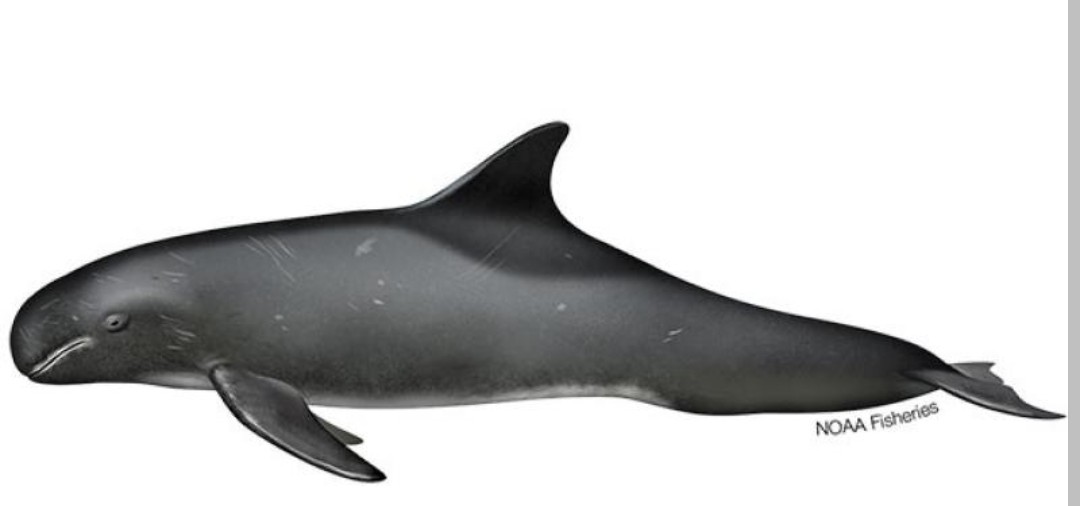
Delphinidae family
Their diet consists primarily of fish and squid, though they may sometimes hunt other small cetaceans
dark gray to black, with a rounded head, no rostrum (beak), a relatively large dorsal fin, and distinct white markings on the lips and belly.
Pygmy killer whale
Fun fact: despite being named a "whale," it is actually the smallest species in the dolphin family to have "whale" in its name
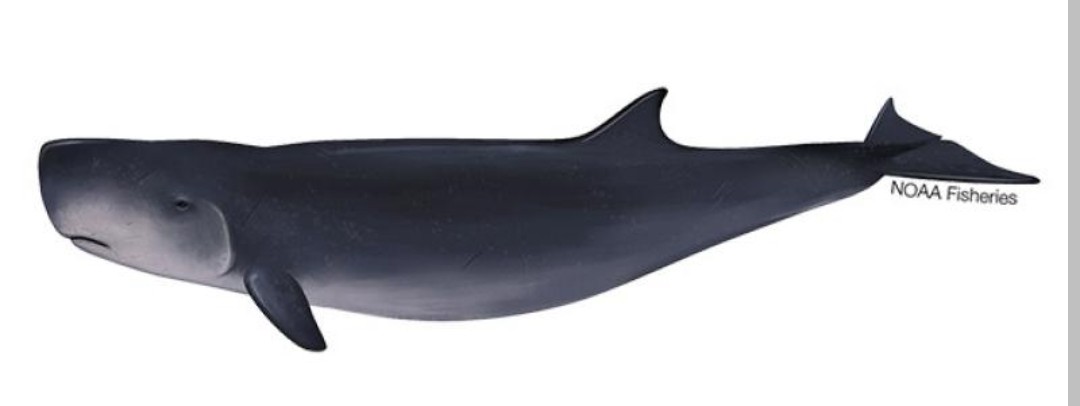
Physeteridae family
primarily eat squid and other cephalopods, though they also consume fish and crustaceans
They have a compact, gray body, a square head with a pointed snout, and a distinct marking behind the eye called a "false gill".
Dwarf sperm whale
Fun fact: They store a dark, reddish-brown, inky substance in a sac within their intestine, which they can expel to create a cloud and escape danger by confusing attackers.
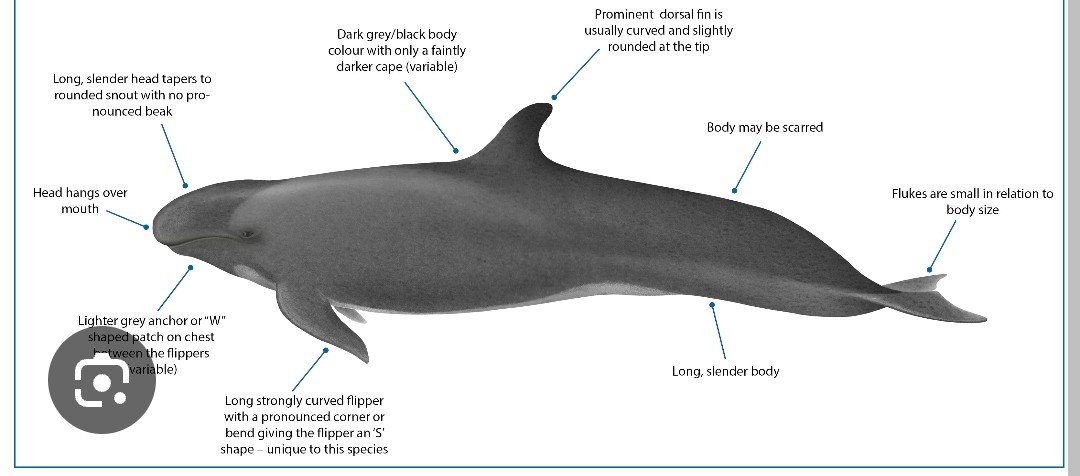
Delphinidae family
They eat fish commonly caught and consumed by humans, such as ahi (tuna), ono (wahoo) and kajiki (swordfish or marlin). They frequently share food, often saving the best parts of the fish for the oldest individuals.
large, dark gray to black with a slender, torpedo-shaped body and a rounded head without a beak. They are known for their distinctive, S-shaped pectoral fins with a central hump
False killer whale (ka palaoa)
Fun fact: despite thier name they are not closely related to killer whales, they were so named due to similarities in their skulls
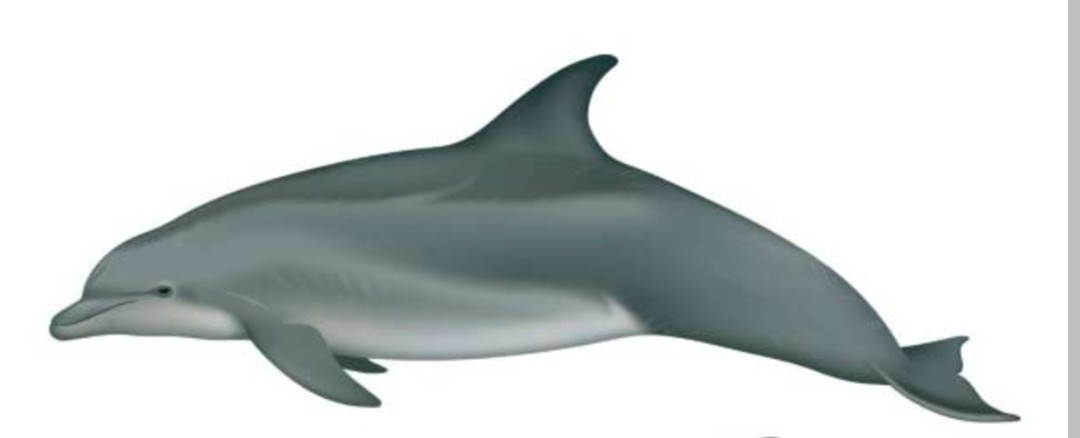
Delphinidae family
Eat fish, crustaceans, and squid
gray body that lightens to white on the belly, a sickle-shaped dorsal fin, and a short snout
Bottlenose dolphin
Fun fact: in Hawaii they use a method called "fish whacking," where they hit a fish with their flukes to stun it, sometimes knocking it out of the water before eating it
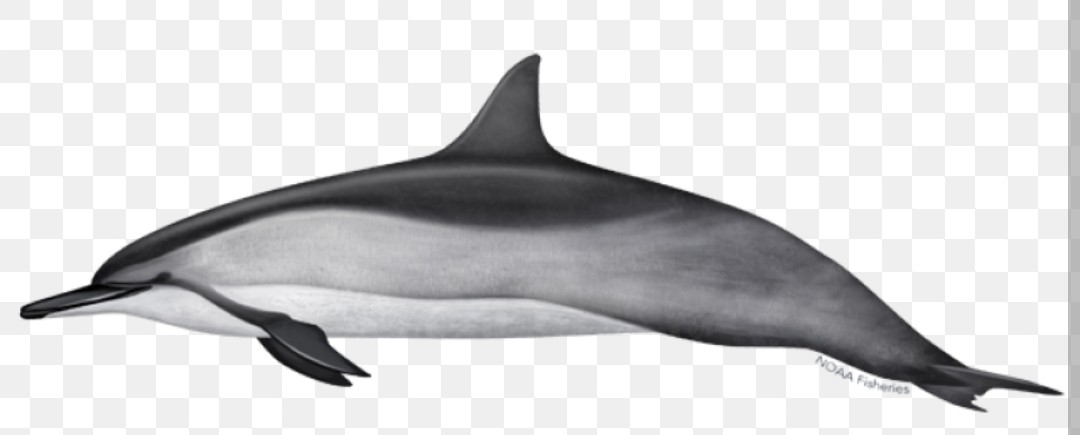
Delphinidae family
primarily eat small fish, squid, and crustaceans, often hunting cooperatively at night by diving to forage in deeper water.
slender with a long beak and a tripartite color pattern of dark gray back, light gray sides, and a white belly.
Grays spinner dolphin
Fun fact: They are known for high-energy displays at sunrise and sunset, which are both for regrouping and settling down
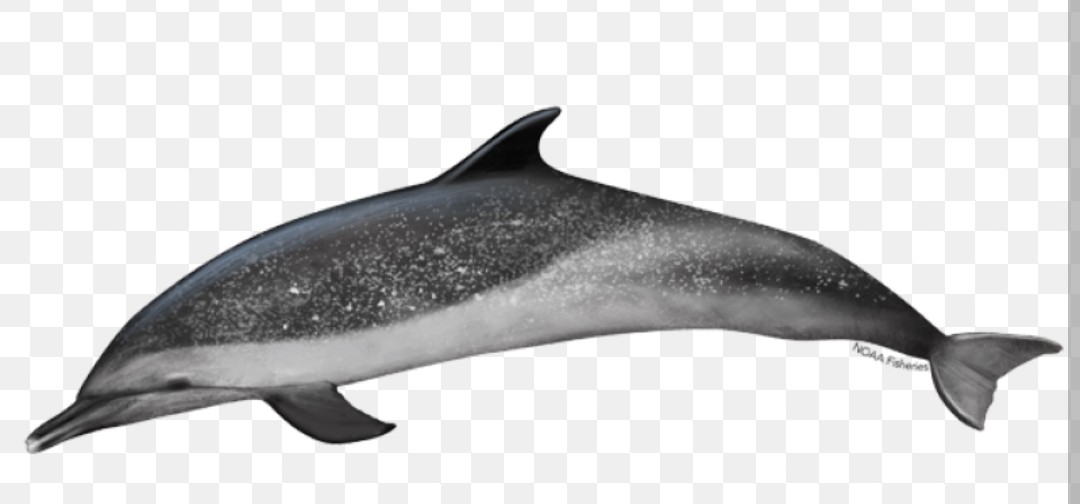
Delphinidae family
Carnivorous, feeding on a wide variety of small fish, squid, and crustaceans.
slender, streamlined dolphin with a long, slender beak that has a white tip, a tall, curved dorsal fin, and pointed flippers. Older individuals are heavily spotted
Pantropical spotted dolphin
Fun fact: they are born without spots but develop them with age, aggregate in groups up to 1,000 individuals, and can live up to 46 years old

Delphinidae family
primarily eating fish like mahimahi and squid, and are known to dive deep for prey.
dark gray body, a sloped head with no distinct beak separation, white markings on their throat, lips, and stomach, and large dorsal fins and flippers.
Rough toothed dolphin
Fun fact: they have peculiar teeth with rough surfaces, an evolutionary trait that helps them grip fish and cephalopods

Ziphiidae family
feeds on squid and small fish using suction feeding
has a dark gray or brownish-blue compact body with a long, distinct snout and a single pair of flattened tusk-like teeth erupting from lower jaw in adult males. Faint white spots dispersed on body
Blainvilles beaked whale
Fun fact: they are one of the deepest diving mammals on Earth, with a documented dive of nearly 1,600 meters (1,599 meters). They also spend up to 80% of their lives in silence, likely to avoid predators like orcas, which they can't hear at these deep, quiet depths.
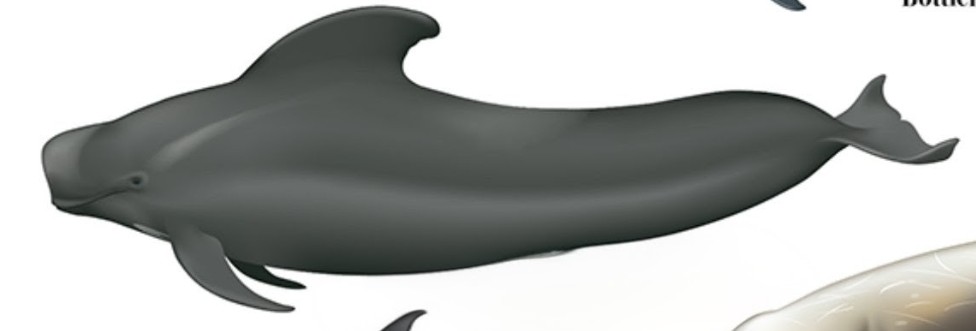
Delphinidae family
Their diet consists primarily of squid, with a small amount of fish
has a bulbous melon head with no obvious rostrum. Its dorsal fin is far forward on its body and has a relatively long base. The body is black or dark brown, with a large gray saddle behind the dorsal fin.
Short finned pilot whale
Fun fact: They are known as the “cheetahs of the deep sea” for their deep, high-speed dives to chase and capture large squid.
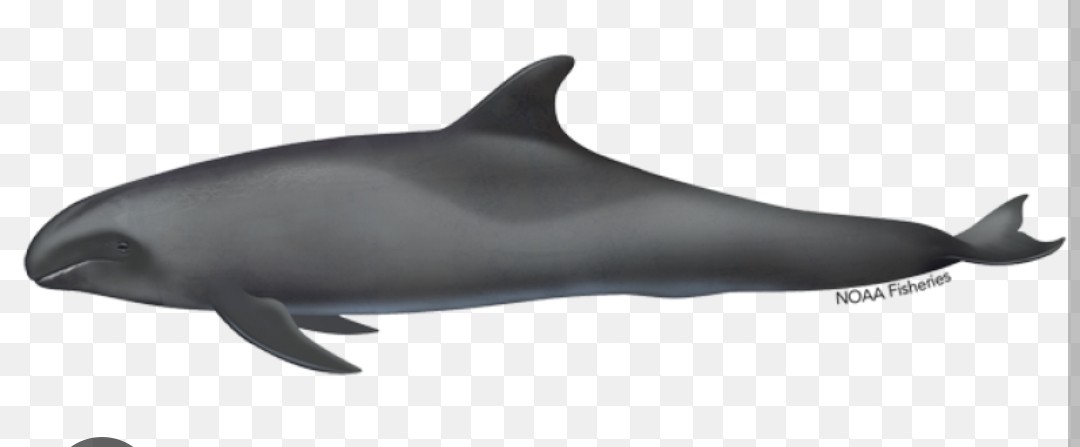
Delphinidae family
feed primarily at night on squid and small fish.
Their appearance is defined by a charcoal gray to black body and a triangular, sickle-shaped dorsal fin. dark face ‘mask’ extends from around the eye to the front of the melon and larger animals have whitish lips.
Melon headed whale
Fun facts: they are not named after a fruit but a French bowler hat

Ziphiidae family
diet consists mainly of deep-sea squid, fish, and crustaceans, which they capture using a suction-feeding method.
Dark gray to reddish-brown and a paler underside. short, "goose-like" beak and a whitish face with a dark patch around the eye. Males have two visible teeth
Cuviers beaked whale
they are the deepest and longest-diving mammals, with records of dives to nearly 3,000 meters (~2 miles) and breath-holds lasting over two hours.
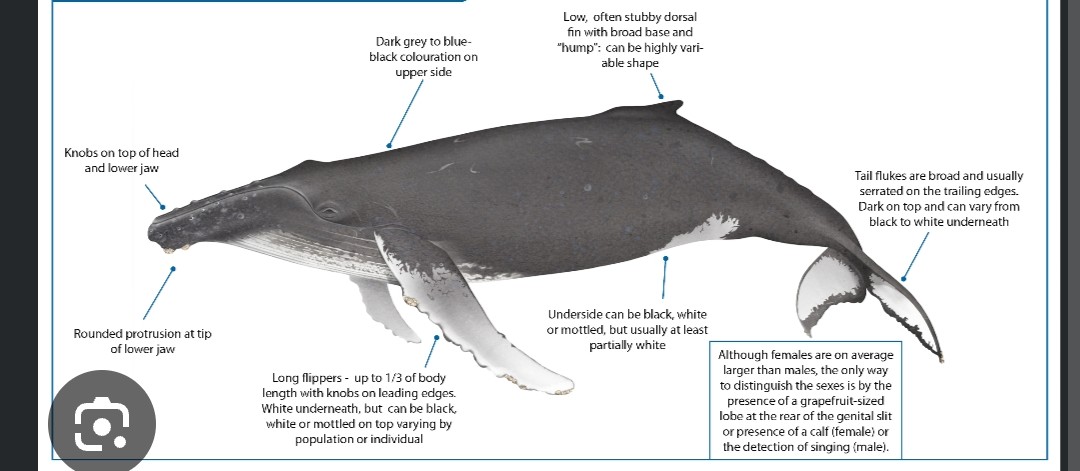
Balaenopteridae family
filter feeders and rely on small fish and zooplankton, such as krill, to make up their large diet (in hawaii's low nutrient waters they typically metabolise thier body fat until returning to Alaska)
black and white mottled underside, long pectoral fins (about one-third of their body length), and broad, serrated flukes
Humpback whale (ka koholā)
Fun fact: they musical composers of the sea, males “sing” a complex song that changes over time. Thier tail flukes vary by individual and help us ID specific individuals
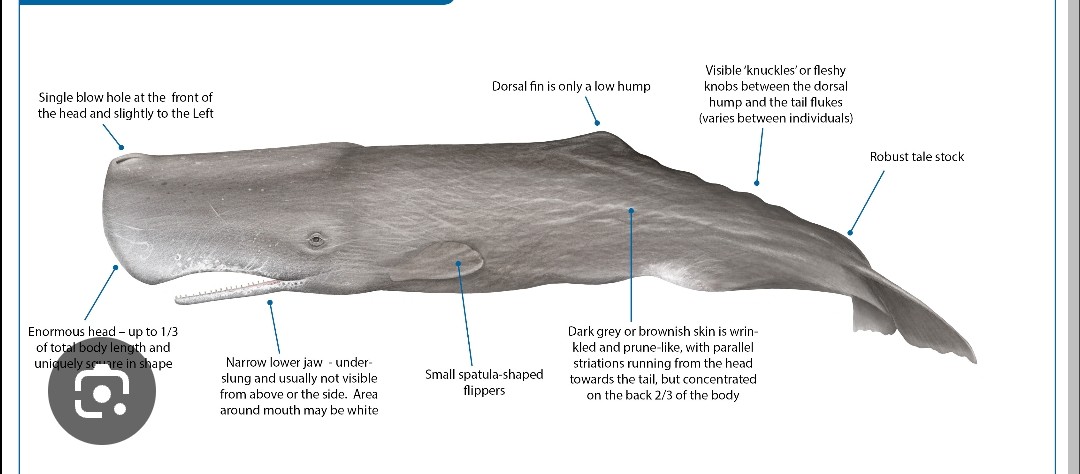
Physeteridae family
diet is varied and includes various fish, sharks, skates, and octopuses. But mainly giant squid
Dark grey with an extremely large, block-shaped head that has a single blowhole located on the left side of their head.
Sperm whale (ka palaoa)
Fun fact: they largest of all toothed whales, dive into deep waters and hunt giant squid resulting in distinct scarring near thier mouths from squid beaks. Identifiable from great distances due to sideways blow
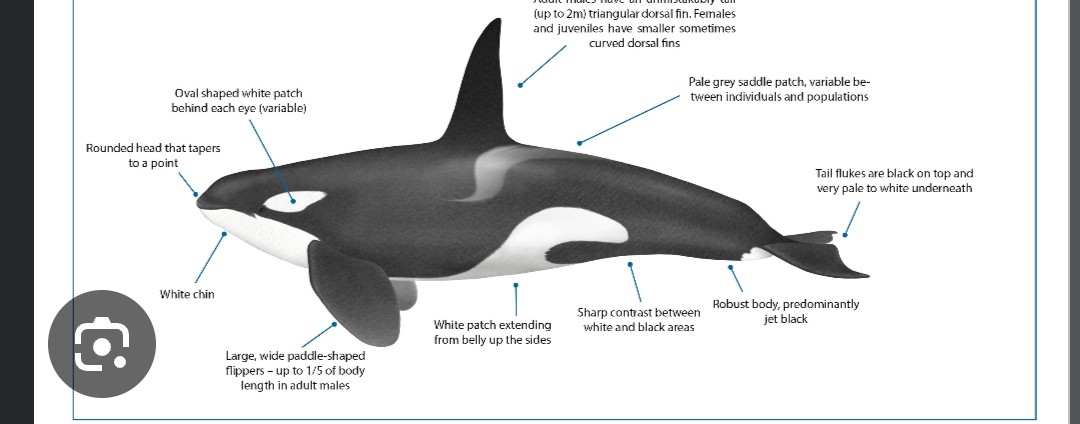
Delphinidae family
In Hawaiian waters, their diet has been documented to include: Humpback whales, Large game fish such as mahi-mahi, ono, and 'ahi, Cephalopods (like squid and octopus), Other sea turtles, Dolphins, Various other fish and marine mammals
black back and white underside, white patches near the eyes, and a gray-to-white "saddle patch" behind the dorsal fin.
Killer whale
Fun fact: not true whales, but the largest dolphins. killer whale pods are matriarchal societies and the populations in Hawaiian waters are typically transient.
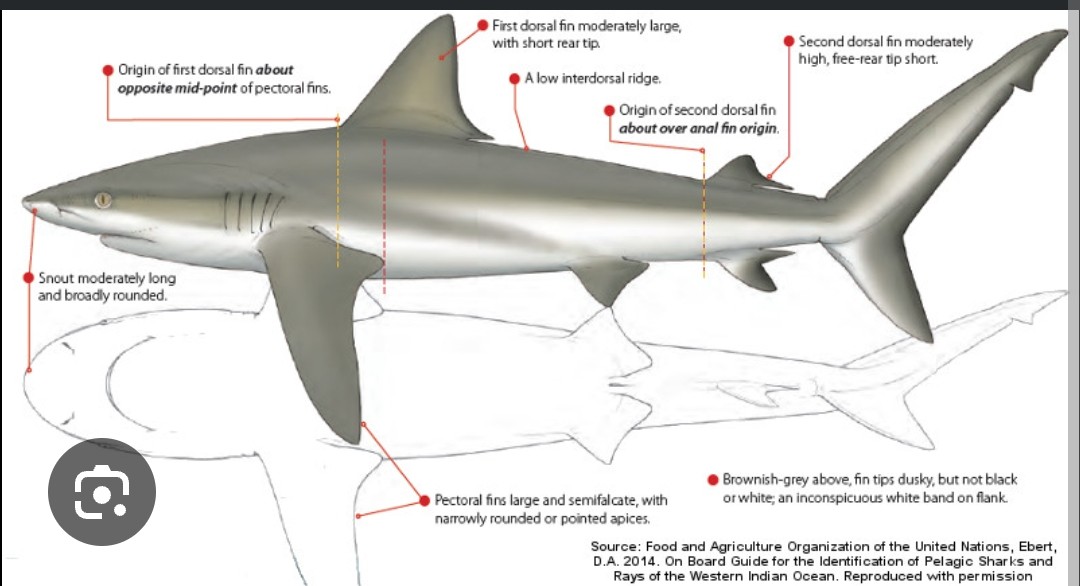
Carcharhinidae family
Eats bottom fishes and cephalopods
Brownish gray on dorsal surface; white underside; trailing edge of tail is dusky, but not black
Galapagos reef shark
Fun fact: if it ingests an indigestible object, it can push its stomach out through its mouth to expel the object before retracting it.
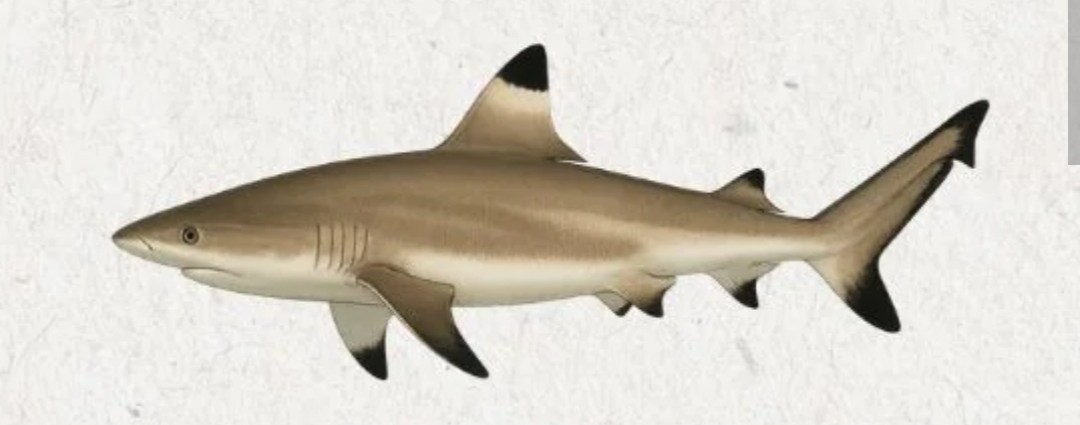
Carcharhinidae family
Eats small reef fishes and invertebrates
Light brown with large black marks on the first dorsal fin and lower tail tips; no interdorsal ridge
Blacktip reef shark (mano pa’ele)
Fun fact: unlike many sharks, these smaller bodied sharks are often seen in schools and use this social behavior to hunt

Carcharhinidae family
diet primarily consists of bony fish and invertebrates like octopuses, crabs, and lobsters,
It is a medium-sized shark with a slender, greyish-brown body and distinctive white tips on its dorsal and tail fins
Whitetip reef shark (mano lalakea)
Fun fact: contrary to popualr belief this shark can sleep on the ocean floor during the day because they do not need to move to breathe
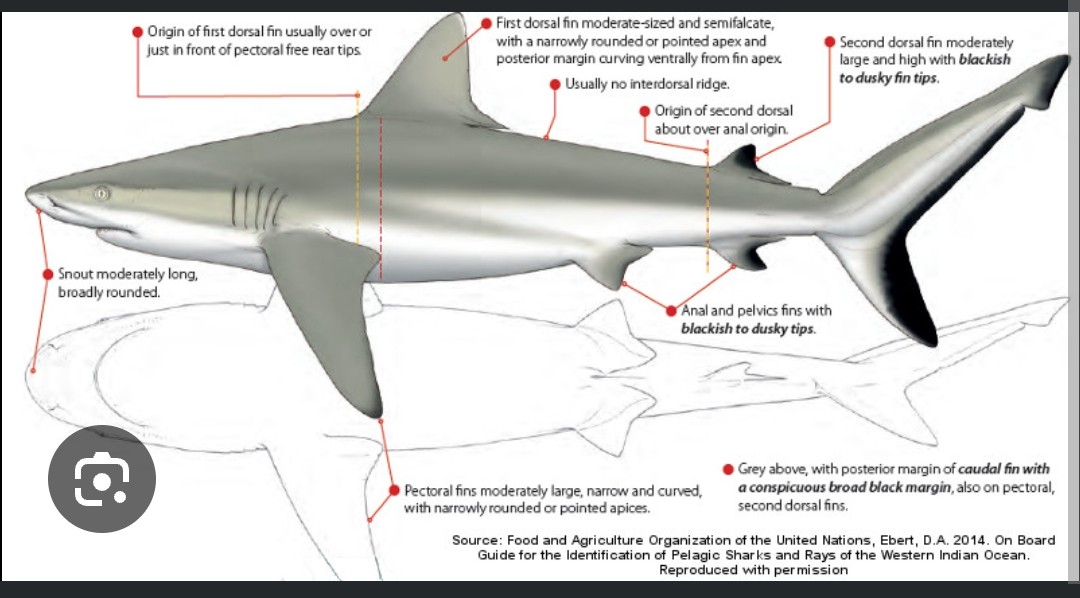
Carcharhinidae family
Eats bony fishes, cephalopods and crustaceans
Gray with a slight white streak on the back edge of the dorsal fin and an easy-to-see black margin on the trailing edge of the tail; no interdorsal ridge
Gray reef shark
Fun fact: it has a very distinctive threat display where it hunches its body and flares its pectoral fins before a potential attack
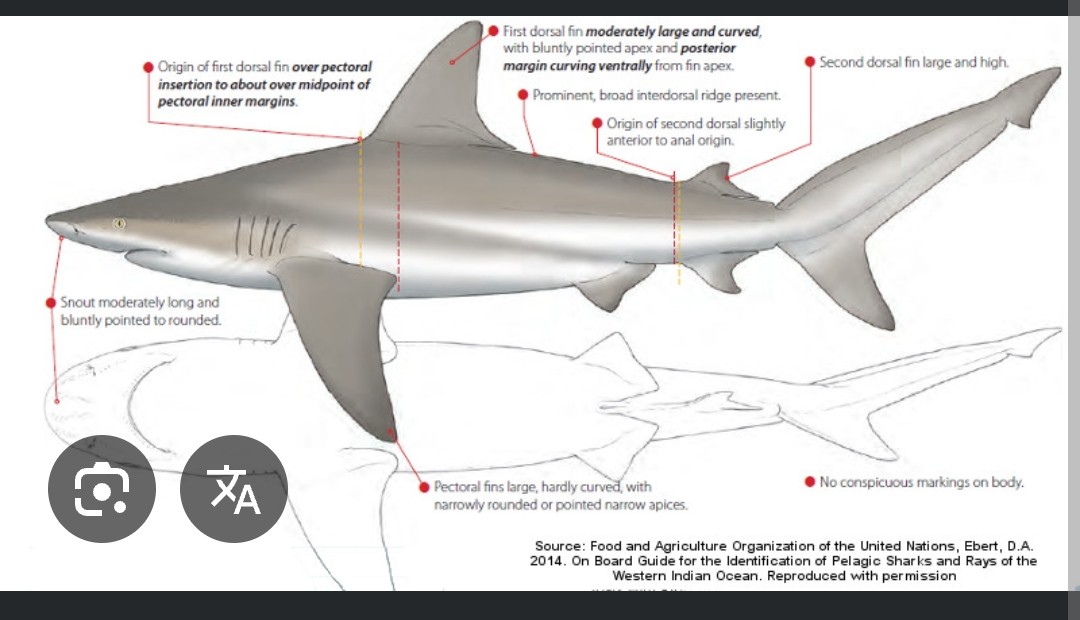
Carcharhinidae family
Eats deepwater fishes (including sharks and rays), cephalopods
Gray, large shark with prominent nasal flaps and high interdorsal ridge
Bignose shark
Fun fact: They are viviparous, meaning females give birth to live young that are sustained by a placenta
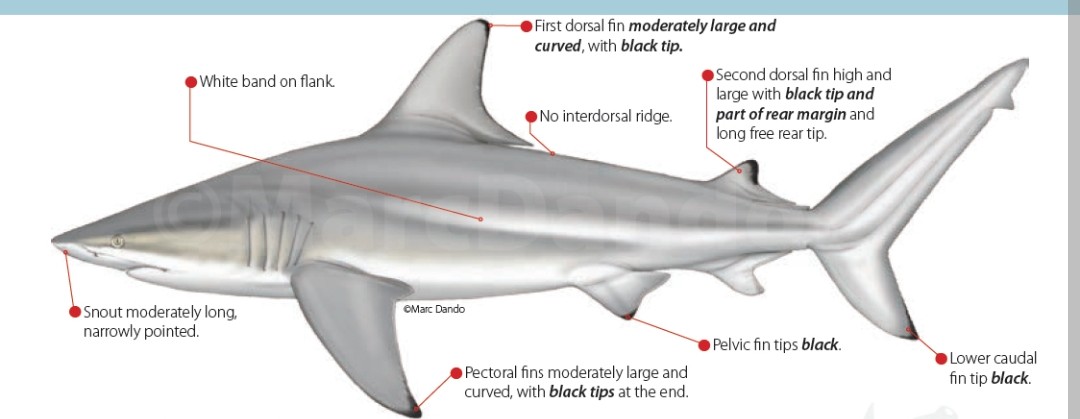
Carcharhinidae family
Eats octopus, squid, bony fishes, occasionally crustaceans
Large gray with less prominent black edges on dorsal and pectoral fins; a pointed snout
Oceanic blacktip shark
Fun fact: These sharks are known for their powerful and acrobatic leaps. When hunting schooling fish, they can propel themselves fully out of the water while spinning multiple times before re-entering.
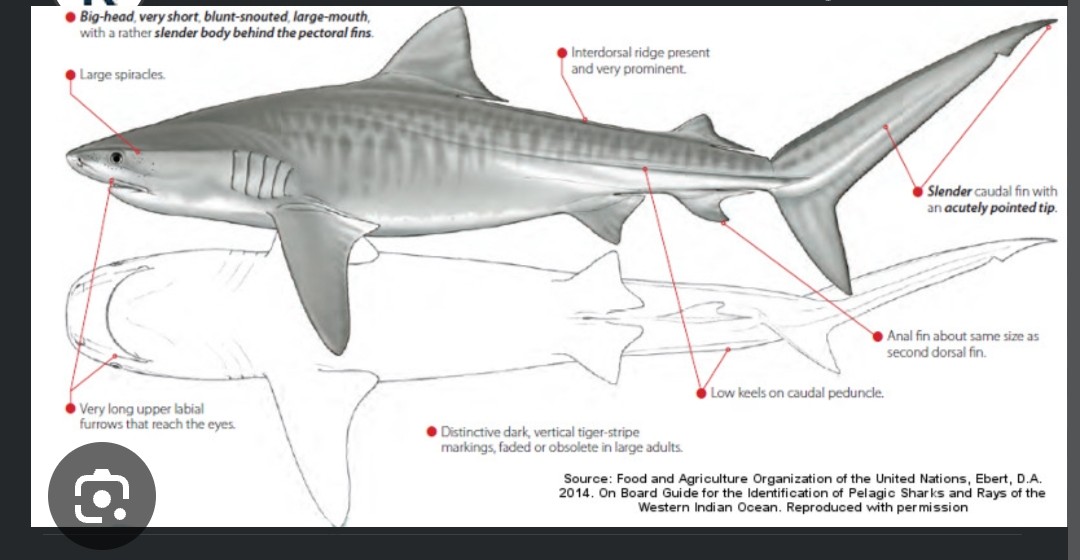
Carcharhinidae family
Eats wide variety of marine animals, carrion – has been called “garbage can of the sea”
Broadly rounded snout; distinctive curved serrated teeth; strong spotting pattern in young sharks, turning to stripes which fade with age
Tiger shark (niuhi)
Fun fact: they fourth largest shark species and known for thier highly carried diet and “eat first ask questions later” behavior
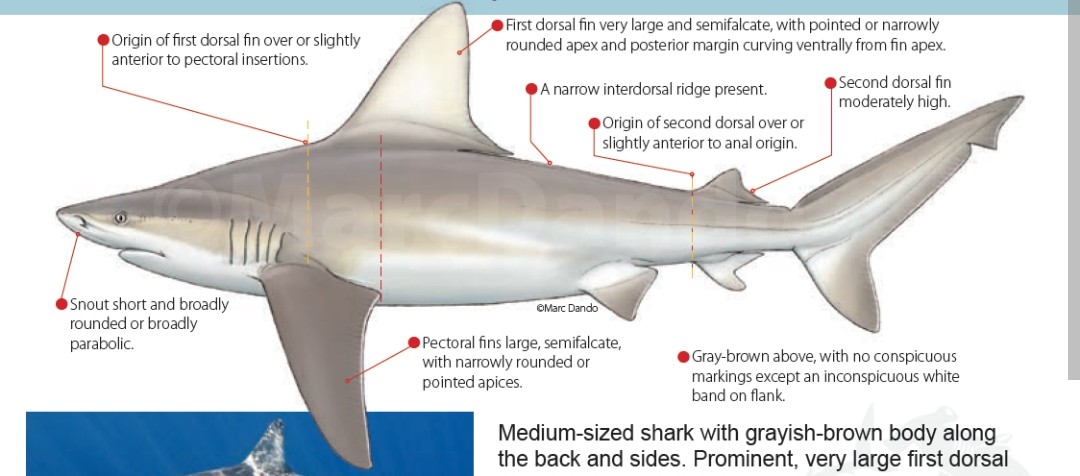
Carcharhinidae family
Eats small reef fishes, octopus and squid, crustaceans, mollusks
Gray or light tan; tall, triangular first dorsal fin that originates over the pectoral fins, strong interdorsal ridge; and no distinct marking
Sandbar shark
Fun fact: this species in named for the snady flats and estuaroes it is found on but will occasionally venture out into open water
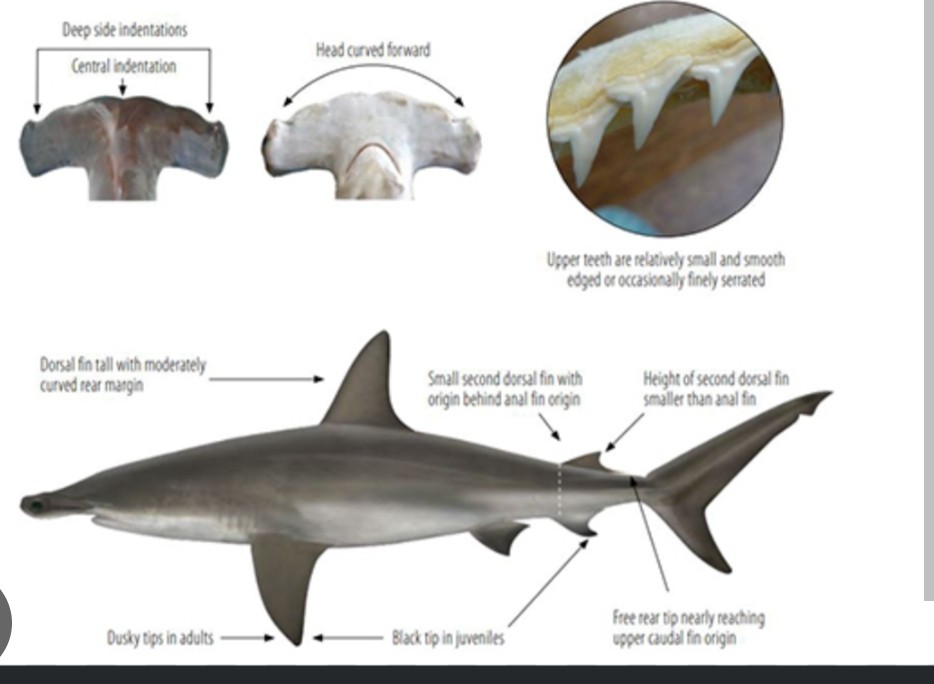
Sphyrnidae family
Eats reef fishes, sharks and rays, cephalopods, crustaceans
Gray with flattened hammer-like head with a prominent middle indentation and smaller notches on the front edge
Scalloped hammerhead (mano kihikihi)
Fun fact: the indicative notches on their hammer-shaped head are called a cephalofoil
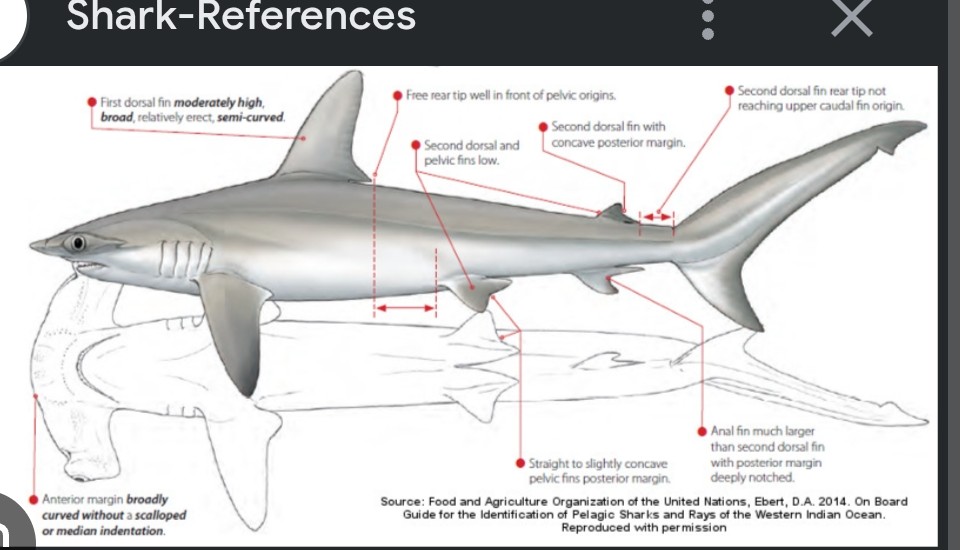
Sphyrnidae family
Eats bony fishes, small sharks and rays, cephalopods, crustaceans
Gray with a flattened hammer-like head with a smooth un-notched leading edge without median indentation
Smooth hammerhead shark (mano kihikihi)
Fun fact: it uses its unique head, called a cephalofoil, to help pin down prey like stingrays, which are its favorite food
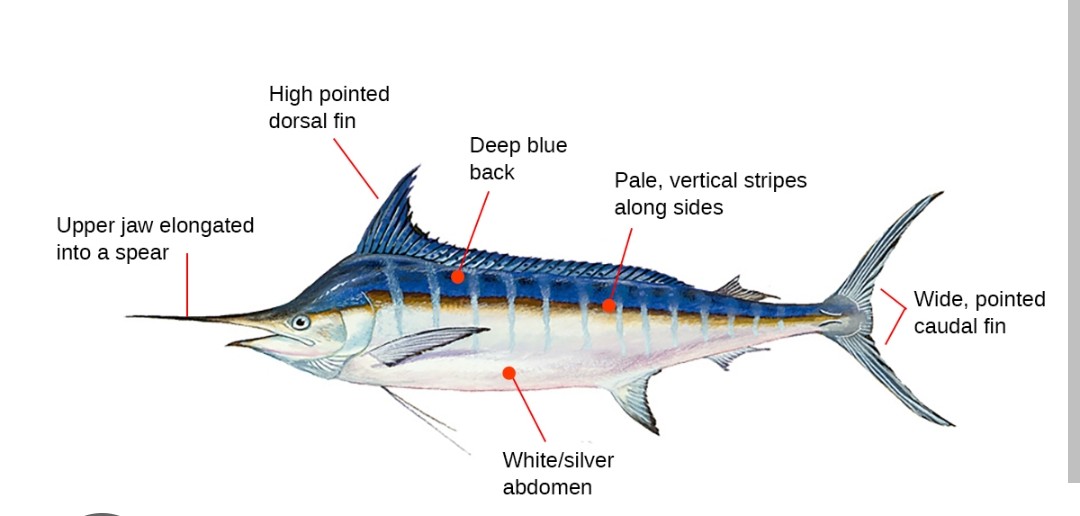
Istiophoridae family
apex predators that hunt a wide range of prey including tuna, squid, and other fish
can be identified by their large, powerful build, long bill, and distinctive blue-black coloration on top and silvery whote underside. 15 rows of pale cobalt-colored stripes on their sides
Blue marlin
Fun fact: largest billfish, known for growing to 14 feet long and over 2,000 pounds, and can travel across entire ocean basins

Istiophoridae family
They are opportunistic feeders that primarily consume schooling fish.
dark blue-black back that fades to a silvery-white belly with vertical blue stripes on their sides. long, rounded bill, a tall, pointed dorsal fin, and can be identified by their leaf-shaped pectoral fins, which can be folded flat against their bodies.
Striped marlin
Fun fact: they can swim at speeds of up to 50 miles per hour, making them one of the fastest fish in the ocean

Scombridae family
opportunistic predators with a diet consisting mainly of fish, crustaceans, and squid
torpedo-shaped body with a metallic dark blue back that fades to a silvery belly. Their most distinguishing features are their very long, bright yellow dorsal and anal fins. May have a horizontal yellow stripe along sides
Yellowfin tuna (ahi)
Fun fact: they are incredibly fast, capable of swimming up to 47mph, partly because they can fold their fins into grooves to create a more streamlined body
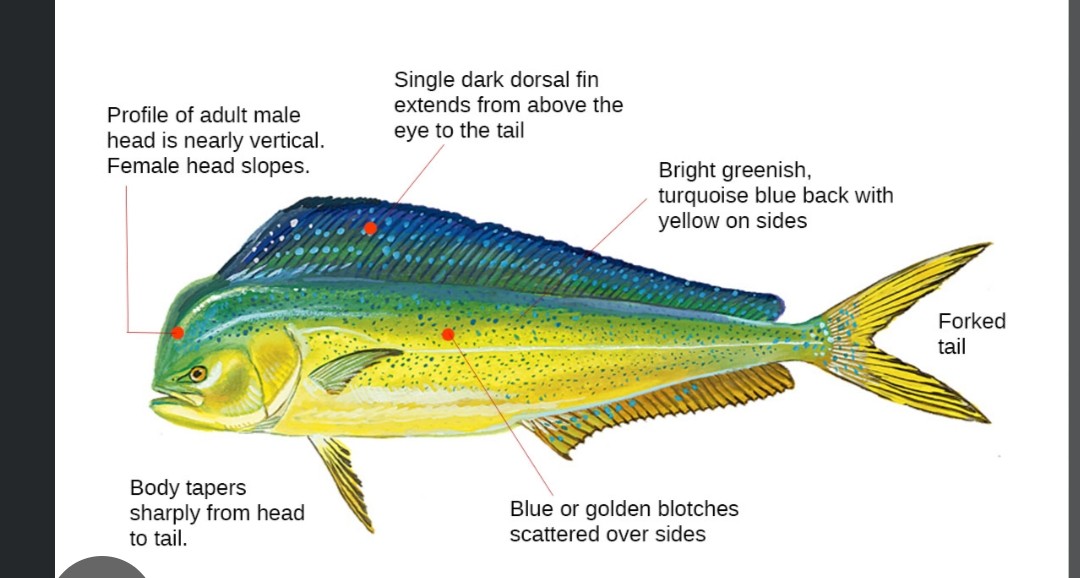
Coryphaenidae family
their diet consists mainly of other fish, crustaceans, and invertebrates. Juveniles eat a diet of crustaceans, while adults focus on fish like flying fish, mackerel, and tuna.
greenish-blue back with yellow sides and gold or blue blotches, though their colors fade to a silver or muted yellow-gray after death. Males have a blunt, vertical forehead, while females have a more sloped head profile
Dorado (mahi mahi)
Fun fact: one of the fastest-growing fish in the ocean, capable of reaching over four feet in length in just their first year and a half
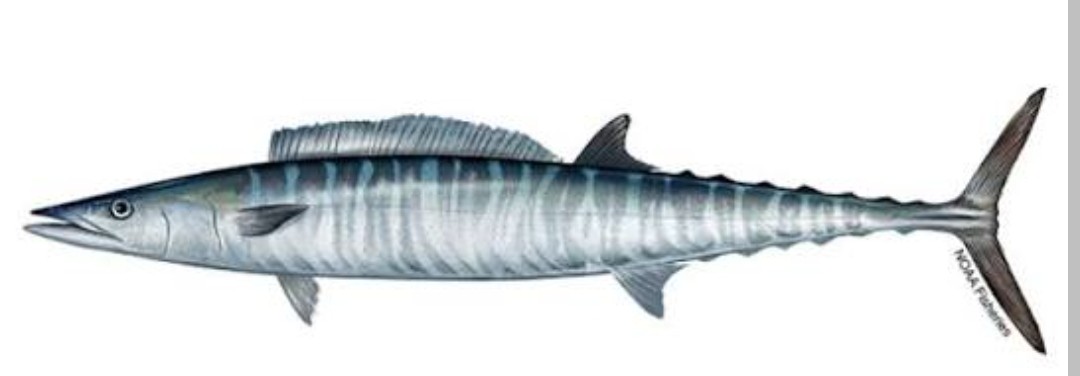
Scombridae family
Their diet is diverse, consisting mainly of other fish and squid, and includes species like frigate mackerel, butterfish, porcupinefish, and round herring
long, slender, streamlined body with a pointed snout, and are steel blue on top, fading to a pale blue or silver below. They are distinguished by 25 to 30 dark, vertical, wavy bars along their sides. Very sharp teeth
Wahoo (ono)
Fun fact: Stories exist of them launching themselves out of the water and into boats, once reportedly through a galley window
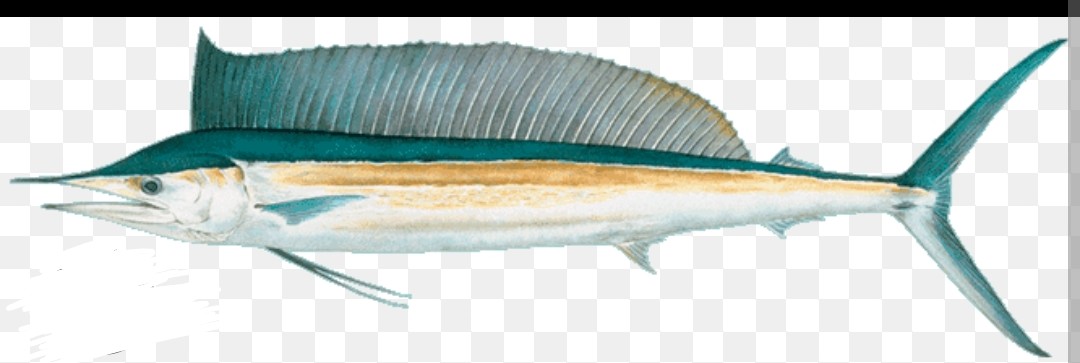
Istiophoridae family
diet consists mainly of small to medium-sized fishes and squids
slender, elongated body that is dark blue on top and silvery-white on the bottom, with a very short bill. It features a high, triangular first dorsal fin and is covered in small, triangular scales.
Pacific short-nosed spearfish
Fun fact: despite having the shortest bill of any billfish, it is a highly valued game fish often caught for sport
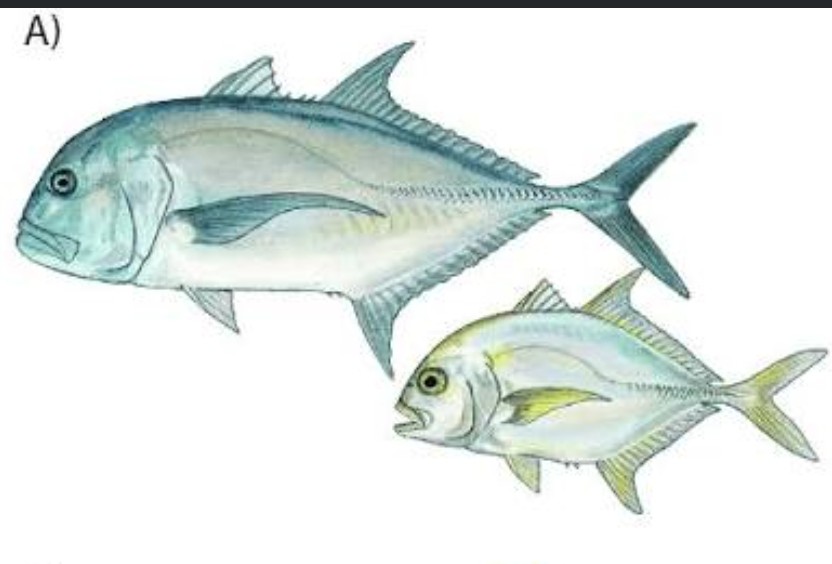
Carangidae family
Their diet is opportunistic, consisting mainly of fish and various crustaceans, but they are also known to eat cephalopods, eels, and even birds
large, silvery-grey fish with a steep head profile and a distinct black spot at the base of its pectoral fins
Giant trevally (ulua)
Fun fact: known for unique hunting behaviors, such as following other predators and using explosive speed to hunt both in the water and, in some cases, by leaping from the water to catch seabirds
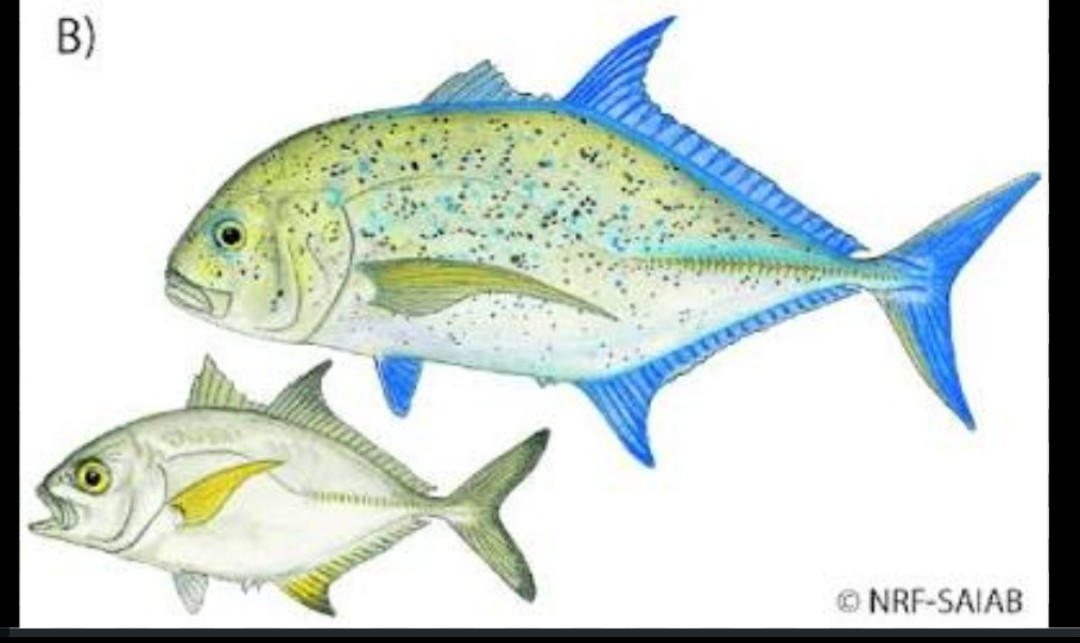
Carangidae family
opportunistic predator with a diet of small fish, crustaceans, squid, and other invertebrates. Adults mainly eat fish, squid, and crustaceans, while juveniles consume a higher percentage of crustaceans before shifting to a more fish-based diet as they mature.
sleek, brassy-colored fish with electric blue fins and a pointed snout. Its body is covered in small blue-black spots that become more numerous with age
Blue fin trevally (omilu)
Fun fact: uses countershading to its advantage with a dark back invisible from above and a light belly indistinguishable from the surface of the water
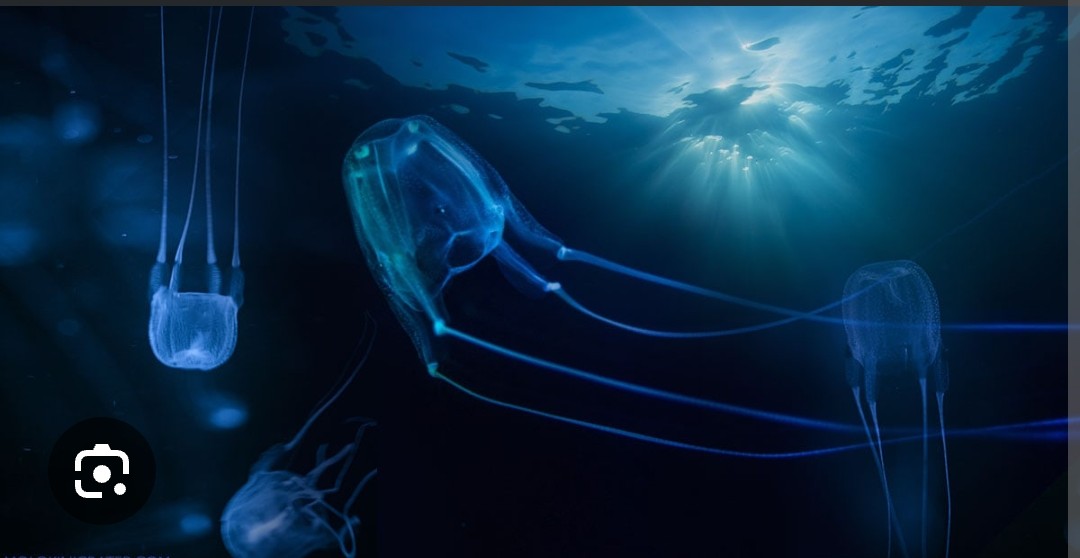
Alatinidae family
Their diet consists primarily of small fish and crustaceans like shrimp, which they actively hunt with thier nematotocycts
transparent, cube-shaped bell, often pale blue or colorless, with a size that can range from a grapefruit to a basketball. It has up to 60 long, venomous tentacles (up to 10 feet long) that hang from the corners of its bell
Box jellyfish
Fun fact: Has 24 eyes, some with a lens and retina, that are organized into four clusters called rhopalia, but it lacks a brain. Like all jellyfish it has cnidocytes on its tentacles that house harpoon-like structure called a nematocyst, they are one of the most venomous creatures on the planet
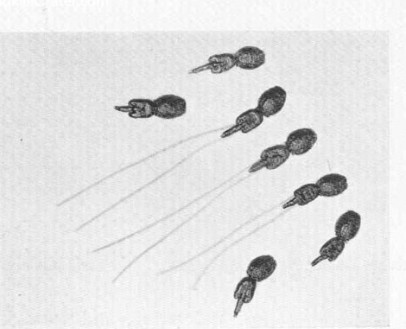
Aequoreidae family
appear as specks of pepper or near-invisible pinheads in the water
Sea lice
Fun fact: known to cause Seabather's eruption, in which they are trapped under a bathing suit, stinging, and causing rash
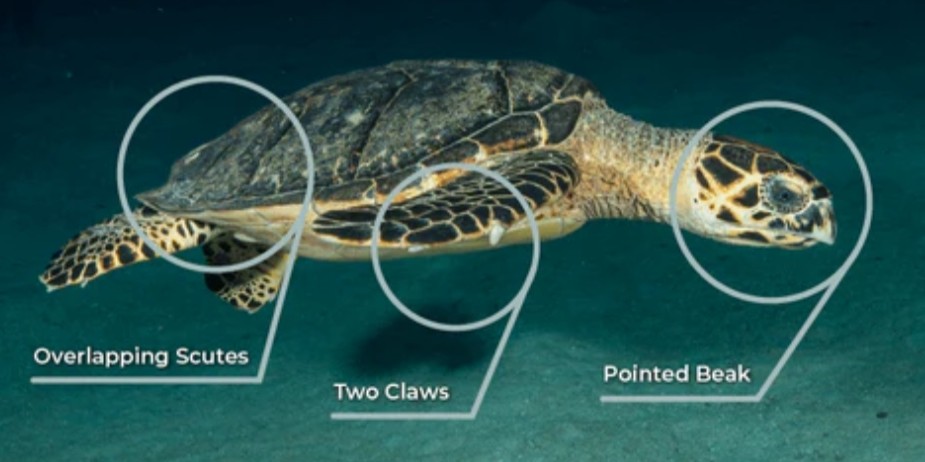
Cheloniidae family
omnivores, but their diet consists primarily of sea sponges (making up 70–95% of their food). They also eat a variety of other marine life and plants, including algae, corals, jellyfish, mollusks, and crustaceans
narrow, bird-like beak and a unique shell with thick, overlapping scutes that create a serrated edge. Their shells have a mottled pattern of amber, brown, orange, and black, and their heads have two pairs of prefrontal scales. The flippers are also noteworthy, each featuring two claws
Hawksbill sea turtle or ‘ Ea
Fun fact: they eat mainly sponges that are toxic to other animals, which occasionally made its flesh toxic as well, they are also the only sea turtle to nest exclusively on the main Hawaiian islands
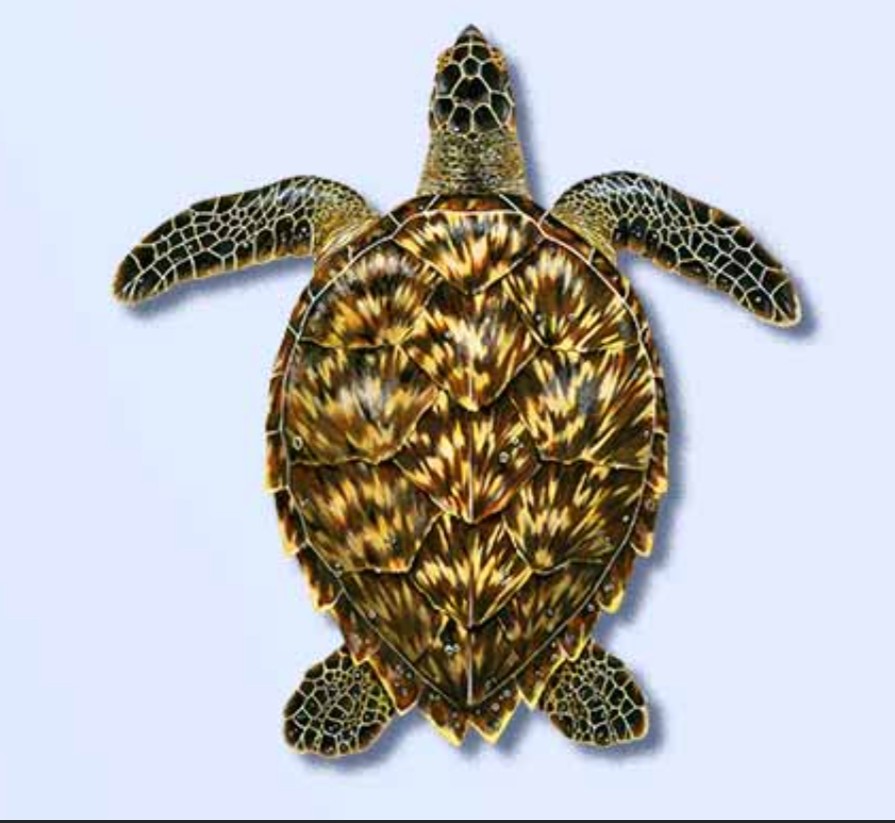
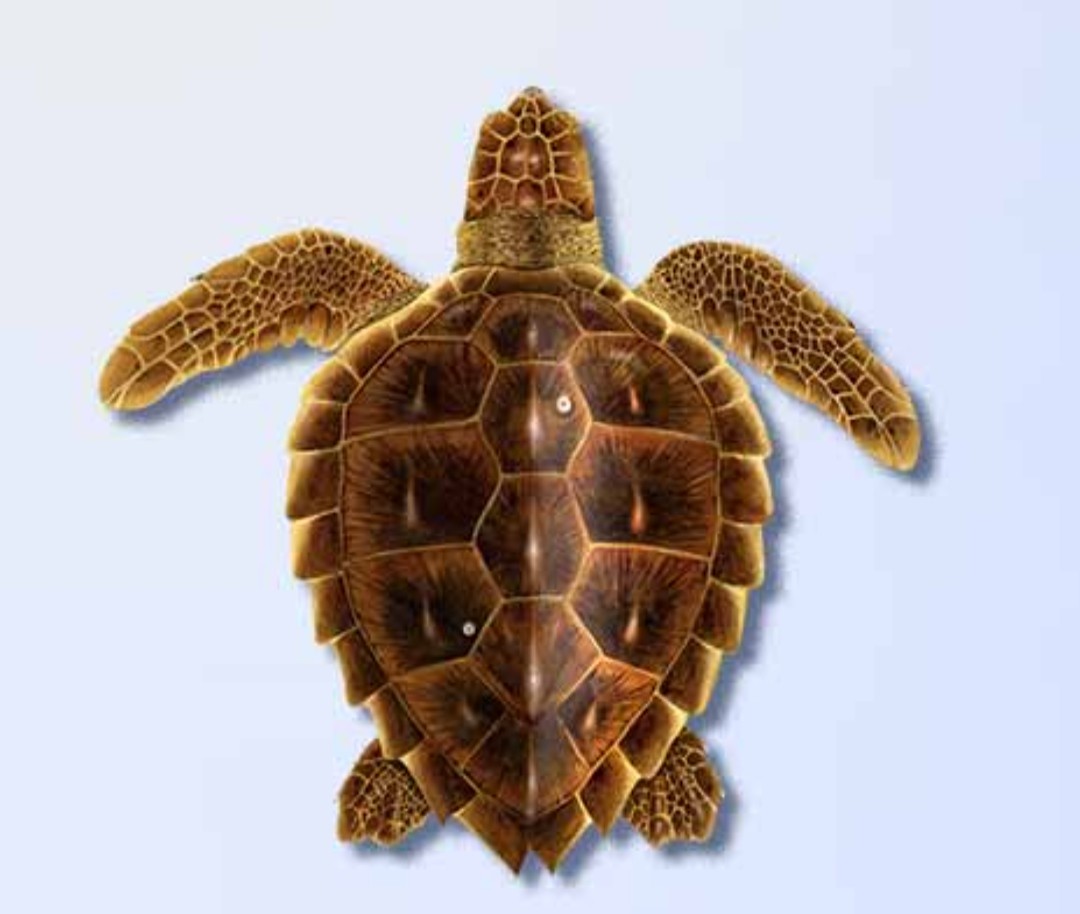
Cheloniidae family
carnivores, primarily feeding on hard-shelled invertebrates like mollusks (goose-neck barnacles, pelagoc purple snails), crabs, and horseshoe crabs, but also consuming fish and jellyfish
large heads, powerful jaws, and reddish-brown, slightly heart-shaped carapace. Other key traits include a yellowish underside (plastron), two claws on each front flipper, and more than one pair of prefrontal scales on the face
Loggerhead sea turtle
Fun fact: rarest species in Hawaii, named for thier strong jaws, keystone species because thier eating habits consisting of calcium rich shells which then feed animals on ocean floor
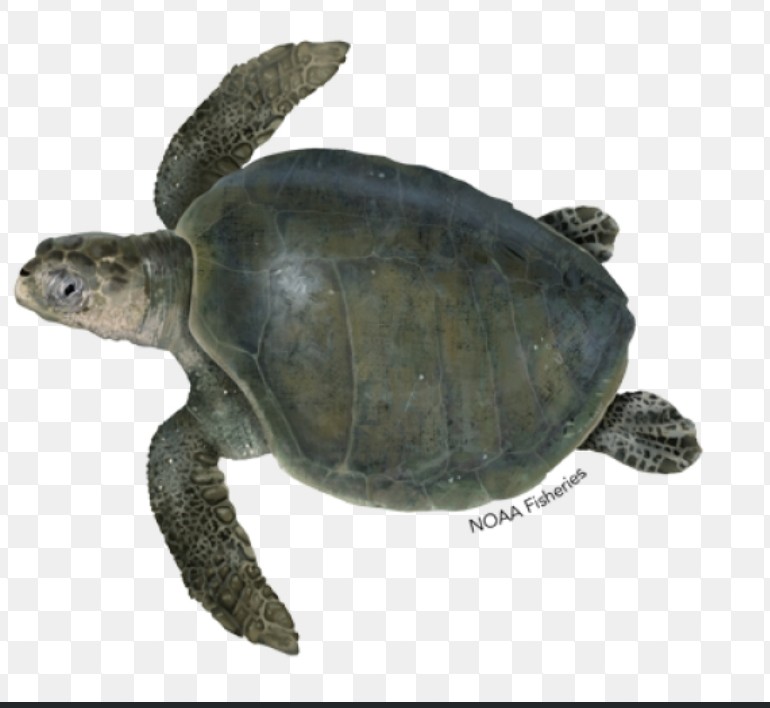
Cheloniidae family
Their diet is omnivorous and includes a wide variety of invertebrates like shrimp, crabs, and jellyfish, as well as fish and algae.
heart-shaped, olive-colored shell, which has a variable number of scutes (plates) that often have divisions
Olive riddley sea turtle
Fun fact: worlds smallest sea turtle species and the most common of all sea turtle species
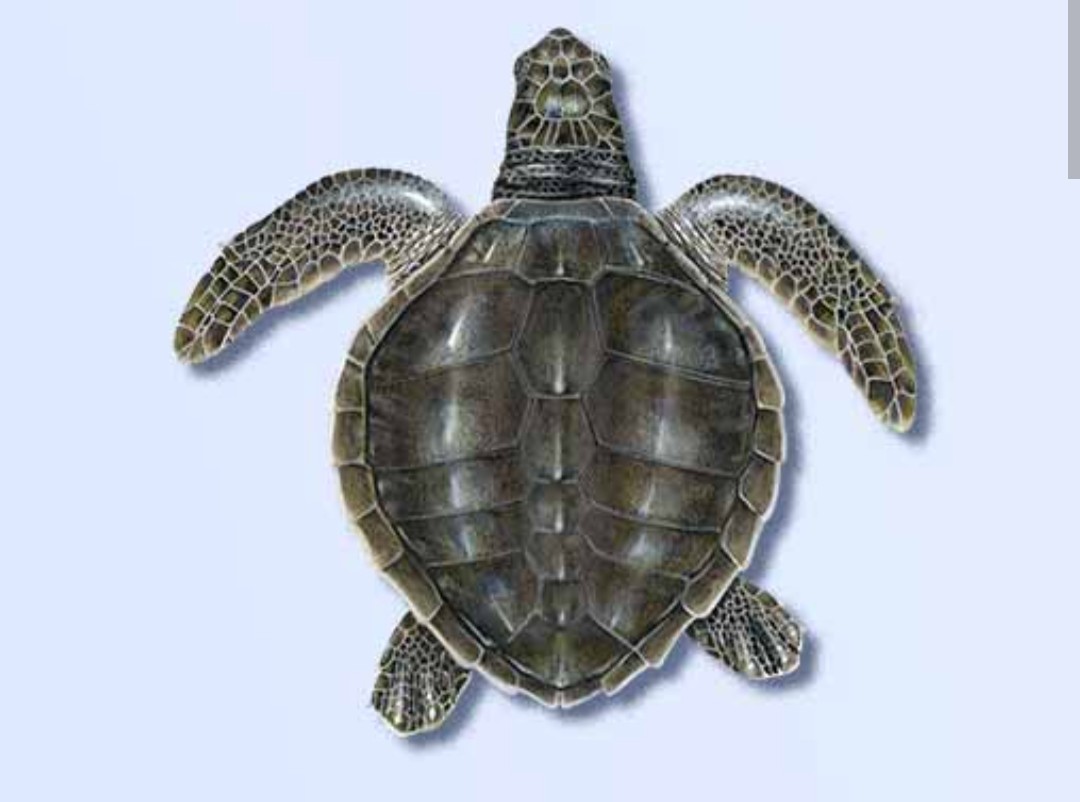
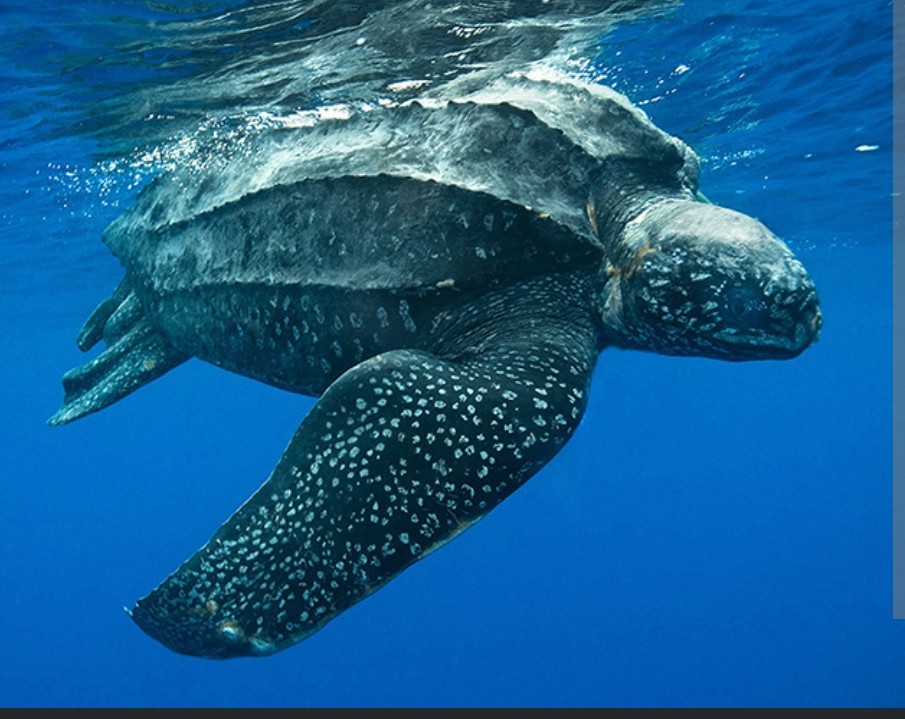
Dermochelyidae family
diet primarily consisting of soft-bodied marine animals like jellyfish, Portuguese man-o-wars, and tunicates, though they also eat squid, fish, and crustaceans
leathery, non-bony shell with seven ridges, unusually long front flippers, a mostly black or dark blue color with pink and white splotches, and a very large size
Leatherback sea turtle
Fun fact: they are the largest of all sea turtles, with the largest on record weighing 2,000 lbs, can dive deeper than any other turtle, and are the only species that doesn't have a hard, bony shell, instead having a tough, leathery skin on their backs
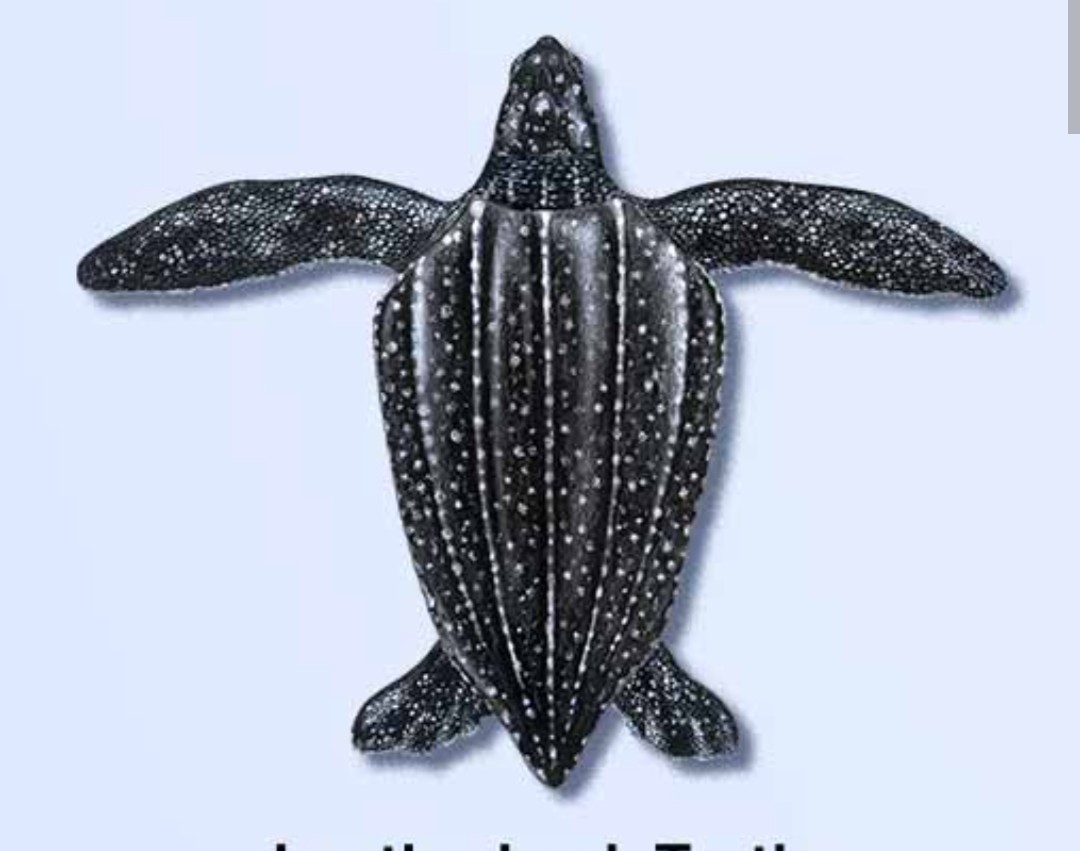
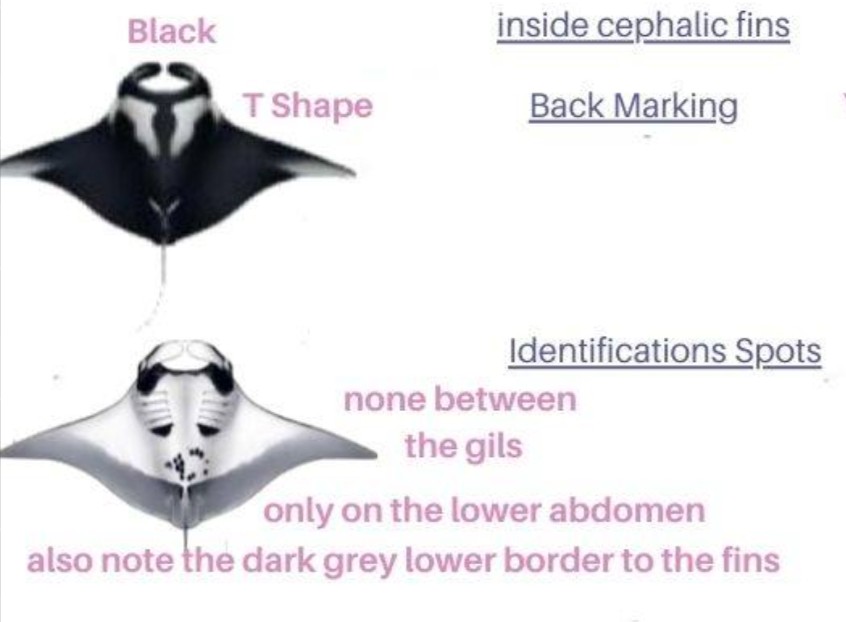
Mobulidae family
primarily consume zooplankton such as copepods, euphausiids, and mysid shrimp, but also eat small and moderately sized fish.
massive diamond-shaped bodies and long, wing-like side fins, thsi species is larger, and they have a darker black-grayish topside with more dark on their underside and around the cephalic fins (the fins around thier large mouth)
Pelagic Manta Ray
Fun fact: they have the largest brain-to-body size ratio of any fish and are intelligent enough to recognize themselves in a mirror